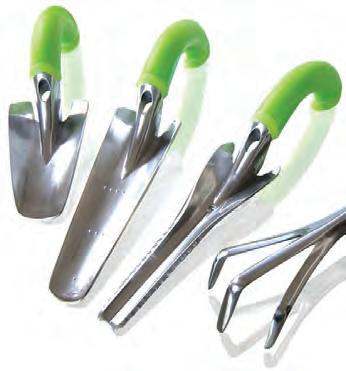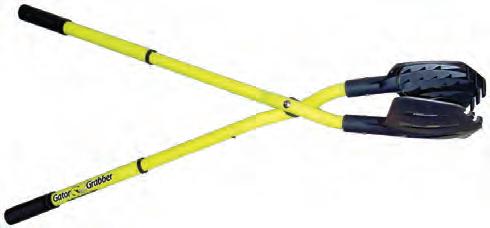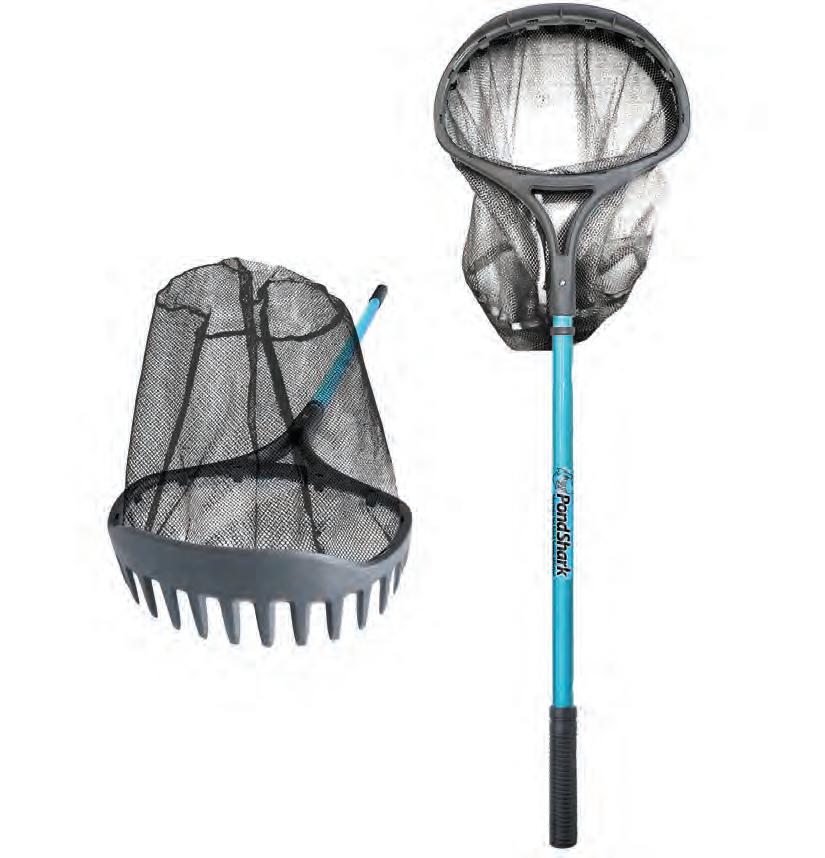



















National President
Medwyn Williams MBE AHRHS FNVS 01248 714851 e-mail: medwyn@llanor.fsnet.co.uk or medwynsofanglesey.co.uk
National Vice Chairman Vacant
General Secretary Vacant



Assistant Secretary
Mark Hall BEM FNVS 07768 290122
Treasurer
Robert Miller 0113 256 3619 m: 07932 380098 robertmiller768@btinternet.com
DVD Distribution Executive
Gordon Francis FNVS
Southern Branch Chairman 01622 710486 gordonjfrancis@googlemail.com

Chairman of the Judges Examination Board
Jim Williams FNVS 01875 320644 jimtwilliams@yahoo.co.uk Also Newsletter editor of the Scottish Branch Membership Registrar Branches

Neil Hope FNVS 01932 844183 neil_hope@hotmail.com

David Metcalfe
David Metcalfe FNVS, Chairman, Northern Branch 01282 614429 davidforleeks@gmail.com

National Chairman
David Allison FNVS 01943 862106 e-mail: drallison@hotmail.co.uk








John Croot FNVS
Secretary Northern Branch 01773 834213 j.croot@btinternet.com
Arwyn Edwards
Vice Chairman, Welsh Branch 01267 253363 edwards.arwyn@gmail.com
John Branham, FNVS Midland Branch 01296 681307 johnbranham@btinternet.com
Sandra Hall, FNVS
Chairman Midland Branch 01952 541396
Ian Stocks FNVS
Chairman Scottish Branch 01324 821274
Ian.stocks@blueyonder.co.uk
Barry Newman FNVS Southern Branch 01403 711598
barry.newman@live.co.uk
Neil Muirhead Scottish Branch 01592 611396
neil.muirhead@blueyonder.co.uk
Ian Clemens
Chairman Southern Branch 01403 751676 ianclemens@tiscali.co.uk
Articles, notices, meetings etc relative to your Branch and DA should be sent to the sub-editors below.






Scottish Branch
Sub-Editor: Fiona Shenfield 01592 890284
e-mail: fcshome@talktalk.net
Northern Branch
Sub-Editor: Michael Osborn 01282 863351 e-mail: michael.osbron2@ntworld.com
Midland Branch
Sub-Editor: Mick Poultney FNVS 07815 630811
e-mail: mickypoultney@hotmail.com
Southern Branch
Sub-Editor: Peter Cranfield 01279 850511 e-mail: peter.cranfield@Care4free.net
Welsh Branch
Sub-Editor: Ivor Mace 01443 775531
e-mail: ivormace@hotmail.com
NVS Ireland
Editor: Michael Gordon 086871 3359
e-mail: m_gordon100@hotmail.com and finally, myself…
National
Magazine Editor
Kelvin Mason
Amasca, 7 Fifehead Cottages, Salisbury Lane, Middle Wallop, Stockbridge, Hampshire, SO20 8JN Tel: 01264 781684

E-mail: Kelvin.mason@sparsholt.ac.uk …to whom all articles for inclusion in the magazine should be sent. October 2016 edition – deadline for submissions to Kelvin: 12th August 2016 simplyvegetables 3
Competition terms and conditions
Competitions are open to all UK residents aged 18 or over, excluding employees or agents of the associated publishing company and their families. One entry per person. The prizes and giveaways are as specified on the relevant pages. No cash alternatives. Entries must be via post or email as stated (no purchase necessary). Illegible entries and those that do not abide by these terms and conditions will be disqualified. No responsibility is held for entries lost, delayed or damaged in the post, proof of posting is not proof of delivery. Your details will be processed by Crest Publications (publishers of Simply Vegetables magazine on behalf of the NVS) in full accordance with data protection. Crest Publications may wish to contact you with information of other services we provide which maybe of interest. Please indicate on your entry if you DO NOT wish to receive such information by post, phone or email. The decision of the judge is final and no correspondence will be entered into. Winners will be notified by phone, email or post, a list of winners is available on request from Crest Publications, 1 Rothwell Grange Court, Rothwell Road, Kettering, Northamptonshire NN16 8FB.


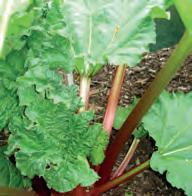

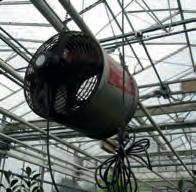
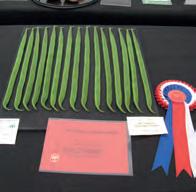
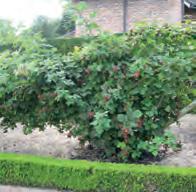
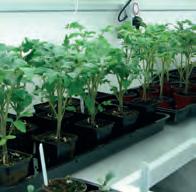
Everyone knows the pleasure of eating fruit and veg straight from your own allotment or vegetable patch.
Feeding makes all the difference, and this year there is a new feed to help you produce amazing results.
Baby Bio® Outdoor has a unique formulation containing biostimulants that helps plants take up and utilise the nutrients to the absolute max.
In just 7 days plants will have healthier, greener leaves and within 4 weeks plants will be bigger with stronger roots for better growth.
You’ll get up to 35% more fruit and veg with Baby Bio® Outdoor Fruit & Vegetables compared to feeding only with a standard NPK fertiliser.
It’s a liquid plant food, so it’s incredibly easy to use! Just pop 10 ml of Baby Bio® Outdoor per 1 litre of water and apply every two weeks.
Baby Bio® is a registered trademark of Bayer CropScience Limited.

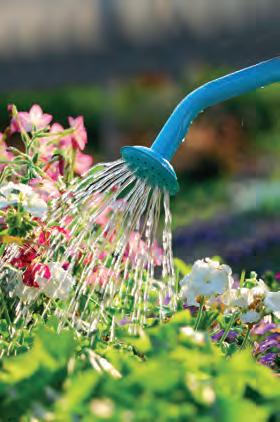
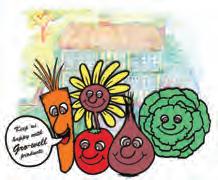

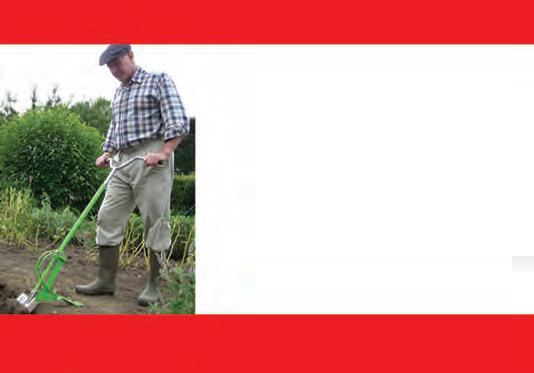



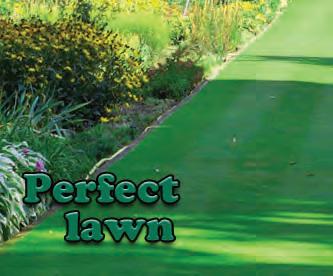

I start my few comments on a serious note. At the last Trustees meeting in April, our National Secretary, David Thornton tendered his resignation. He cited one of his reasons as a potential conflict of interest as he has just purchased Select Seeds. He has served the society well over the last 10 years and we wish him well in this new venture. However this leaves us with a problem. I have written to not only all Trustees and officers of the society, but all Branch Presidents and Life Vice-Presidents, asking for their support and guidance, as not only have we lost our secretary, but have had vacant positions for ViceChairman and a new post of Marketing, Media and PR role for over a year now, and next year myself as Chairman, and Robert our Treasurer will be standing down, having served our three years in office.
You will also see from Mark’s Report from the Trustees meeting in April that we have other significant issues to resolve, including website upgrade and finding suitable software to enable our National Membership officer Neil to maintain membership records more efficiently, both of which could cost significant sums of money. To that end Trustees decided that the new Directory which is now available, would only be published on the website and not in printed format, which would save a considerable sum in printing costs.
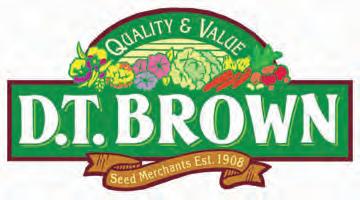

These issues will, of course, be discussed at the next Trustees meeting in July, but if any member has any thoughts or ideas on how we can move forward, please let either me or your Branch secretary know.
On a more positive note, I am delighted to advise that one of our major sponsors D.T. Brown have very kindly agreed to provide all members with a free packet of seeds, which you should find enclosed with this issue of your magazine.
This is one of the first mildew tolerant, hybrid non-bulbing, bunching onion varieties. Dark green, extremely reliable, upright and uniform. It’s so new it hasn’t got a name yet, just a code which is TSX 8516. You can either sow the seeds on receipt for a crop in the Autumn, or sow August to October to overwinter under protection.

D.T Brown tell us the following about its qualities;
SOW OUTDOORS February-July, thinly at two-weekly intervals for successional crops. Protect with cloches if soil is cold and wet Depth
D.T. Brown have very kindly agreed to provide all members with a free packet of seeds
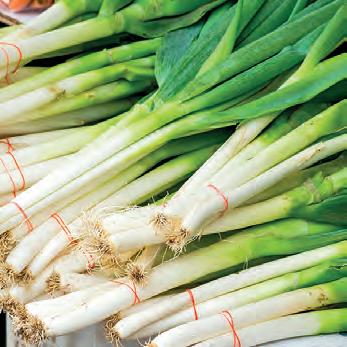

Half-inch/1.5cm Spacing In rows 6in/15cm apart Thin out As necessary, should not be needed if sown thinly. Keep well watered and weed free. Can be overwintered with protection for harvesting when required. Harvest MayOctober. August to October sowings will be ready the following spring. Approx 150 seeds per packet.
I trust you all have sown your free seeds of Tomato “Montello”, sent out with the Spring issue of Simply Veg, and for which there is a class at the Midland Branch Championships at Malvern, with significant Prize money sponsored by Marshalls Seeds.
We are indeed very fortunate in having two major seed houses support us in this way, do give them your patronage if possible.
Back to gardening; after an unbelievably wet and mild winter in this part of the country, we have had some decent weather recently, so its all go on the allotment as I write these notes in mid May. Rhubarb is cropping well, presumably taking advantage of all the
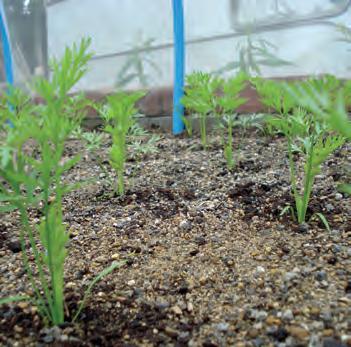
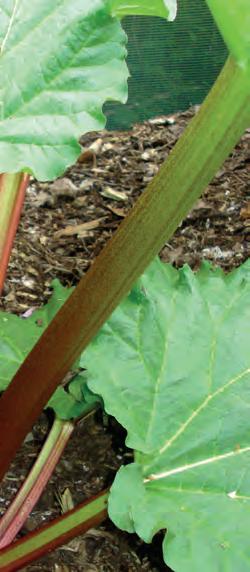

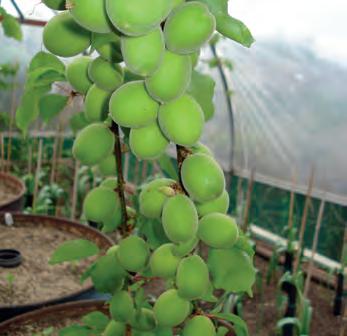
moisture still in the ground.
My parsnips and long carrots are looking good for this time of year, but its a long way to go to harvest time! My sweet candle short carrot seed has germinated very sporadically in a raised bed with quite a few misses, not sure what’s gone wrong here.
I think its going to be a good year for fruit, both top and soft fruit. My apricots, (Tomcot and Flavourcot) started to blossom on 26th Feb and were absolutely covered in blossom. This is far too early for this part of Northern England, the earliest I have ever known, but fortunately, they are under the protection of a tunnel, have set well and now carrying a good crop of fruit.
Apples outside are currently covered in blossom as I write these notes, so fingers crossed.
Pears and plums seem to have set well, but an early plum, Lizzy, was covered in blossom, outside in Feb., far too early for me and has succumbed to the recent cold nights. No crop this year.
Grapes in a cold greenhouse seem to have set well, looking forward to a good crop from these.
Enjoy your gardening, see you all at the National Botanic Garden of Wales, near Carmarthen for our National Championships and AGM, second week in September. Could be an interesting meeting!
David, Chairman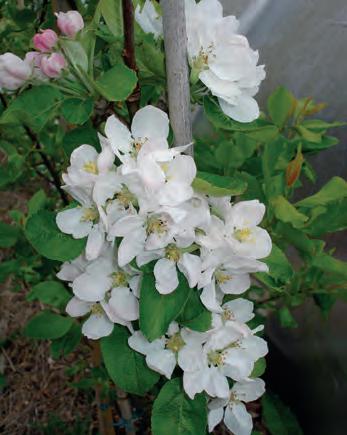
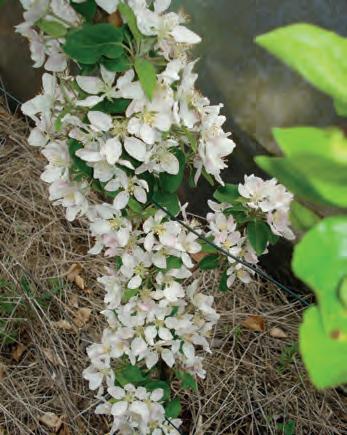

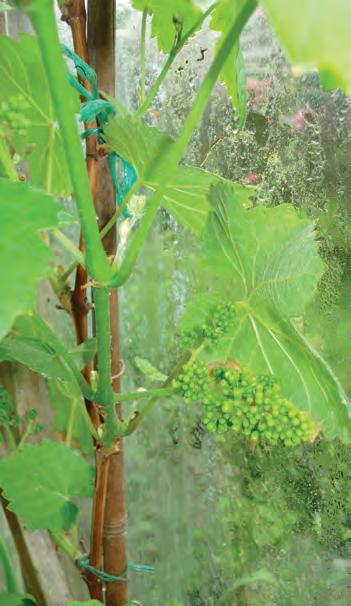

David Allison opened the meeting on the 23rd April and welcomed Ian Clemens, Chairman of the Southern Branch, Ivor Mace Welsh Branch representative and Emily Plumb Web master. It was noted the work that Gordon Francis had done over the years as outgoing chairman of the Southern Branch.
Emily Plumb reported that overall the website and forum are working well along with Face book and twitter, but it would be nice to see more use.
Emily has been working with Neil Hope looking at data packages to manage our membership, Trustees were concerned that this cost was too high, and that further investigation was needed before we can make a decision on this.
Emily has also been working with Sian Mace (Ivor Maces daughter) looking at other companies to host our website, who all say they would need to rebuild our website at a cost, apparently our site is not transferable from our present host. After some discussion trustees agreed that we need a business case lead by specification first before we could get the best value for money on a website host. Emily to progress.
Emily has received some complaints on the use of social media (offensive comments) the question is should we have a policy in place to cover this? Trustees agreed not to produce a policy at the present time, and would give Emily the authority to remove and/or block any persons or such activities.
Robert Miller had circulated details on the accounts prior to the meeting. The consolidated accounts have been signed and should be back from the auditors very soon. The Budget for 2016 was discussed in detail by the trustees and the following agreed. The new directory would not be printed but would go onto the web site for members to download and print off, this would make significant savings in the budget forecast. Trustees agreed to the reprinting of some of the out of stock “getting started books” along with a new book to add to the series. It was also noted that stocks of pens and note books needed to be re-ordered. Robert to send out amended Budget, with recommendations on capitation levels, and membership fees.
David Thornton has had lots of request for the new measuring gauge, noted that the old shallot ring is no longer available, but can still be used a long side the new 30mm measuring gauge. Apart from
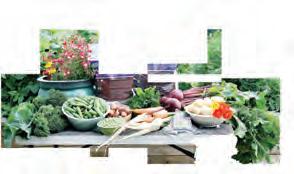
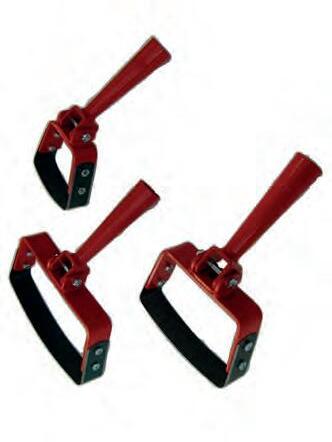

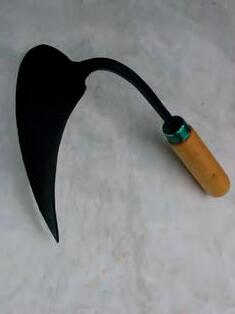
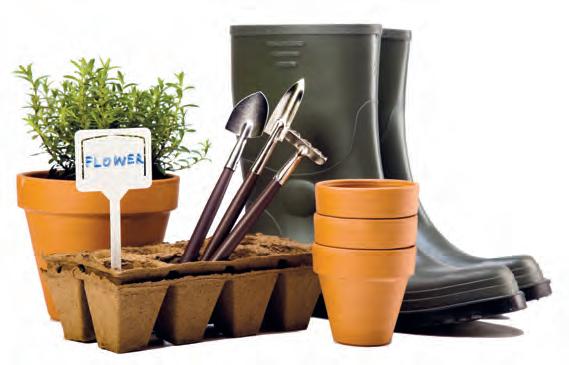
the 30mm ring all other rings on the gauge should be used as a guide line.
Neil Hope had sent out copies of his report prior to the meeting, membership remains stable at the moment, it was noted that some complementary memberships had been funded by the Scottish branch in the form of students studying in horticulture.
Names of new members, are being forwarded to Marshalls and DT Brown to claim their free seeds etc., it was also noted we now have more new members giving us email address which is helpfull.
Mark Hall went through the paper that Hannah Lloyd had produced following the last trustees meeting in January, this had been circulated to trustees prior to the meeting. He highlighted the weaknesses within our society of which he felt we should be working on. After some discussion trustees agreed to accept the vision and mission statements, with in the report and now use them in all relevant society publications including the web site.
Trustees noted that the results from the last judge’s exam took some time to be published last year. Trustees discussed the matter and agree to leave any decision until the next meeting when the judge’s panel would supply information to review this process further.
Barry Newman had circulated a paper on the judge’s guide prior to this meeting. A letter on this subject had also been received from our president. The RHS judges guide is very close to that of the NVS guide, there are only six vegetables that have different point’s values to ours. Trustees debated whether to adopt the RHS hand book fully, or update and expand our guide to give even more information to judges/exhibitors which may include using photos. It was agreed that Ian Clemens, Barry Newman and Ivor Mace look into updating our guide.
Arwyn Edwards had tabled a paper prior to the meeting setting out figures for funding the national championships, at the moment each branch pays £500.00 per year to fund the championships fund resulting in 2.k being available each year to assist the hosting branch in running the championships. However this figure does not take into account the number of members each branch has. If based on the number of members each branch has, some branches will pay more than £500.00 per year others less, after discussion it was agreed that all branches should review this at their forthcoming branch meeting, this would enable the trustees to debate the matter further at the next trustees meeting.
David Thornton pointed out that this was his last trustees meeting having tendered his resignation to the chairman earlier in the week, he will continue with his duties until a new appointment is made. He felt having recently acquired a seed company there may be a conflict of interest.
Mr, Mrs Ms, Miss (name)
Address
Postcode
Telephone
Membership No if renewal:
email:
Please accept my application for membership of the National Vegetable Society for the period ending 31st December 2017 I enclose a cheque/postal order/standing order for £ ……………
Payable to The National Vegetable Society New members please complete and return to: Mr Neil Hope FNVS, 11 Sumner Place, Addlestone, Surrey, KT15 1QD Tel: 01932 844183, Email: neil_hope@hotmail.com
If renewal, please send to the relevant Branch Membership Secretary as listed on the right MEMBERSHIP FEES
Juniors (up to 16yrs)
£ 5 00 Affiliated Society £19 00
Individuals £17 00 Educational Establishments £15 00
Couples £19 00 Society Medal & Card £ 7 60
If you are joining after the end of May, there is now an option to pay £23.50 (individuals) or £26.50 (societies and couples) for this year and all of next year (2017). Application and payment can be made via the NVS website www.nvsuk.org.uk under the “join the NVS” section, where there is a renewal form for existing members as well.
Name of Charity: THE NATIONAL VEGETABLE SOCIETY REGISTERED CHARITY NUMBER 1088979
Details of donor:
Title: Forename(s):
Surname:
Address:
Postcode:
Telephone:
Email: ......................................................................
I want the charity to treat (delete as appropriate)
• my annual subscription
• the enclosed donation of £ ………………
• all donations I have made since 22nd October 2001, and all donations I make from the date of this declaration until I notify you otherwise. as Gift Aid donations.
Signed: ………………………………………………
Date: …………………………………………………
DVD TITLE Qty Req’d
On the Allotment With Stella & Peter
Growing Exhibition Potatoes
With Sherie Plumb FNVS
Growing Exhibition Tomatoes With Charles Maisey FNVS
Growing Exhibition Shallots With Graeme Watson FNVS
Growing Potatoes With Alistair Grey FNVS

MIDLANDS
Trevor Last, FNVS, Tel: 01603 868316
43 Carters Road, Drayton, Norwich, Norfolk, NR8 6DY e-mail: trevlast@tiscali.co.uk

NORTHERN
Mrs Sheila Lewins, Tel: 01244 674609
39 St Marks Road, Saltney, Chester, Cheshire, CH4 8DE e-mail: Sheila_tom@hotmail.co.uk
SCOTTISH
Fred Stewart FNVS Tel: 01224 781309
Penny Lane, Redmyres, Portlethen, Aberdeenshire AB12 4RR
Your Name:
Your Address:
Postcode:
Telephone No:
Membership No:
Date:
Post Completed Order to:
Mr G J Francis FNVS, 147 Bull Lane, Eccles, Aylesford, Kent, ME20 7HW Tel: 01622 710486
Email: gordonjfrancis@googlemail.com
Growing Exhibition Carrots With Graeme Watson FNVS
Growing Exhibition Onions With Jim Williams FNVS
Growing Exhibition Celery With Trevor Last FNVS
Growing Exhibition Blanch
Leeks With John Soulsby
Growing Exhibition Pot Leeks With John Soulsby
An Insight into Vegetable Showing With Trevor Last FNVS
Compost Making with Mick Poultney and 2011 National Championships
NEW – Growing Exhibition Leeks and Onions with Ivor Mace
Growing for Showing 2006 With T Last, John Branham & Gareth Cameron
NVS National Show 2007 Malvern
National Championships Dundee 2005
National Championships Pembroke 2006
Trio of Shows 2005
TOTAL NUMBER OF DVDs Ordered
Cheque Payable National Vegetable Society Enclosed for AMOUNT £

SOUTHERN.
Neil Hope, FNVS, Tel: 01932 844183
11 Sumner Place, Addlestone, Surrey, KT15 1QD e-mail: neil_hope@hotmail.com

WELSH
Mrs Mary Thomas, FNVS Tel: 01691 780420
Fron, LLanrhaeadr, Y.M. Powys, SY10 0JJ e-mail: maryfron2005@yahoo.co.uk

In
the last Simply Vegetables I mentioned my winter lettuce crop
had been
a disaster
and that I was blaming
the compost.
In the end I managed to produce eleven good lettuce not what I would have liked but better than nothing.
To make use of the remaining soil border I planted some broad beans. These plants were acquired as they had been used for sowing practical’s with students and were to be thrown away once they had germinated. As the seed was only to be used for the sowing practice the cultivars were mixed and some were not of the normal overwintering type. They were sown in a heated greenhouse and grown on to approx. 10 to 15cm height I then brought them home and planted them into an unheated greenhouse in late November.
At first they struggled and the summer type looked very unhappy for most of the winter despite the fact that it was not very cold over last winter; in fact I lost about 20% of these plants. The Aquadulce type (normally used for overwintering) looked happier apart from suffering an attack from Chocolate Spot disease. It was not until late March that the plants began to improve
and now look like they will give a good crop about three to four weeks earlier than my outdoor plants. In fact I picked my first beans on the 13th May as I am putting the final touches to this magazine. It will now become a bit of a race for the pods to mature and to pick the beans before I can plant my tomatoes. I am holding the tomatoes in 15cm pots but they are ready to plant now. At least I should get a crop off the border which would have been empty owing to the poor lettuce plants.
The Aquadulce type looked happier apart from suffering an attack from Chocolate Spot disease
I mentioned above and in the last magazine how mild it was last winter and here in the southern end of the U.K we had the coldest weather during March and into early April. This has seemed to slow plant growth down and has certainly delayed seed germination and growth with many of my March outdoor sowings only germinating in late April early May.
I thought that after the bumper apple crop last year and the mild winter the flower count would be lower as the plants recovered and

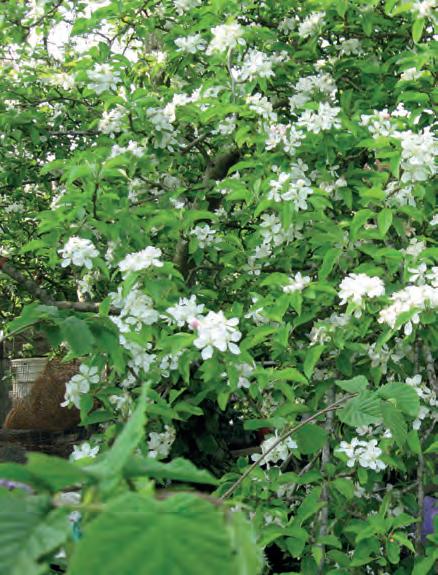
built up reserves but most of my trees have a high number of blooms which hopefully will be pollinated and lead to another good crop. Providing there is not a big June drop I am hopeful for another good crop.
A number of members have put pen to paper and sent in some very interesting letters for this issue which are well worth a read, so please don’t be shy and if you have anything interesting send in a letter.
Gerry Edwards continues his series on fruit covering one of the cane fruits, the blackberry; I know as Gerry says many of you possible go out to the hedgerows and pick your own, but growing your own is just as satisfying and the modern cultivars produce very large fruit making picking easier. Trained against a wall, fence, and trellis they take up little space and make use of what tends to be an underutilised area.
Collette Bissom has sent in two articles from Jersey showing that the Jersey branch is still thriving and busy. One article is about an unusual cabbage which I would have thought has some breeding potential for tall Sprouts! The other is their involvement with local schools which is something we should encourage if only to ensure members for future years ignoring all the other benefits to the children and nation as a whole coming from better diets.
Gareth Cameron has written a very interesting article on pesticides which I feel members should have a look at and give serious consideration. Reducing the amount of chemicals we uses is a good thing but it is highly likely that the number of chemicals available is going to reduce in the future.
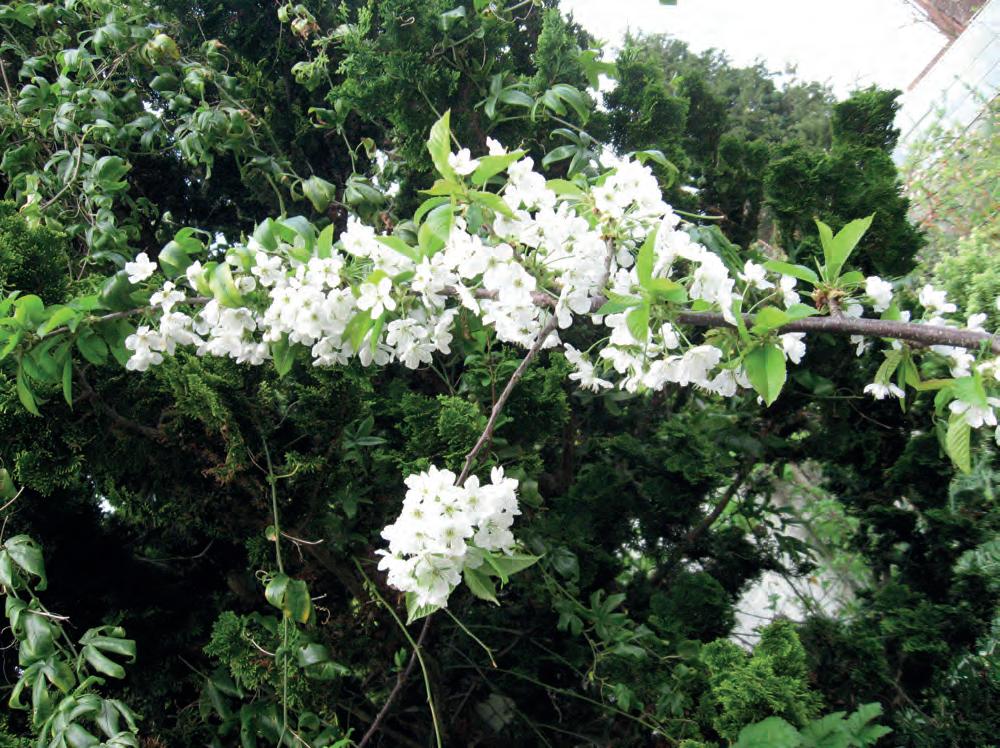

Members who like trialling new ideas should give it a go and let those of us who tend to follow know how it goes.
I continue my series on judging and in this issue look at the legume crops which are important on the show bench particularly in the mid to late summer shows. Also the Getting Started in the Greenhouse part 3 is in this issue. I have mainly covered heating which the keener growers tend to have so that they can start the champion vegetables off early to get the size and quality required to win at shows. Other keener members may have heating for early crops or just like to make full use of the greenhouse all the year round. I suspect less amateur growers use heat these days compared to years ago owing to the cost of the various fuels which are unlikely to drop in price (even petrol and diesel are going back up in price now!)
Derek Brooks covers the pea moth in this issue as well as the seasonal work up to October which should keep most of you busy along with a bit of showing and judging!
good summer which we may get more often if climate change is going to happen as the scientists are predicting. The article is in two parts the first part for treating areas of soil like gardens and allotments and the second part for treating soil for potting or sowing composts. Although I have to admit the treating of large areas of soil is a bit hit and miss in the U.K the treating of soil for sowing / potting composts I feel is well worth a try.
There are times when I can be too smart fort my own good!
I have included in this issue an article on soil solarisation which may be new to many members but which I think may be worth a try, particularly if your soil suffers from soil borne diseases (like clubroot), soil borne pests or you have recently taken over a weedy patch or allotment. As I mention in the article it is not guaranteed to work in the U.K but I feel it is worth a try especially if we get a
Which very neatly brings me onto my next point, as members may remember I had a bit of a rant in the last issue about peat free composts which I referred to at the start of these comments (one of my regular moans!) and just to support my point will comment further. During February I sowed some lettuce seed in some old compost at work, along with a number of other seeds, although germination was good many of them damped off despite the fact they were growing in ideal conditions (good temperature, consistent heat and good light). Following some enquires I found out it was old compost that had been stored outdoors in a yard which had partly flooded, this I believe had contaminated the compost with the various disease spores of damping off disease. Thinking I would be clever and knowing that the remaining seed compost was from the same source I decided to re-sow the lettuce and some of the other crops in potting compost which I knew was new, this year’s compost and was clean.
There are times when I can be too smart fort my own good! Germination was good and reasonable quick and I thought I would prick them out the following week. When I went to check the plants were ready as you can see from the photographs all was not


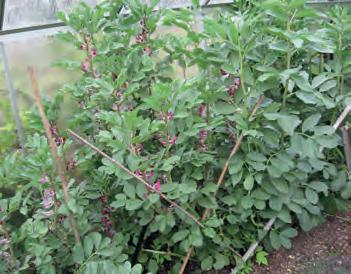
well, most if not all of the plants were brown or going brown and it was not damping off disease. The symptoms appear to me to be scorch from too high a nutrient level in the compost, although I have not had it analysed to check this is the case. Some of the more experienced members may be thinking well what do you expect by sowing into potting compost especially lettuce which do not like a high salt level in the first place, which I was prepared to accept until I looked at the tomato plants in the same compost (potted up on the day I sowed the lettuce); these are also showing signs of nutrient toxicity and tomatoes like a high level of nutrients. Which finally brings me to my point, the potting compost was a peat free mix which we have recently moved to (a good quality one I should add, but I will not name it as libel can be an expensive exercise which neither I or the NVS could afford!). It is my opinion that the compost was either poorly mixed and the fertiliser not properly incorporated or more likely one of the ingredients released additional nutrients once it was used and these proved toxic to the plants. I have yet to be convinced that peat free composts are the way to go at present; possible in four or five years’ time after more research and experimentation work. I know the horticultural research body have just built some new facilities just to experiment with growing in peat free and other alternative composts as many growers have not yet moved to them owing there inconsistent performance.
I have yet to be convinced that peat free composts are the way to go at present
need be) to allow it to dry a little and then mix with peat, grit and the required amount of fertiliser to produce the correct recipe of John Innes sowing,1 or 2. I think the use of soil solarisation for the use in making John Innes composts is seriously worth a try and if I get time will give it a go; at least it stops me ranting about the peat free composts!
As our Chairman has mentioned in his thoughts David Thornton has resigned from the Trustees as he is purchasing a seed company (see article later in the magazine) which will take up much of his time. I have only known David for a couple of years since I started to attend the trustees meetings and he is a very efficient operator and has been a great asset to the NVS in his ten years as Secretary. I think he will be a great loss and definitely a hard act to follow, having said that don’t let me put you off from applying for the post as we need a replacement. I wish him the best of luck with his new enterprise and I am sure he will keep in close contact with the NVS and will no doubt continue to exhibit. Once he has settled into his new company I hope to persuade him to do an article about the company and some of the seeds he will be supplying.
I think David Thornton will be a great loss and definitely a hard act to follow
Going back to the soil solarisation I mentioned above, many years ago I used to make my own John Innes Composts (well my pocket money was never that good!). I adapted an old heater and barrel in which I heated some water and as the steam rose it passed through the soil and steam sterilised it. I would then spread it out onto a clean concrete surface (sterilise with boiling water if
Those of you who are observant will have noticed that some of the sub editors have changed and I would like to thank the previous sub editors for their help in compiling the magazines over the last few years. Also to welcome the new sub editors, their contact details are on page 3 so if you have any branch news please send it to them, I am sure they will be grateful to receive it certainly I will!
Finally the college I am based at has an open day in mid-May so I decided to grow some early vegetables in an unused polytunnel as a demonstration. I made the decision a bit late but aimed to have crops ready to pick for the 23rd May from a


January sowing / planting. I wanted crops that would be ready to eat and would not require too much attention as I would not have a lot of time available. I decided that early potatoes, lettuce, broad beans, peas and radish would be suitable and I would sow some carrots, beetroot and salad leaves to follow on.
Some raised beds were constructed from some second hand and surplus wood approx. 45cm deep and 1.2 metre wide the length of the tunnel and two 1 metre cube bags filled to grow vegetables in as large containers. They were all filled with composted green waste from the college grounds to keep the cost down. They were allowed to settle for a week and for the compost to warm up.
The potatoes were started off in a greenhouse in 2 litre pots and the peas sown into seed compost in lengths of guttering in mid-February at a temperature of about 15˚C. to help make up for lost time. The broad beans had been sown the previous December and grown in an unheated poly tunnel. The lettuce were sown into trays in February and pricked out into modules in early March and again grown in the unheated polytunnel.
The radish, beetroot and carrots were sown directly into the compost at the end of March with a hope that they would be nearly ready for harvesting at the end of May.
As little time was available for maintenance an automatic trickle irrigation system was set up and the doors left open most of the time to prevent the temperature getting too high. With hind sight it may have been better to have kept the doors shut on most days during April as it proved to be a cold month and germination and growth of the seedlings was very slow. It would also have speeded up the growth of the potatoes a little as well.
Apart from one weeding and a bit of supplementary watering no other work was carried out. As can be seen from the photographs reasonable crops have been produced. How was the timing, well not as
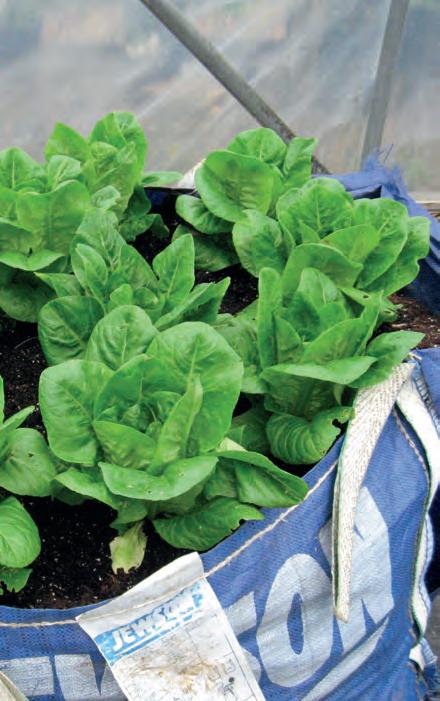
good as I would have liked but close and next year with an earlier start should be able to hit the date. The lettuces were spot on and looked good on the day, the peas had produced a good crop of pods but were not mature for picking and will be about 2 weeks late. The potatoes also need another couple of weeks to produce a reasonable crop as they were at large marble size. The broad beans were in flower and some very small pods but not as advanced as the ones in my greenhouse. The radishes have produced plenty of leaves but little root and I should have chosen a different cultivar (the seed was free hence using the one I did!). The carrots had a poor germination and have been slow growing; I may sow them in the autumn in future to ensure they are ready. The beetroot germination was good and growth reasonable but they will not be ready for another month and should have been sown earlier.
It has been an interesting exercise as I have not grown early vegetables in a poly tunnel before and with a bit of better planning should be possible to have good crops ready for mid to late May; the so called hungry gap period. Now that the beds have been built I can sow and plant earlier for next year.
That completes my comments for this issue, more like David’s ramblings (the previous editors title for the benefit of newer members) you may think.
At the last trustees meeting in April it was decided not to publish the directory in paper form this year to help reduce expenditure. It will be available on the society’s website for members or if you wish to have a copy please contact the National Secretary.

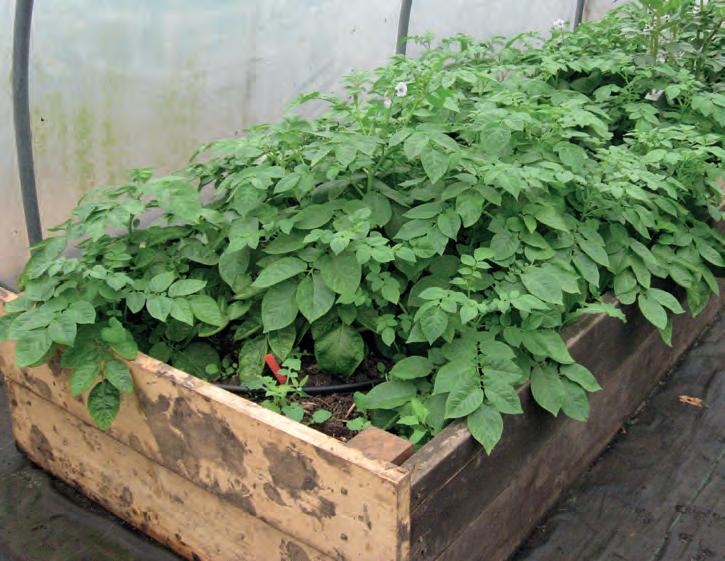
In the last issue of Simply Vegetables there was an article and advertisement for the new judging rings which are still available from your branch secretary. These will be particularly useful to new judges and are well worth buying.
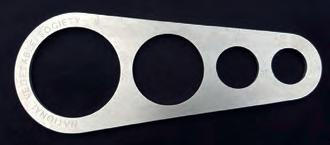
The old 30mm rings that the society have supplied for a number of years can still be used as they comply with the 30mm size for pickling shallots. So if you have one of these rings please continue to use them.
The newer rings have the 30mm size and other sizes as well which can be useful to the judge. The 30mm size is a mandatory size for shallots; the other sizes are a guide (optimal) for various fruit and vegetables.


200g/8ozs carrots
200g/8ozs courgettes
25g/1ozs sultanas
25g/1ozs roasted cashew or peanuts
Dressing
1 small clove of garlic – crushed
1tbs virgin olive oil
1 tbs white wine or cider vinegar
3 tbs freshly squeezed orange juice
Few snipped chives or chopped parsley to finish.
1. Prepare the dressing by putting all the ingredients in a tight lidded jar and shake vigorously.
2. Wash and scrub the carrots, wipe the courgettes and top and tail both.
3. Coarsely grate both and put in a large bowl. Very young courgettes may need draining first.
4. Add sultanas and nuts.
5. Add dressing and stir to combine.
6. Put in a serving dish and gar nish with the chives or parsley.
In winter, this is equally good made with celeriac instead of courgettes for an equally nutritious salad.

Olive oil aids the absorption of carotenoids from the carrots, thus maximising the eyesight benefit.
Herbs aid digestion and orange juice adds to the Vitamin C content to prevent colds and flu.
4 large Aubergines
2lbs tomatoes, preferably beef tomatoes or 1½ cups slow roasted tomato puree
1 large onion
Few sprigs of Oregano
2 cloves garlic
Basil leaves
3oz strong Cheddar cheese grated 200ml carton of crème fraiche
Chop onion finely, fry until beginning to brown. Add chopped garlic. Skin and chop tomatoes, add to pan or use slow roasted puree. Add oregano leaves. Simmer uncovered for about 10 minutes to reduce. (2-3 mins) if using puree. Add a little salt and pepper.
Cut the aubergines into slices, brush with oil, put under a hot grill for about 3 minutes on each side. Cover the bottom of a Lasagne dish with aubergine slices.

Spread over half the tomato sauce. Lay basil leaves on top. Sprinkle over a little grated cheddar. Repeat the layers ending with aubergine. Spread over crème fraiche then grated cheese.
Bake for about half hour at 180˚C. Leave to stand for 10 minutes before serving. This amount will be enough to serve six. It is good re-heated the following day, and it freezes well.
To make slow roasted tomato puree, put tomatoes on a tray, sprinkle over a pinch of brown sugar, salt, pepper and a drizzle of good quality oil. Roast at 100˚C for 1.5 hours. Process in a liquidizer and sieve to remove seeds and skin. When you have a glut of tomatoes this is a good way to freeze them.

3 Aubergines
1 small red onion finely chopped
1 small red or yellow pepper finely chopped
Juice of half a lemon
2 cloves of garlic chopped
4 tablespoons of Greek yoghurt
4 tablespoons extra virgin olive oil.
Pinch of sugar
1 teaspoon ground coriander
1 teaspoon ground cumin seed
Salt and pepper.
Trim off the stalks and cut the Aubergines in half lengthwise and put on a baking tray cut side up. Roast in oven at 180 C for 30 minutes until flesh is tender.
Fry the onion in a little of the olive oil until beginning to brown. Add the pepper continue frying on low

10 minutes. Add the coriander and Cumin. (Optional) When the Aubergine has cooled a little take of the skin and chop the flesh roughly, put into the food processor, add garlic lemon juice, pinch of sugar, salt and pepper. Process for a few seconds; add the yoghurt, onion and peppers then process for another few seconds.
Finely add the oil in a steady stream while motor is running and continue processing until smooth.
75g/3ozs spinach (or mixed salad leaves)
About ¼ cucumber
Few cherry tomatoes
Radish
2 cooked beetroot (see tip)
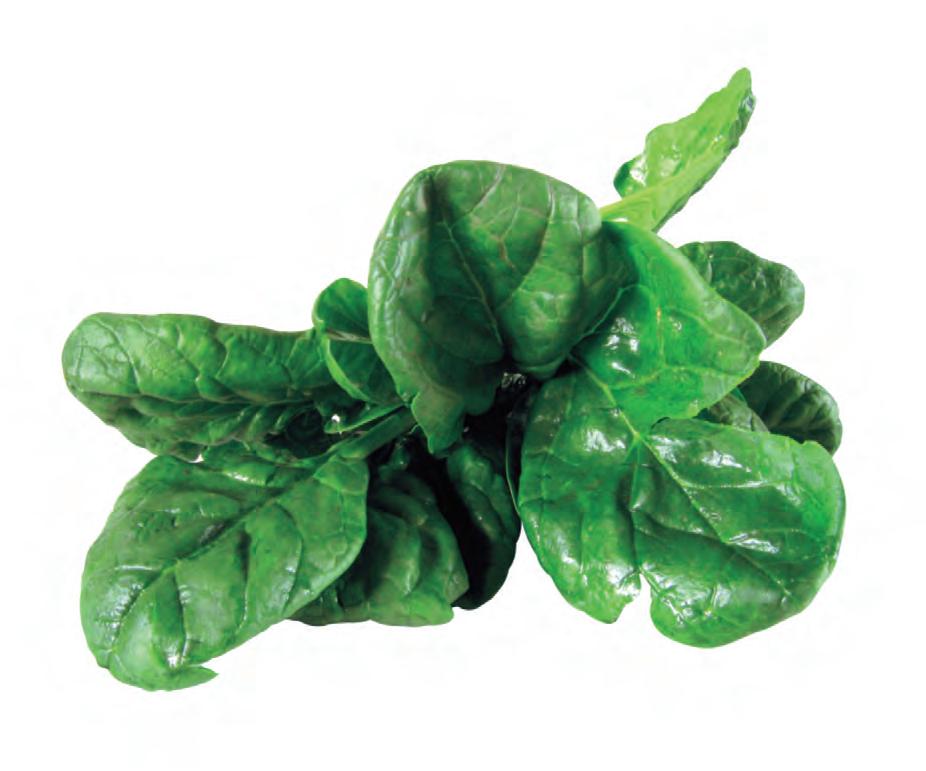
2 slices cooked ham
Dressing
3 tbs virgin olive oil (or walnut oil)
1 tbs red wine vinegar
1 tsp mustard (English or French)
½ - 1 tsp honey
Oven bake the beetroot to retain more nutrients and to avoid ‘bleeding’. Use thick foil and wrap into a loose parcel. Put on a baking sheet and bake at 180˚C for approx. 1 hour.
1. Wash the beetroot thoroughly leaving the root intact and trimming the foliage to within 2-3 cms. Cook the beetroot in their skin for about an hour. Leave to cool until cool enough to handle.
2. Wash the leaves and pat dry in a clean tea towel. Discard any thick stalks and tear any large leaves to smaller pieces. Arrange on a serving plate.
3. Thinly slice the cucumber and radish and arrange over the leaves.
4. Add the halved cherry tomatoes.
5. Rub the skins off the beetroot and cut into ¼ or according to size.
6. Cut the ham into narrow strips and arrange all on the plate.
7. Drizzle the dressing evenly over the whole salad.

Green Garden Hoop Tunnels with a choice of covers
Our green garden hoops are flexible, easy to install and have changeable covers. If the hoops are erected 1.2m (4’) wide they will stand approx. 600mm (2’) high. Buy the kits or create your own tunnels.
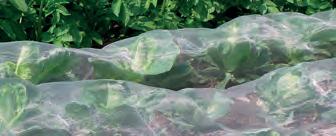
Veggiemesh
Protect Your Crops From Insects
Veggiemesh® is a fine mesh netting for protecting vegetable & soft fruit crops from insect pests, rabbits and birds. Mesh size of 1.35mm. Allows water light and air through.
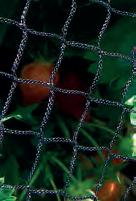
Bird/Fruit Netting Stop Birds Damaging Your Fruit & Veg.
Protect your fruit and vegetables from birds whilst allowing bees through to pollinate. An extremely versatile netting, can be laid over crops, cages or hoops. 17mm holes.

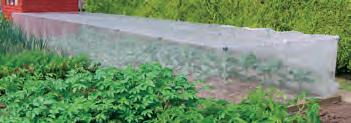
Garden Cages
Protect your fruit & vegetables from a wide range of pests. 1000’s of sizes & netting options to choose from or contact us for a bespoke size.

SLUGGO Slug & Snail Killer
Organic, long-lasting, effective slug control. Works by attracting slugs away from the plant. Once ingested, they cease feeding immediately and disappear underground to die. Certified organic by the Organic Farmers & Growers Association, the only slug pellet which has been awarded the Ecocert logo.
For a free catalogue please visit the website or call 01285 760 505
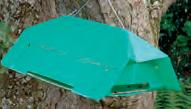
Codling Moth Traps
Protect your apples and pears from maggots. This trap uses the pheromone scent of the female moth to attract & catch male moths.
Slug Nematodes

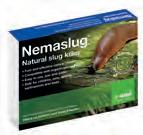
Slugs are a gardener’s worst nightmare. Impossible to get rid of once and for all, it is a constant battle to keep them under control. Slug nematodes are microscopic transparent worms which feed & multiply inside the slug. Completely safe for children, pets & wildlife. Infected slugs stops feeding within 3/5 days.
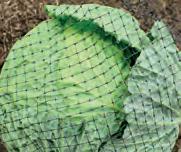
Butterfly Protection Netting
Stop Birds & Cabbage White Butterflies. 7mm square netting to stop cabbage white butterflies & birds attacking your vegetables. can be laid over crops, cages or hoops.
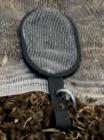
Crop Cover Clips
Stop damage to netting and fleece with these fantasic clips. Designed to clip onto any garden fabric and create an eyelet, which is then secured with a steel peg.
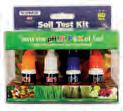
Soil Testing Kit
Knowing your soil conditons are a must for healthy crops. Get accurate results for pH, nitrogen, phosphorous and potassium.
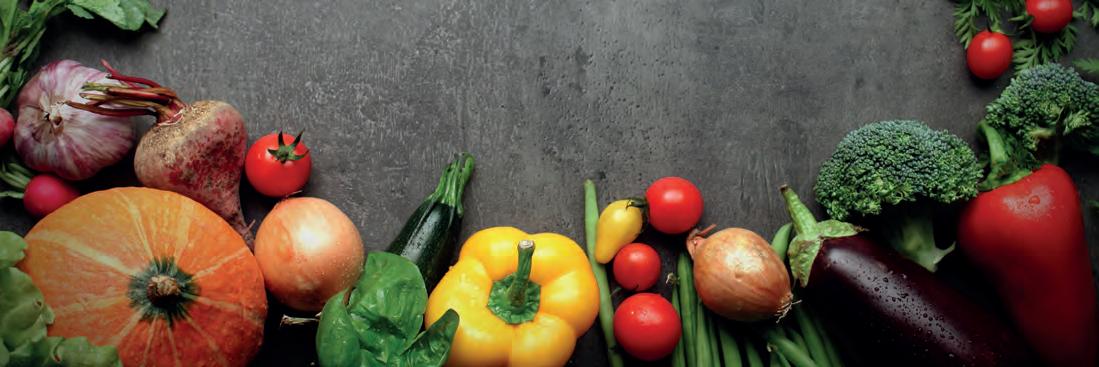
The following email was sent in by Derek Brooks one of our regular contributors.
Hi Kelvin
In your article in the January S.V. magazine about judging onions I noticed that you refer to a class for “Under 250 grams”. Medwyn Williams in his articles in Garden News has referred many a time to “Under 250 gram onions”. I can’t understand why this happens because there is no such class. Both the N.V.S. Judges Guide and the R.H.S Show Handbook refer to this class as “250 grams or under”. In other words “Not over 250 grams”. There is a difference between “under” and “not over”. The R.H.S. Handbook calls the large onion class “Over 250 grams”. If the small onion class was called “Under 250 grams”, an onion exactly 250 grams would not do for either class. I hope you don’t mind me mentioning this and I hope you understand my point. Best wishes, Derek Brooks
I should have proof read and thought through what I had written more carefully and stand corrected! I am in good company though if Medwyn does it! As my excuse and possible the point Medwyn is trying to make is that you need to get the weight right and the 250 gms point is critical otherwise it is easy to get a NAS at a show.
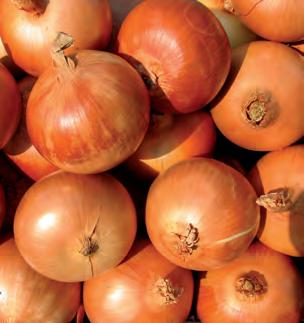 Letter John Evans
Letter John Evans
Greetings to all the members of our society at the start of a new growing season in 2016. It was most rewarding to receive the April edition of Simply Vegetables magazine full of knowledge about horticultural issues and vegetable growing which I believe is most informative for the amateur and exhibition grower of vegetables and fruit.
I would like to compliment and thank all members who have contributed to these excellent articles which will greatly assist and promote the National Vegetable Society in its endeavours in the seasons ahead. Over the past twelve months and present issues of the quarterly magazine the society has a wealth of excellent, knowledgeable contributors from the membership who can write and pass on their horticultural experiences in a most educational and relaxed manner to all who grow vegetables and fruit.
Many members are now contributing to the magazine and I hope they will continue with their endeavours and guidance in the seasons to come. The new season brings many high points and 2016 recalls the 400th anniversary of the death of England’s greatest wordsmith William Shakespeare who contributed greatly to our arts and literature. It is said they gardened during the Elizabethan period and reading some of his works and sonnets wrote about various plants and vegetables during this noted period. His works certainly contained knowledge about the gardens with references to fruit, vegetables and herbs and I refer to the quotes shown here with interest.
Happy gardening in 2016 with success.
John Evans
Taming of the shrew - Parsley Blondello – “I knew a wench married in an afternoon as she went to the garden for parsley to stuff a rabbit”.
Macbeth – Rhubarb
Macbeth – “Pull ‘t off, I say.—. What rhubarb, senna, or what purgative drug. Would scour these English hence?”
The Merry Wives of Windsor – cabbage Evans – Sir John “good worts”, Falstaff “good worts” meaning good cabbage.
From its beginning to its end, The Merry Wives of Windsor names five different garden vegetables – cabbage, pumpkins, carrots, turnips, and potatoes.
Antony and Cleopatra - Fig
Soothsayer “You shall outlive the lady whom you serve. Charmian “O excellent! I love long life better than figs”.

Henry IV - The apple Falstaff “I am withered like an old apple John” Henry IV – Camomile Falstaff “for through the camomile, the more it is trodden on the faster it grows, yet growth, the more it is wasted the sooner it wears”
A midsummer night’s dream –Mulberry
“be kind and courteous to this gentleman - feed him with apricots and dewberries, with purple grapes, green figs and mulberries”
Winning entries of the survey that featured in Simply Vegetables issue 4 are:
L J Evans FNVS, Gwent
Mrs C Wheeler, Reading
Mr & Mrs R G Heigham, Gloucs D Hewitson, Dorset
All of which will have received a £20 voucher from Kings Seeds.
This is a call out to any of you who may know any amateur or hobby breeders who have a particular area of interest (and hopefully some success!) in breeding their specialist plant. They can be at any stage with this as long as there is some information and plant material which could be followed up.
We have a possible project in very early stages as part of the Plants for the Future initiative which may lead to a feature and also help promote the initiative.
If you could forward this onto any interested parties, to get in touch with me directly, that would be very much appreciated.
Kind regards Vanessa Penn
Partnership Coordinator Tel: 01483 226522 vanessapenn@rhs.org.uk
Hi Kelvin
I do have a suggestion as to where the club root came from, bought-in potting compost.
On my allotment I used heavy applications of lime and eliminated club root after several years.
Until 2010 I used a peat based compost to raise brassica plants, all without any sign of club root. In 2011 the company was bought out and I noticed that the compost now contained “recycled materials”. Although many of the plants were free of club root, many were also seriously infected when I came to planting out. I suspect that at least one sack of compost was contaminated. The company claimed that none of their compost was contaminated with club root and suggested, among other things, that the club root was in the seed.
I no longer use that brand and have had no further problems. George Sutherland.
I also had a phone call from one of our members in Wales who manages to control clubroot using a slightly unusual method. He sows his Brassicas in a seedbed thinly but then lets them grow to about 30 to 45 cm tall when he lifts them carefully with a garden fork. He adds a spoonful of Domestos and Jeyes Fluid to a bucket of water and soaks the plants in this mixture overnight. The plants are then lined out the next day as normal ensuring they are planted firmly. He says they will grow into good plants even in clubroot infested soil and gets good firm sprouts. Another tip he gave was for avoiding cabbage white caterpillar damage to over wintering cauliflowers. He cuts off the leaves when the cauliflowers are planted so there is nothing for the butterfly to lay their eggs on and the leaves re-grow over winter without any problems with caterpillar damage. It sounds a bit drastic but he swore it works.
Using Perlka
I had club root in my garden similar to Ron’s description. All my brassicas struggled to make 50% of what they should have achieved. When I was at work we used to get ‘The Grower’ magazine. Over a decade ago there was an article written by Professor Dixon on club root control. Featured in the article was Perlka. I followed the recommendation on using Perlka but as the years have gone by I have altered my approach to using Perlka. I read that it has some sterilizing effect against resting spores of club root. So instead of using it only on the Brassica patch, I decided to use it on the whole vegetable patch every year. I have completely eradicated club root from my garden.
It certainly has increased the yields on crops like peas and beans, and the potato yield has risen to. The nitrogen in Perlka is slow release and I think this has helped because we are on 100+ inches of rainfall per year in the upper Rhondda Valley. I started off by using 2 parts Perlka, 2 parts superphosphate and 1 part sulphate of potash, but in recent years I’ve simplified my approach to 2 ounces per square yard of Perlka and 2oz per square yard Blood, Fish & Bone.
The Golden Rule
Perlka has a sterilising effect, so I am very careful to apply it two weeks before sowing seeds or planting out. During those two weeks we need to have rain, and if we don’t, then I would put the sprinkler on. Some members of the gardening club I belong to have actually killed some brassica plants after applying Perlka. So you really do need to be careful to let it have enough time to calm down before planting.
Lastly
I’ve seen small amounts of Perlka advertised at high prices on various websites. To use it as I do, you really need to buy a 25kg bag from a horticultural wholesaler. E.g. our gardening club bought some a few weeks ago for £19.50 + VAT per 25kg bag.
About Perlka
Perlka was made in Germany over 100 years ago by passing electricity through coal and limestone, which collects atmospheric nitrogen. So it’s nothing new, even though I only heard about it about 15 years ago. It is 50% calcium, 20% nitrogen.
https://en.wikipedia.org/wiki/Calcium_ cyanamide Ivor Mace
Those of you with good memories will recall that a year or so ago Len Sherring sent in a letter recommending Perlka for clubroot control which supports Ivor’s comments above. For those of you that have clubroot as a problem I would seriously look at giving Perlka a try and as Ivor say’s buy a 25kg bag. If it is stored in the dry it will keep a good couple of years.

This is the culprit when we find maggots in our peas. The pest itself is a small brown moth which lays its eggs on the flowers of the pea plants. The eggs soon hatch and the grubs (larvae) find their way into the developing pods and burrow into the peas. Here they feed for a few weeks by which time they are just over quarter of an inch long (6mm.), creamy white with a black head. The eggs are usually laid singly or at the most three at a time so it is unusual to find more than one grub in a pod. They are not usually present in sufficient numbers to seriously reduce the crop but they are still a nuisance. Also you can’t tell if a pod has a grub in it until you open it to extract the peas. If you exhibit your peas in your local show the judge always opens a pod to examine the peas inside. Its bad luck if he or she chooses a maggoty one-there won’t be a prize for you!
Prevention
How do we prevent this problem? It will help to look at the pest’s life cycle in more detail. When the grubs are fully grown, about August, they fall to the ground and pupate in the soil, protecting themselves in a cocoon and these overwinter in the soil. One thing we can do is to cultivate the soil thoroughly in winter which brings the cocoons to the surface to provide a feast for hungry birds. Another option is to plan sowing dates carefully and also choose certain cultivars. The moths emerge from their cocoons in early summer and mate. The females lay their eggs on plants that are in flower mostly during June and July. If we can arrange our
sowing so that our plants are in flower either before or after this period then we won’t have the problem.
Early cultivars like Early Onward, and Kelvedon Wonder (most suppliers), take 11 to 14 weeks from sowing to maturity. They can therefore be sown in March to crop in June, hopefully before the moths lay their eggs. It is advisable if sowing early to protect the plants with cloches. These quick maturing cultivars can also be sown in June. They will then not be in flower till August and should therefore miss the moths and be harvested in September.
The main problem with late sowings is that the plants are more likely to suffer from mildew so it is advisable to choose a mildew resistant cultivar. Two that claim resistance are Kelvedon Wonder (most suppliers) and Avola (T, S). I will write more about mildew in another article but it needs mentioning briefly here as well.
Main crop and second early varieties take longer to mature, up to 16 weeks. It is therefore difficult to avoid them flowering in July. They are best sown in April when the soil has warmed up a bit so they don’t need cloche protection. Again it is advisable to choose a mildew resistant cultivar. Some that claim to be mildew resistant are Ambassador (most suppliers), Green shaft (most suppliers), Balmoral (T.), Elvas (S.), Alexandra (D.), and Ibis (D ). The only one of these I have grown is Green shaft which is very popular and an excellent cultivar.
Another method of outwitting the pea moth is to cover the plants with fleece during the vulnerable period. It is obviously more difficult on taller growing cultivars though.
I grow most of my peas for exhibition and like most exhibitors I grow Show Perfection (Me, R., Sh.). I sow the seed in small pots in the greenhouse in April and plant them out later. The plants are flowering in July when the moth is most active. They also grow
Select Seeds supplies many of the UK’s home vegetable growers, allotments groups and exhibitors with their seeds each season and is a strong supporter of the NVS.
It is a long-established and well respected registered seed merchant specialising in those hard to find varieties. It all began back in the 1980’s by Bob Herbert FNVS under the name Moss Seeds, but for the past 20 years has been run by Sue Day as Select Seeds based near Chesterfield. The years have flown by, says Sue and we have seen many changes not only in the varieties we offer our customers with a much wider choice, but also in on-line trading as well as our trusted catalogue and show prize cards.
quite tall so it is not practical to use fleece so I use the other method of control which is spraying. The timing has to be right in order to catch the grubs as soon as they hatch. You need to spray a few days after the start of flowering and again a week or so later. By doing this I reduce the damage but I don’t usually eliminate it altogether because the timing is so critical and a few get missed.
I don’t think there is any insecticide that claims specifically to control the pea moth but the one I use is Bio Sprayday which I think is a good general insecticide and controls most things. As I have said before though, chemicals available to amateurs are constantly changing but at the time of writing this is still available.
Key to suppliers
D =Dobies, S= Suttons, T= Thompson and Morgan, Sh= Shelleys, R= Robinsons, Me = Medwyns.
An alternative to spraying or as a guide to when to spray pea moth pheromone traps can be used which are hung in the pea crops and attract the male moths. These prevents them mating with the females and reduces the egg laying and therefore the number of larvae causing damage. They do not give 100% control but greatly reduce the damage and is an organic method. The traps should be set from mid-May to the end of July as this is when the moths are flying; it varies with the season and area of the country. Site the trap on the windward side and about two thirds the height of the crop which may need adjusting as the crop grows. Depending on how many peas you grow 2 or 3 traps will be plenty. The pheromone lure which attracts the male moths needs changing every 6 weeks and if a sticky type of trap the cardboard with the sticky glue will need changing if it is dirty or covered in insects. ED
present and hope they will support Jill and David like they have supported us in their new venture.
We are always at the end of the phone or email for customers
However, the time has arrived for us to retire and someone new to take over the business as a going concern and we are so pleased that Jill and David Thornton have taken the opportunity to take Select Seeds forward. We would like to thank all our customers past and
The acquisition was a very exciting decision for us, said Jill and David and we hope to continue and build on the excellent choice of vegetable varieties and service given by Select Seeds. We would also like to continue the strong links with NVS members, not just by supplying top quality seed, but also supporting activities such as competitions, shows and events. We plan to revamp the seed catalogue and website this summer ready for the 2017 growing season with more new vegetable varieties. Unlike some of the bigger companies we hope we can provide customers old and new with a good product range, a personal service and a quick turnaround of orders. We are always at the end of the phone or email for customers wanting more information or advice on growing and the plan is that we will grow ourselves everything listed in the catalogue.

Like almost every other grower I have been trying to combat aphids on my plants since I started growing. Over the last four years I have made a conscious decision to not use chemicals and have been trying various methods. After speaking to Gareth Hopcroft from Ecothrive Charge about this problem he encouraged me to try essential oils to combat the aphids. It is fair to say that I have had successes and some failures.
So starting this route off I purchased Garlic, Coriander, Peppermint, Citronella Tea Tree Oil and Lavender quite a mixture but enough to try for a start. At this stage I thought at least if they don`t work the place will smell wonderful! At first I used each oil individually but then found by experimenting with two or three together you achieve a synergetic effect where they seem to complement each other. It also took some time to achieve the right balance with regards to the amount of oil to use. I now find that four drops of oil to two litres of water works well.
So what was the next stage? Well in January I had a call from Jay Fox who asked if I was still using essential oils. On hearing that I was Jay asked me if I had heard of the Shield Vaporiser which used Sulphur Cream combined with the essential oils. Even though I had never heard of this being an inquisitive grower I had to give it a try.
So one was duly sent for and when it arrived it coincided with some leeks in the greenhouse having a slight infestation of thrips owing to me being limited for time to look after the plants. That evening I switched on the vaporiser. The vaporiser is loaded with a cream that has a blend of sulphur and essential oils in it. After running through the night I was pleased the next morning to see that the plants looked good and the tiny amount of thrip seemed to be gone. At this point my interest was certainly raised and I wanted to find out more. Having spoken to the suppliers they told me that the blend of sulphur and essential oils was developed in conjunction with Professor Valerie Edward Jones from Melbec Biology Ltd. It was developed to protect plants from harmful factors such as spider mite, thrips, whitefly, blackfly and fungal spores. Shield is non toxic, non biological and uses no pesticides, alcohol or solvents. Also there is no residue from the sulphur cream as can happen with using pure sulphur powder. There has also been a diffuser developed which will use the power of just essential oils which delivers the oils in micron size

particles through the air, keeping aphids from returning. The beauty of this diffuser is that it can be operated using batteries giving a 25 square metre coverage, which is a boon for those of us with allotments etc. One of my friends Dean Finley who grows chillies commercially uses the Shield Vaporiser with a level of success whereby he no longer uses chemicals for control. So what are the advantages to me?
The beauty of this diffuser is that it can be operated using batteries
Well I can still use essential oils but I no longer have to spray any plants, which is a definite benefit. If anyone wants to find out more about using the vaporiser you can contact Andrew Swain on 07773029007 or email myself at garethattheplot@hotmail.co.uk
This looks a very interesting development
and worth a try, if any members do give it a go please let the rest of the members know if it works well. Anything that reduces the use of pesticides and more importantly controls the pests has to be worth consideration. ED

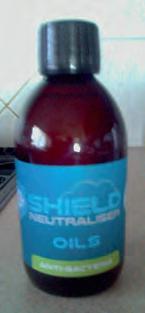

Accessories
I mentioned in the first article about ensuring the ventilation is sufficient when buying the greenhouse otherwise plants can suffer during hot weather. One accessory that can be very useful especially if you are out all day is automatic ventilators, if possible buy these when you buy the greenhouse, otherwise they can be fitted afterwards providing the structure is strong enough. They work by having a small piston in a tube that is filled with liquid. As the temperature rises the liquid expands and pushes the piston out and opens the ventilators. The ventilator can be set to open at the temperature you require and will shut as it cools down. They require virtually no maintenance and should last for years. They are not too expensive and can prevent the temperature getting to high and the plants being damaged.
temperature has dropped the fans switch off and the louvres closed. Fans are useful to circulate the air in the winter which can help to reduce disease problems.
Fans are useful to circulate the air in the winter which can help to reduce disease problems
The other main types of greenhouse ventilation are thermostatically controlled fans, these are set at the temperature you want ventilation to start and will switch on the fan which will draw out the warm air and pull in some cooler fresh air. Once the
Other methods of reducing the temperature in the summer are shading or blinds. Shading is the use of materials like Coolglass which is a type of white paint that is painted or sprayed onto the glass in the spring and washed off in the autumn. When the temperature is high the paint is dry and white and will reflect the sunlight (reducing the amount of radiation from the sun) to help reduce the temperature in the greenhouse. If it is wet the paint is opaque and lets in some light for plant growth. The shading should be removed in September as plants growing overwinter need the maximum light levels. This can be time consuming and frustrating, I can still remember as an apprentice putting the cleaning brush though a pane of glass!
Blinds on the other hand are fixed to the greenhouse structure and can be operated as required so will remain open on cloudy days, but closed or partly closed on bright sunny days. They are made of different materials but should last a number of years. Some blinds are fitted internally and are made from types of textiles very similar to kitchen, bathroom or conservatory blinds.
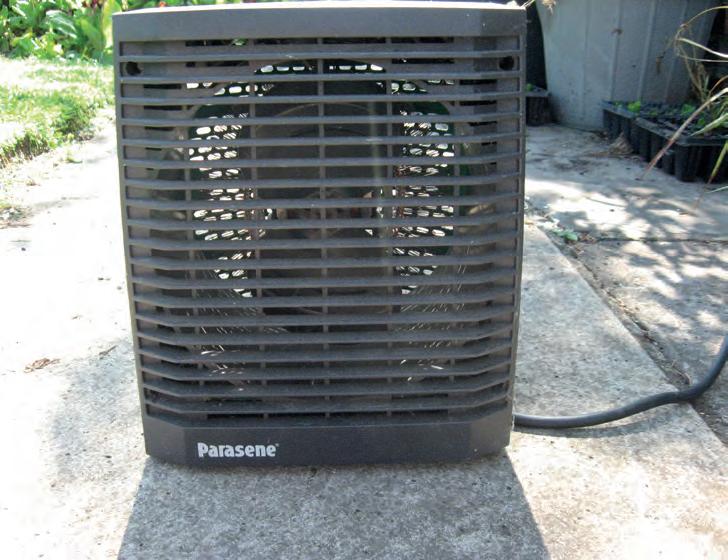
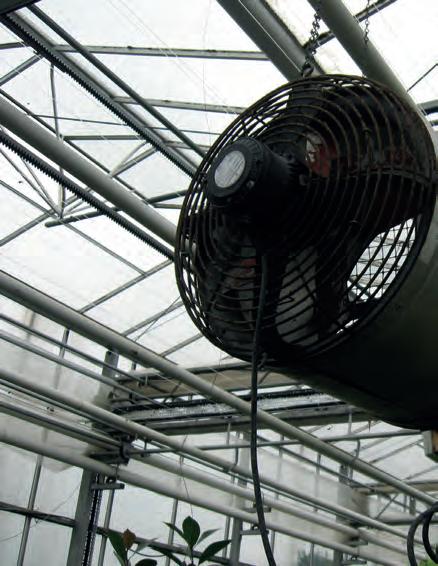
They can be rolled or folded up for storage. The external blinds are usually made from thin wooden lathes or bamboo strung together and again rolls out as required; they are often seen on alpine houses.
Commercial growers use the thermal screens (photograph 11) that have been installed to reduce heat loss over night during the winter. This is a material with a white topside to reflect the light in the summer and a silver foil lower side to reflect the heat back into the greenhouse in the winter. The screen is pulled along wires strung across the eaves to close them and folds up against one of the walls when they are open to allow in maximum light. They can be pulled by hand but in the large greenhouses are opened and closed by an electric motor.
A smaller and less expensive accessory are maximum / minimum thermometers that are useful to check the current temperature but will also tell the maximum and minimum temperatures over the last 24 hours providing they are re-set each day. They are very useful for keeping you informed of the lowest temperature overnight which indicates if the heating is working sufficiently or if more ventilation is required during the day if the greenhouse is getting too hot.
Although a bit gimmicky moisture meters can be useful for checking plants water requirements. This is particularly useful if changing from peat growing media to a peat free growing media as there watering requirements are different. Coir tends to hold more water than peat but can look dry on the surface even though they are moist in the container. As the surface looks dry (but
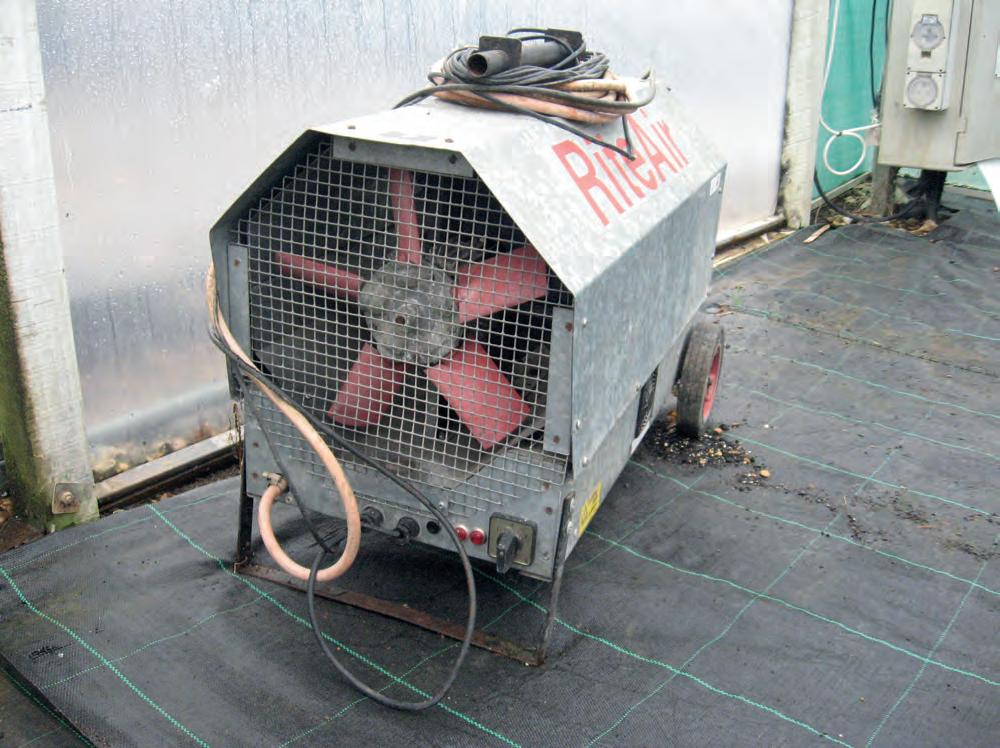
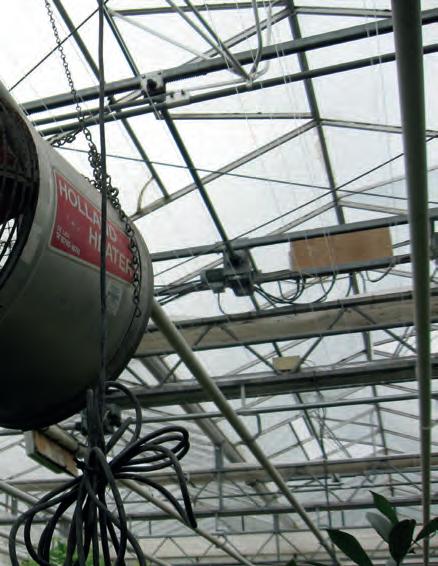
is often moist under the surface) gardeners tend to water which can lead to waterlogging of the growing media which results in poor plant growth or death of the plant.
Heating
I will include a section on heating a greenhouse in case any of you wish to grow early crops, start off plants in late winter/ early spring or are flush with money to pay the heating bills. Unless you have a wood or biomass burner with access to a cheap supply of fuel the heating of even a small greenhouse is expensive and it is not economic to grow many crops over winter.
Cheaper methods of overwintering plants are to use heated benches mentioned in the last article or using a propagation frame within a greenhouse and just heating the frame or sectioning off one end of the greenhouse and just heating this area. I will cover in later articles the growing of vegetables in a cold greenhouse over winter.
said that for every 5˚C the temperature is raised it will double the heating cost.
So what are the options for heating?
Paraffin heaters
Gas - piped or bottled
Electric - fans or tubular
Solid fuel boilers – wood, biomass, smoke less fuel heating hot water pipes
Let’s consider these options in more detail starting with electric which is the most convenient but also the most expensive. The thermostat can be set at the required temperature and the heater will switch its self on/off as required to maintain that temperature. It is clean, reliable unless you are prone to power cuts, easy to use and keeps a constant temperature. Its main disadvantage is the cost and it is unlikely to get cheaper.
Tubular heaters are a reasonable dry form of heat which is an advantage in the winter as it helps to reduce disease problems
Glass loses heat far quicker than brick so therefore it takes a large amount of heat compared to heating a room in a house with a brick wall. This is one of the reasons people are looking at growing rooms of the type Ian Stocks has mentioned in his alternative growing articles. As a very crude guide it is
There are three options with electric heating; if growing crops in the border soil then tubular heating pipes are the best. They are fairly efficient in the use of fuel and can be set at the crop height so it gets the maximum benefit. They come in various lengths and are usually fitted to the side and end walls of the greenhouse. It is necessary to calculate the amount of heat required to maintain the temperature required and this will tell you what length of tubular heaters are needed. Tubular heaters are a reasonable dry form of heat which is an advantage in the winter as it helps to reduce disease problems.
Electric fan heater (Photograph 1 & 2) are the next option, these have the advantage that they circulate the air which again helps to reduce disease problems. The fans can
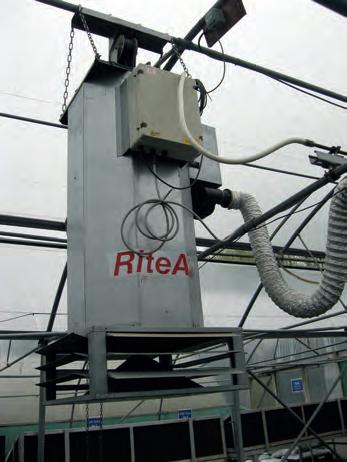

also be used during the summer to cool and circulate air (the heating element is turned off!). They are also useful in the autumn if growing late Chrysanthemums to reduce fungal diseases on the blooms. Again it is necessary to calculate how much heat is required so that the size and number of fans can be estimated. Fan heating can be useful for short term heating just to start crops off in the spring.
If the greenhouse is just required for propagation such as raising seedlings it can be cheaper and a lot more efficient just to heat the bench which was covered in the previous article. The bench can be heated by electric cable or small bore hot water pipes and keeps the heat around the plant where it is most needed. As most of the volume of air in the green house is not heated this saves money and reduces the amount of carbon used therefore reducing the effect on climate change. Soil or bench warming cables are a very efficient method of raising the temperature a few degrees around the plants.
Paraffin heaters are cheap to buy but the fuel costs can be quite expensive
intervals to ensure the pilot light has not gone out and that it is not producing any fumes which can damage plants. Keep the burners clean to prevent toxic gases being given off. Gas tends to be slightly cheaper than electric and also gives off carbon dioxide which the plants absorb through their leaves and helps to boost growth. The disadvantage of gas is that it produces a moist heat that can encourage fungal disease and condensation on the glass in the winter.
If a gas supply to the greenhouse is a non-starter then bottled gas (Photograph 3) can be considered. This is more expensive and has the hassle of having to buy and change the bottles when they are empty. If they were to run out on a cold night it could result in the loss of many of your plants. Bottled gas will also produce carbon dioxide for the plants to use; and also a moist heat which can lead to disease problems.
Moving onto the next most convenient method of heating which is natural gas (Photograph 4,6,9). This requires a pipe laying down to the greenhouse from the gas mains into the property which may be expensive and will need connecting to the gas mains by your supplier.
A wood or biomass boiler is the cheapest form of heating a greenhouse
Once the heater is set up usually on a slab or concrete surface for stability; the thermostat can be set at the required temperature and it requires little other work. Once the pilot light is lit the heater will switch itself on and off at the required temperatures. The heater should be checked at regular
The good old fashioned paraffin heater (photograph 5) is next; this also produces a damp humid atmosphere and needs a chink of ventilation left open to ensure there is sufficient oxygen for the flame to burn cleanly. It is vital the wick is kept clean otherwise the plants, glass etc. will be covered in black sticky soot which is difficult to clean off – I speak from experience! The heater will need filling up every couple of days depending on what size tank it has and sufficient paraffin needs to be kept in stock. Paraffin heaters are cheap to buy but the fuel costs can be quite expensive especially if a high temperature is being maintained.
A wood or biomass boiler is the cheapest form of heating a greenhouse and this is the way many of the commercial nurseries

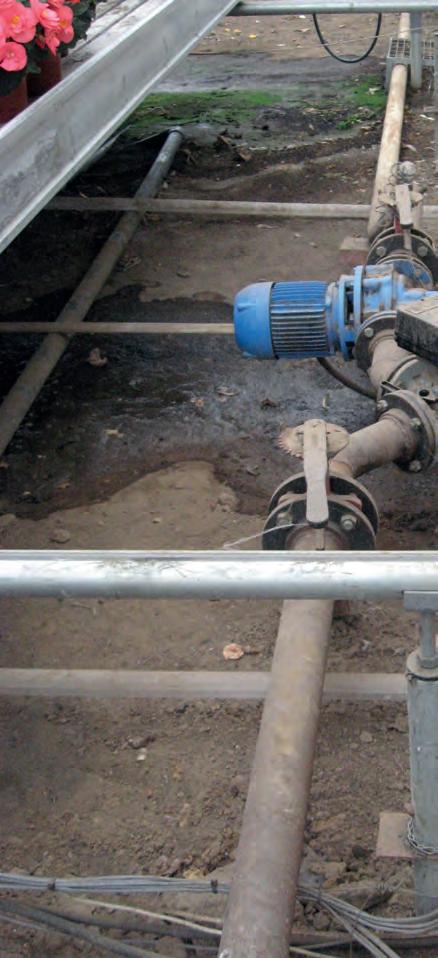
are going. It is helpful if you have your own supply of fuel as this is then a very cheap form of heating! The boiler will need a chimney and it is best to set the boiler away from the greenhouse as it is a dirty form of heating. The heat can then be supplied to the greenhouse by hot water pipes. These days the 25mm diameter finned pipes are very efficient and do not take up much space or use a 50mm diameter plain steel pipe around the perimeter of the greenhouse. (photograph 7&8)
Before installing a heating system it is important to calculate the size of system required to heat it to the temperature you wish to maintain. If you just purchase a heater with no regard to size it may be too small and not be capable of maintaining the required temperature or too large and a more costly heater brought than required.
Heat loss is calculated by working out the rate of thermal transmission or loss of heat (U value) for the surface area of the greenhouse; this is the surface area of the walls, both ends and the roof. For the exercise below I will assume a glass to ground type of greenhouse (no brick or wood walls as these have a different U value.). The answer will be in watts/m2/˚C.
But in case you need them the average thermal transmission for the following are: Glass (including glazing bars) - 7.94 w/ m2/˚C
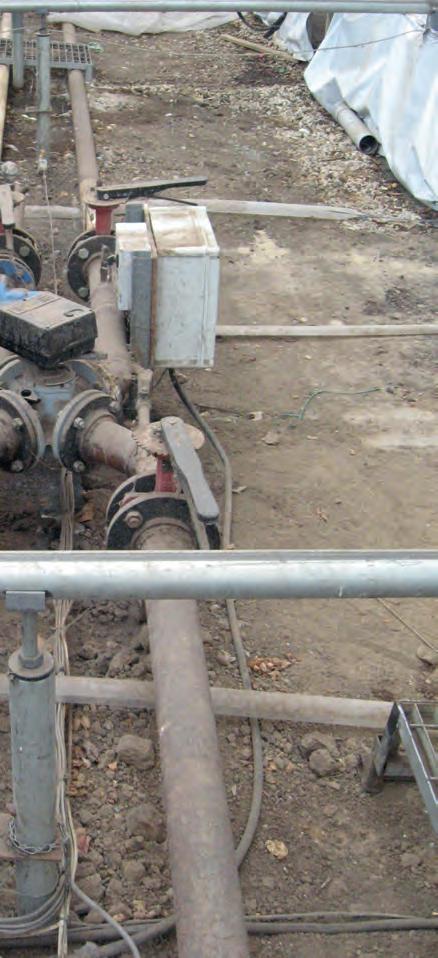
Heat loss through the floor or soil is ignored as it is very low and can act as a heat store.
So assuming we have a glass to ground greenhouse 2.4m x 1.8m (the old fashioned 6ft x 8ft!) the surface area will be:
2 Sides 2.4 x 1.8 = 8.64m2
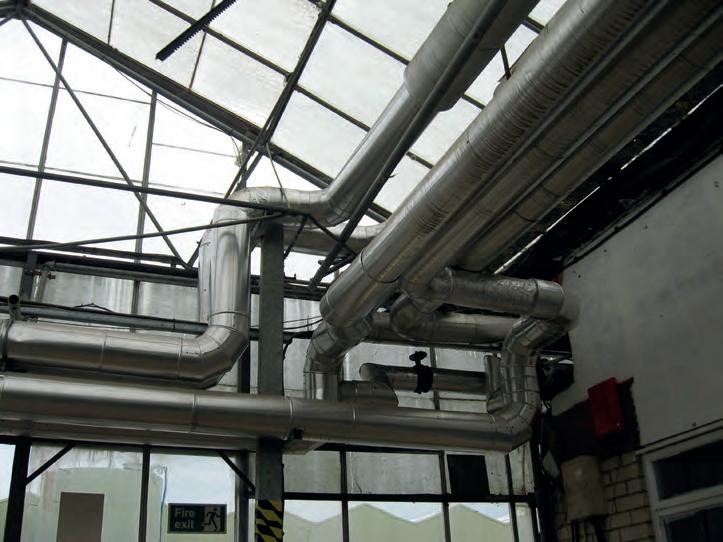

2 Ends 1.8 x 1.8 = 6.48m2
2 Roofs 2.4 x 1.05 = 5.04m2
2 Gable ends .9 x .45 = .81m2
Total 20.97m2
Use the following formulae to calculate the heating requirement:
The total surface area is 20.97 multiplied by the U value of 7.94 = 166w/m2/˚C. This figure is the amount of heat required to raise the temperature of the greenhouse by each degree centigrade above the outside temperature.
(not below minus 8˚C or lower) you assume an 11˚C lift in temperature is required. This will keep most plants alive but possible not growing and prevent frost damage in most winters.
The amount of heat required will depend on which part of the country you live
The amount of heat required will depend on which part of the country you live (it’s a lot colder in Scotland than southern England!), how exposed the greenhouse is (wind tends to draw the heat out of the greenhouse even if it is well sealed) and what plants you intend to grow, lettuce need a lower temperature than early tomatoes.
To maintain frost protection during a normal winter in the southern half of the U.K
Therefore the calculation is 166w/m2/˚C *11 = 1826 watts, approx. 1.8 kW; so a heater capable of producing 1.8kw of heat is required. For electric heaters this is easy as it will tell you on the box or literature if the heater is adequate. For gas and biomass there are figures available for the boiler and also the calorific value of the fuels to
be able to calculate if the heater is adequate and how much fuel will be required and from this you can calculate you fuel costs; which will likely put you off heating your greenhouse!
If you wish to grow early tomatoes or cucumbers (or tropical type plants) which need a higher temperature just increase the 11˚C to 16˚C or even 22˚C. You will then see the true cost of growing the warmer crops

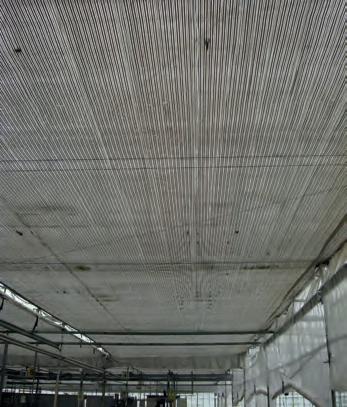
(Photograph 10) the cost to heat one block of a commercial pot plant nursery and they have 4 other blocks!
In the next article I hope to cover lighting in which there has been a lot of research recently. Thermal screen to retain heat at night

Jersey is taking an active role in encouraging healthy eating amongst its youngsters including growing and cooking home-grown produce.
This includes participation in the Jamie Oliver Kitchen Garden Project which has been launched in three local primary schools. The first to take up this new initiative, Samares Primary School in St Clement, achieved national recognition, chosen in April as the Jamie Oliver Kitchen Garden of the month. Since then, Mont Nicolle and St Luke’s Schools have become involved.
Inspired by the celebrity chef, a unique online community and teaching resource hub has been established that supports UK primary schools in bringing food education and cooking skills to life. It is believed that by providing children with the tools they need to grow food from seed and prepare nutritious meals from scratch, it will equip them with some of life’s most valuable skills.
It is also considered that children who learn to cook are more likely to make better food choices and understand healthy eating. As food education is, without doubt, one of life’s most important skills – just as valuable as reading, writing and maths, it is thought that children who plant and nurture their own fruits and vegetables are far more likely to eat them.
off the ground in Jersey is due to the efforts of Melissa Nobrega who runs the Jersey charity, Caring Cooks, which helps feed families struggling to feed themselves. There has been expert advice on vegetable growing from Jersey NVS branch chairman, Graeme Le Marquand and financial backing to buy equipment from Santander Private Bank whose employees have also provided the voluntary labour to revamp outside areas and prepare plots for growing.
Children from all year groups have been involved and produce planted has included Jersey Royal potatoes, carrots, sugar-snap peas, lettuce, tomatoes and onion sets.
Samares School, which promotes a fruit and vegetable morning snack policy, was chosen for national recognition
Much of the credit for getting the initiative
Samares School, which promotes a fruit and vegetable morning snack policy, was chosen for national recognition after it sent through a selection of the best photographs of the project in action.
Headmaster, Andrew Wills, said he was delighted, saying it had been a fantastic project so far and one which promised to go from strength to strength. He added,’ it has helped the school diversify its learning programme. We signed up because it was a great opportunity to work with the children in learning across the curriculum. It helps the children understand what constitutes a


planters edged with sleepers have been created and under the watchful eye of Mr Le Marquand, the children have learnt how to sow a variety of vegetables including beetroot, peas, runner beans, carrots, and radish and salad herbs. Judging by their enthusiasm, the children love the opportunity
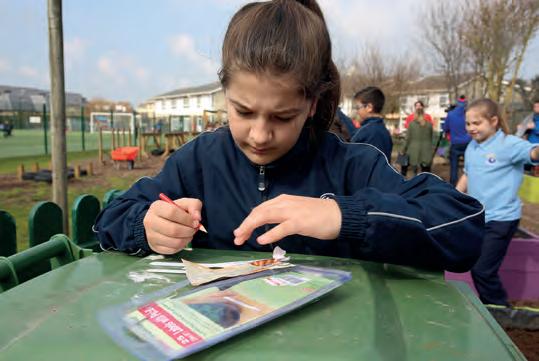
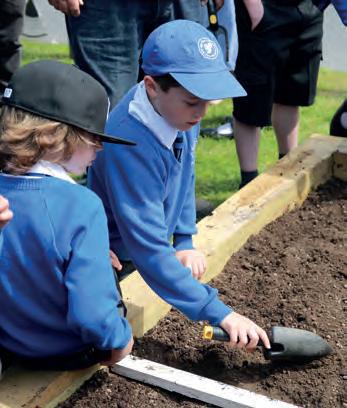

to be in the open air, growing their own food. They have made dated labels and in the coming weeks will continue tending and watering the vegetables until they are large enough to eat.
James Pountney, Managing Director of Santander Private Bank in the Channel Islands explained that in line with the Bank’s social responsibility programme, they were looking for a local project connected with education.
‘We contacted Jersey’s Education Minister, Rod Bryans, and he recommended getting in touch with Melissa. We had a couple of meetings with her and she was really inspirational.’
He added that Mont Nicolle’s year 2 eco teacher, Katie Hargreaves had suggested to the headmaster, John Baudains that the school would benefit from involvement in the Kitchen Garden Project. ‘He was very supportive, which was brilliant.’

from Santander will be returning when school starts back in September when the children will be harvesting, preparing and eating the produce.
Judging by their enthusiasm, the children love the opportunity to be in the open air, growing their own food
Apart from helping with the initial clearing, setting up and weeding of plots, volunteers
Collette Bisson
I know working with children is not everyone’s cup of tea but if you are happy to do that this sort of project is well worth getting involved in. It will keep you out of mischief if you are retired and encouraging gardening is very important for a number of reasons. Hopefully some of these young gardeners are the growers and NVS members of the future. - ED


The legumes as I am sure most of you know consist of the Broad beans, French beans, runner beans and peas. It is a smaller group than the Brassicas but they tend to be more prominent on the show bench. The broad beans are often seen at the early shows with the peas coming slightly later and the runner and French beans at the later shows. The runner bean is a major vegetable at the main summer shows; the French bean is seen less. The legumes are reasonable easy to grow with less pest and disease problems than the Brassicas.
As the broad beans are the first to be ready I will start with these; it is important to get the timing right so that they peak at the time of the show. This is not easy as they are often overwintered outside or in a cold greenhouse and the timing is very weather dependent.
be fresh, clean (no pest and disease) with unblemished skins. They should be well filled and the judge should select a pod and open it, inside the beans should be full size, tender with no “black eyes” at the point where they join the pod. This is a sign the beans are slightly over mature, the beans should still be attached to the pod. There should also be a full set of beans with no gaps, or small beans. The stalk that attached the pod to the plant should still be present. The judge should down point dirty or diseased pods and if they are not all of a uniform length. Check the numbers are correct with the schedule.
The pods should be fresh, clean with unblemished skins
The judge is looking for long pods, which to some extent is controlled by the choice of cultivar, so chose a long podded type. The Windsor type are shorter podded and are usually grown to crop later in the summer than the long podded type which are hardier and better for exhibition growing. Some of the newer cultivars have been bred for machine harvesting or growing in containers which is fine for cropping but they are too short a pod for exhibiting. They are unlikely to beat the long podded cultivars. The pods should
These are not seen as often on the show bench as runner beans but the round or pencil podded types are fairly common at the late summer shows; the flat podded type are less commonly seen. Now that the breeders have succeeded in crossing the French and runner beans to produce the self-pollinating runner beans we may see some different variations coming onto the show bench in the future.
French beans have the dwarf and climbing types but they are usually shown in the same class. The beans should be straight, uniform in length and shape complete with a short stalk. They should have a good colour which will vary according to cultivar but a darker green seems to be preferred. There should be no outward sign of beans and the pod should be of an even diameter along its full length. The judge should select one and snap it to check for strings, they should break cleanly and with a snap, hence
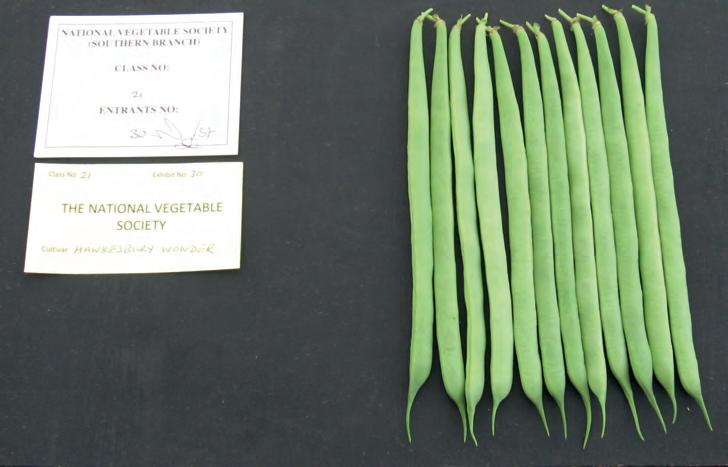
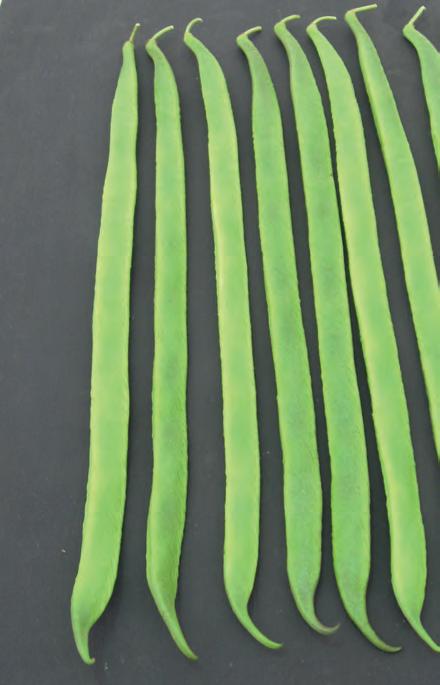
there common name. Before snapping them check over all the exhibits first to get a overall impression so that you can make your final decision after snapping one from each exhibit.
This is often a class with plenty of entries although there are usually only four to six of the exhibits in the running for a prize. At local village shows many exhibits can be eliminated as the beans are old, bent and lack uniformity in length; and some will be NAS owing to having the wrong number of beans. Check the numbers of all the exhibits before you start judging them.
The length of the bean is important and as long as the quality is there the longer beans will win. Once the numbers have been checked, check for the uniformity of length and that each pod still has a short length of stalk attached. The pods should be straight with no outward sign of beans and have a uniform tail which usually curls a little. They should be fresh which you can tell by feel and by placing one hand over the pods and gently lifting them and letting them drop onto the bench, the limp ones just flop back down whereas the fresh ones hit the bench with a thump! Ones the pods have been carefully inspected select one from each exhibit and snap it in half and check for strings and also if there are any beans in the pod. If the beans are present or the pods tough they should be down pointed. Another fault to check for is if the bean has a waist, that is the pod narrows
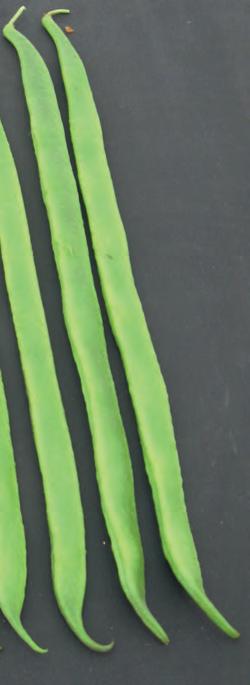
at some point along its length.
Peas

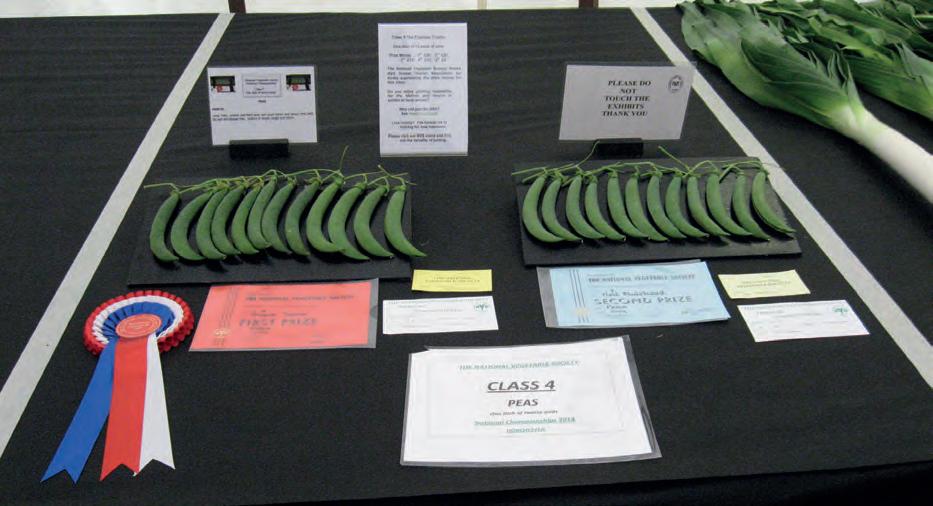
I will start with the conventional peas which are often seen in the summer shows, but less so the late shows possible owing to pea mildew which is bad later in the season. The pods should be large, straight and fresh with unblemished skins. They should have a good even colour and importantly the bloom should still be present with no finger prints showing. To avoid this hold the pod by the short stalk left at one end. Ensure the correct number of pods are present and they are of a uniform length; they should be fresh, tender and a good green colour. Once each exhibit has been inspected select a pod from each and open it to check it has a full complement of peas and there is no pest damage (pea moth) inside. If you wish to check the peas in the other pods hold them up to the light.
Mangetout or Snap Peas
The pods should be fresh, with a good colour
These are becoming more common on the show bench now and are sometimes seen in the any other vegetable class at some shows. The pods should be fresh, with a good colour and the bloom still intact, so they should all have a stalk to hold them. The peas inside should be barely developed as the pods of the mangetout type should be flat, but to check there is a full set of peas in the pod, hold them up to the light. The snap pea type is a more rounded and fleshy pod and snaps easily if broken hence their name.
Check the correct number are present, no pest and disease damage or marks on the pod skin.
That completes the main vegetables from the legume group that you may find on the show bench, in the next issue I will cover salad crops.
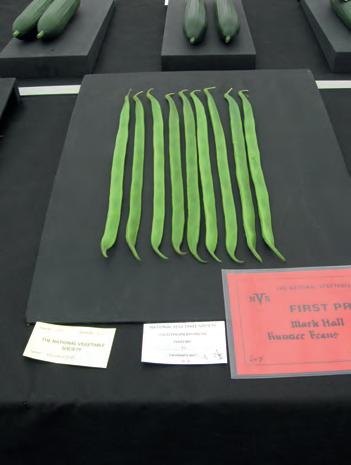
Jersey cabbages, or ‘Long Jacks’, as they are also locally known, can reach exceptional heights. A specimen currently in Neville Renouf’s garden at St Peter is now between 13 and 14 feet (approx. 4 metre) tall and has just produced a flowering head prior to going to seed.
Mr Renouf is certainly dwarfed by the plant which he says has had no special treatment. However, it is possible that it may have received a boost from the bonemeal which he added to the raised border for the benefit of a row of Jersey Royal potatoes. The seed was acquired from his sister and was sown 15 months ago.
Although the plant is not likely to be a record, as heights up to 18 feet have been noted, Jersey cabbages of this size are not as familiar a sight as they used to be.
At one time the cabbage caused quite a stir in the agricultural world and in the 1830’s it was reportedly cultivated in almost every garden. Rumour had it that sheep who fed upon the giant cabbage of the Channel Islands were found to produce wool of the finest silken texture up to 25 inches long.
A description of how essential this cabbage had once been in the farming world can be found in volume IV of The Farmers’ Magazine, January to June 1836, which stated: ‘Five of these stupendous cabbages have been found to provide an ample allowance of food for one hundred sheep or ten cows, and the nutrition thence supplied by this delicious vegetable will speedily produce the most surprising improvement in the growth and utility of every description of cattle.’
Regular removal of the leaves is essential to promote further growth with the cabbage taking about one year to reach maturity. While the leaves can be used as feed, there is also a useful purpose for the stalk. Once the plant has been pulled from the ground and its top chopped off, the stalk can then be left for an entire year to dry out. It can then be manufactured into a fashionable walking stick. The root is left intact because it can be used to make a handle for the end product. The finished result is a light but strong hollow tube of wood, much like bamboo.


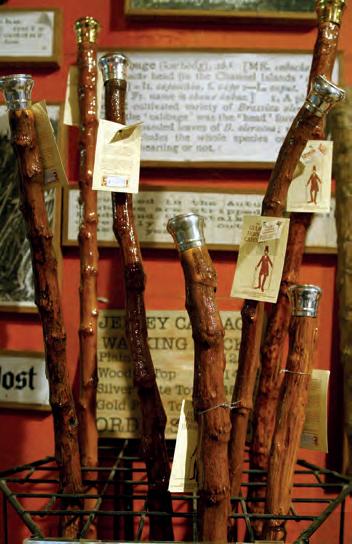
Summer is here and things are really heating up at the hive. Lots of good weather means nectar and pollen levels are up and the queen is laying her heart out. Bees are out and about making the most of the garden so make sure you are fully protected from head to toe. Try a BJ Sherriff Apiarist All-in-One beesuit for all over cover, good vision and ease of wear. In July and August, the sun is shining and the queen is slowing down - this is
the main time for nectar flow. Bees really know how to keep their hive secure with their own made superglue (propolis), so using the slimmer red hive tool is essential for smaller hives available at bjsherriff.com. With so much honey producing potential, having the best hive tools is really important. After all the hard work, sit down and have a nice slice of honey on toast – you’ve earned it!
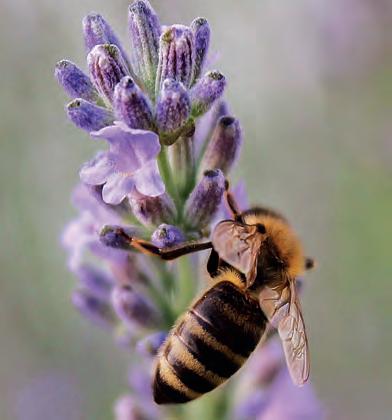
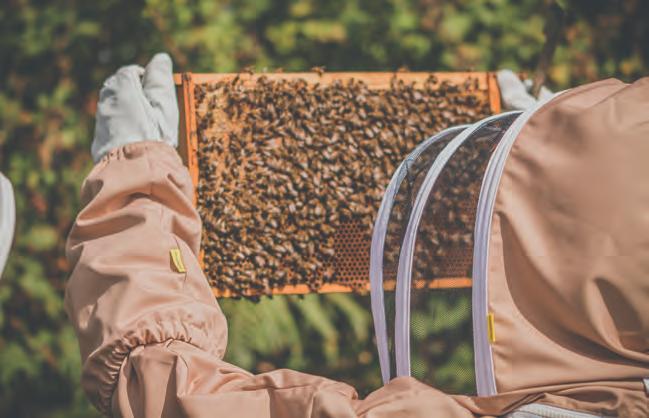
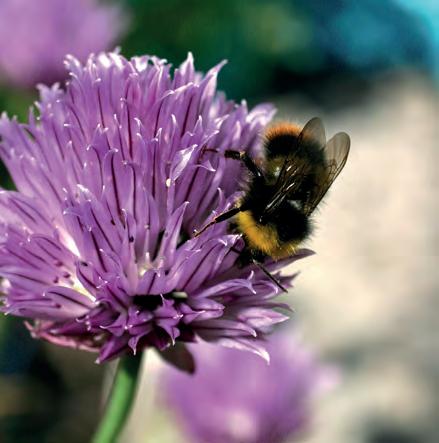
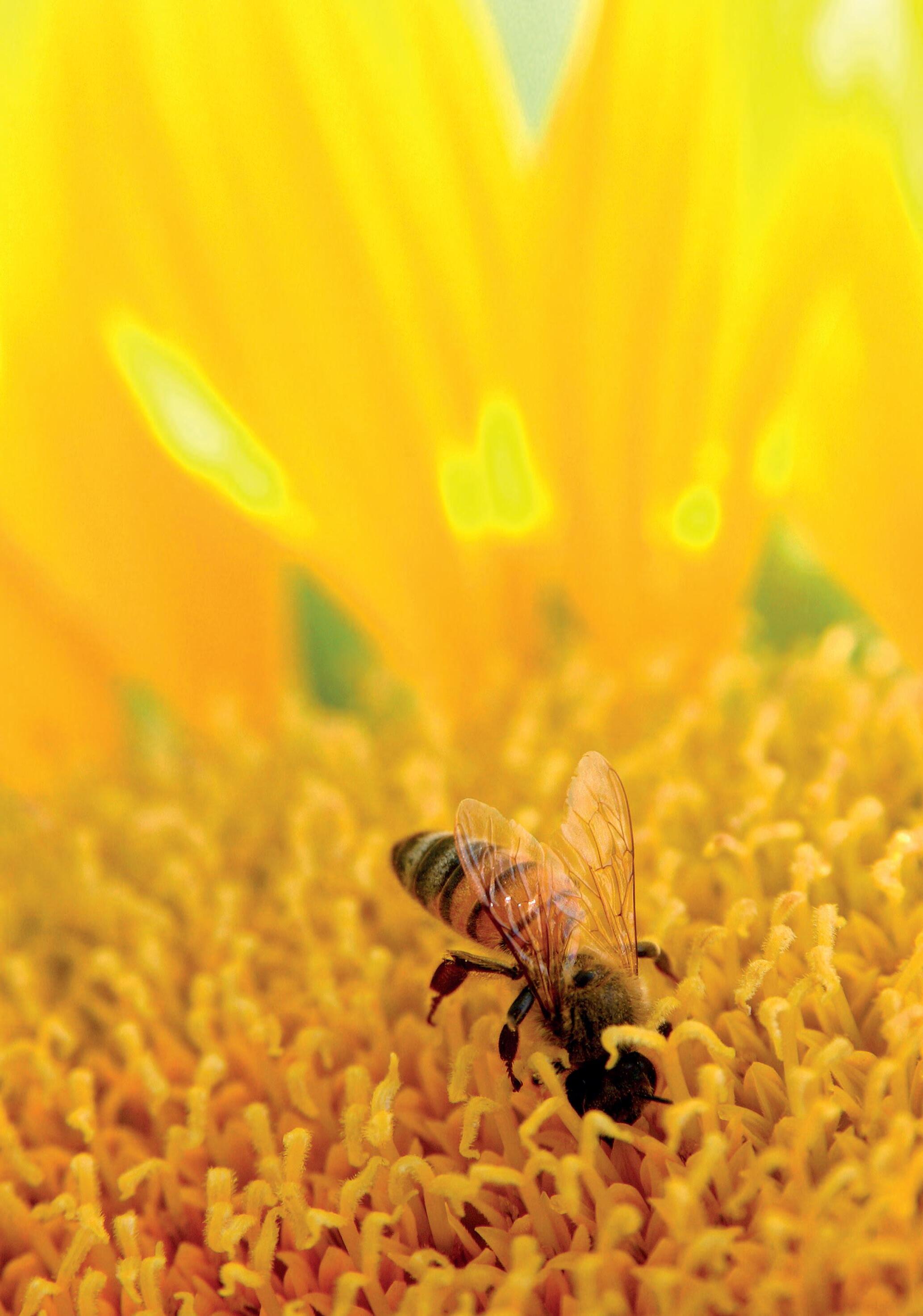

You should always try to find some way to keep your chickens entertained to prevent bullying or pecking amongst your brood. It is a good idea to vary the entertainment that you provide so that they do not come to expect the same treats etc all of the time.
One way to keep your chickens entertained is to hang some vegetables such as corn on the cob, lettuce or any other greens that you have in their run for them to peck away at will. If you hang it to just above their head


height, this will keep them entertained for a while as the vegetable will swing around while they try to peck at it and they will have to stretch or jump to get their treat.
Another way to keep them entertained is to install a swing. Yes, a chicken swing is a real thing and can easily be bought online! However, this could create the problem of all of your chickens trying to have a turn at once (although this can be quite entertaining to watch).
Chickens also seem to like anything that shine; placing a mirror that is made for pets (so that it cannot easily be smashed) or even hanging a CD for your chickens can keep them entertained for a while. They will enjoy seeing their reflection in the mirror and the rainbows that are cast when the sunlight hits it.
When your sunflowers have died back, you can cut the heads off and put them in the chicken run. The chickens will enjoy pecking the seeds out themselves, thus saving you the job.
spaghetti is also a great source of fun for chickens. They think that they have found worms if you place it in various areas of their run and are funny to watch with spaghetti hanging out of their beaks.
entertainment methods should be used as part of a balanced diet and not used all of the time.
entertain your chickens but above are just a few that we deemed the most entertaining to watch! Tutorials can be found online to inform you on how to make various toys for your chickens or they can be bought for a relatively low price. Now it’s time to enjoy the summer evenings and watch your chickens playing with their new toys!
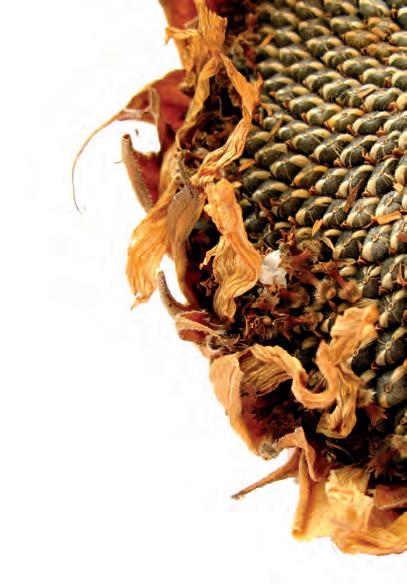 Beth Cowan
Beth Cowan
Suppliers of fertile hatching eggs: Eggs supplied to the UK and also EU countries.
Large fowl and bantams, ducks, geese, turkey, guinea fowl and quail
Continually working to improve the individual breeds, free range and our unique packaging ensures optimum fertility.
We are agents for Goldline Hybrid Black Rock Hens Tel: 01452 724565/07709 933064 Website www.fosterpoultry.co.uk

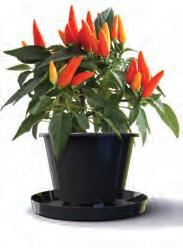

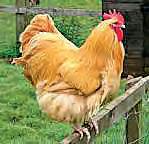
Pot Plants – patio, conservatories, indoors, potting shed... Most experienced gardeners know to ‘bottom feed’ when watering their pot plants, i.e. water from the saucer, but for many, this method is not fully appreciated.
Healthy roots lead to healthier plants; to achieve this, roots need to reach down to find water and sufficient feed to strengthen their root system naturally, rather than struggling within a waterlogged system.
productive plants
• Eliminates the use of drainage products • Organic pest protection










This is why I came up with the idea for TwistPot®, a combination of feeder tray and plant pot – a simple lift and twist of the pot allows the plant to be raised to a higher drainage position or a lower feeder position, giving the potted plant the best of both root development benefits. There is no need for additional drainage products; TwistPot® is useful for dry periods thus saving costs, worry and time. It is also a vital safeguard during wetter conditions.
Enjoy the satisfaction of successful pot plant growing with the proven benefits from the TwistPot®.
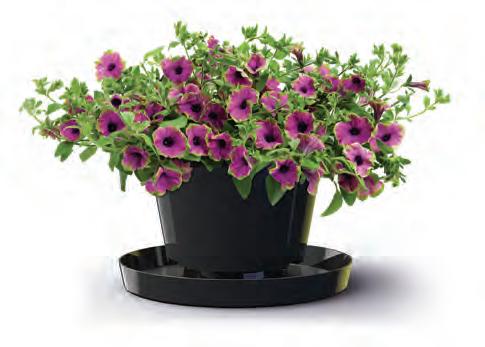

Minutes of the 2015 AGM held on Friday 4th September 2015 from 4.12pm to 4.50pm in the events marquee, Camperdown Park Dundee. In a change to the published agenda The National Championships Trophies and NVS awards presentations preceded the AGM. Mr David Allison opened the meeting as chair with approximately 120 members attending.
1. Chairman’s Opening Remarks and Report.
The Chairman Thanked Craig Melville for presenting the trophies to the winners of this year’s championships. Following the presentation of the awards by our president Medwyn Williams, he then said a few words. (See attached report).
David Allison thanked Dundee council for supporting our championships along with Ian Stocks and the Scottish Branch for their work in arranging these excellent championships.
A minutes silence was held to remember all our colleagues throughout the society that had passed away Colin Lewis, Welsh Branch Chairman, Frank Mercer, long standing Northern Branch Member, and Ken Mirfield, former West Yorkshire DA Chairman.
The Chairman’s annual report is attached to these minutes.
2. Apologies for Absence.
Robert Miller, Mr & Mrs Evans, Mr & Mrs Newman & Peter Guthrie.
3. Minutes of the 2014 AGM held at Dorchester.
These minutes where published in July 2015 Simply Vegetables magazine and the membership present was happy to accept these minutes. Proposed by Mr P Morris and seconded by Mrs P Brown.
4. Matters Arising.
There were none.
5. To receive the Annual Report of the Trustees for 2014. Mr David Thornton. The National Secretary delivered the Annual Report of Trustees for 2014. See attached report.
6. To receive the Annual Report and Accounts for 2014
David Allison read out a letter from Robert Miller in his absence explaining the accounts. The accounts had also been published in July Simply Vegetables Magazine, He then asked for questions on the accounts and pointed out that supporting documentation to the accounts were available today for anyone to view. Proposed by Mr D Thornton and seconded by Mr G Cathro. That the accounts be accepted.
7. To consider the Election of the following positions.
Position Nominee ProposerSeconder
President Medwyn Williams A EdwardsD Metcalfe
Vice-Presidents en block WT Burrows, I Garland, GP McSkimming, M Evans, W Thornton, Grant Cathro
National Treasurer Robert Miller
National Vice Chairman Vacant
S HallB Newman
D AllisonD Thornton
National Secretary David Thornton B NewmanR Miller
Membership RegistrarNeil Hope N MuirheadG Francis
All above positions were agreed by the members present at the AGM
8. To consider the Election of an Independent Examiner
A new examiner will be appointed now that Robert Miller has been elected into office. The chairman asked that trustees will appoint the new Examiner and publish details in a forthcoming edition of simply vegetables. Proposed by D Thornton and seconded by G Francis with a majority show of hands.
9. Any other business.
9.1 Ian Stocks gave out details of the arrangements for the evening’s entertainment.
With no further business David Allison thanked members for attending and closed the meeting.
Copies of attached reports can be obtained from the assistant secretary
Minutes by MARK HALL. BEM.FNVS. September 2015
Dundee, September 2015
Good afternoon Ladies and Gentlemen,
May I start by both welcoming you all to Dundee and thanking the Scottish Branch for arranging this year’s Annual General Meeting and managing an excellent Championship. Can I also thank Dundee City Council for hosting both the AGM and the Championships, and to Councillor Melville, for kindly agreeing to be with us to present the Trophies later.
Before I start my report, and as is usual, can we quietly remember those colleagues who have passed away during the last year.
We particularly think of Frank Mercer, founder member of Wirral DA, Ken Mirfield, former West Yorkshire DA Chairman, and Colin Lewis, Chairman of the Welsh Branch who died quite suddenly over the week-end of the Welsh Branch Championships. All three were long standing and active members of our society. If we do have any others who are no longer with us, please accept my apologies for not remembering them. Could you please stand for a few moments of silence.
Thank you.
As usual my report is followed immediately by the Trustees report prepared by David, and as always this is a very thorough account of the Society’s activities throughout the year. So, in order not to repeat things I will concentrate on matters which have both pleased and concerned me personally over the last year.
I have a couple of concerns, the first being our apparent inability to attract members to the trustee board to take on positions of responsibility, particularly Vice Chairman and Marketing Media and Sponsorship positions. These have both been advertised extensively in Simply Veg, for almost a year now, but to date, no takers. You will remember at Dorchester last year my predecessor Barry Newman proposed a motion supported by thee Trustees to amend our rules to allow the latter position to be created, which was carried.
This was the appointment of a new Trustee to oversee the Society’s work in relation to media opportunities and the attraction of sponsorship together with taking responsibility for and liaison with our two current Officers in that area (Editor and Webmaster).
This is a move which is an essential area of Society business if we are to take advantage of the ever growing interest in ‘Grow your Own’.
The other area that concerns me is the level of churn, i.e. the number of new members in particular that don’t renew their memberships. We appear to be quite good at recruiting members through various initiatives; the skill is hanging on to them. I think we give good value for money with the various offering available to them, i.e. a quarterly magazine, free seeds, active website etc.
However I don’t want to sound too despondent as our membership continues to grow slowly, unlike some other specialist Horticultural Societies.
Now for some good news,
The Strategic Working Group under the former Chairmanship of Neil Muirhead have presented a number of papers to the Trustees, and one in particular, the implementation of a direct debit scheme is progressing well, and should help to overcome some of the churn I mentioned earlier. It will also create other opportunities, i.e.; online sales etc.
I know Mark Hall the new Chairman of this group is keen to keep the momentum going and we wish him well in this new role.
The continuing and excellent work done by Kelvin as Editor and Emily as Webmaster and the responses they receive from both members and non-members only seek to confirm how much our ‘outward facing’ services can enhance the work of the Society (and I think we will hear more of this from Emily later) This, together with getting clarity and purpose with regard to our national, regional and local sponsorship opportunities is, I believe, essential for the society going forward, hence the importance I give to the new post.
As well as Webmaster, Emily has also set up and runs a Facebook page and Twitter account, both of which are growing slowly. So I think
our social media offerings are as good as any other specialist society.
I was delighted that we now have a third book in our “Getting Started” series, entitled “Getting with Growing Fruit” which became available this spring under my Editorship, and has been well received. Thank you to Gerry Edwards for his considerable input to the book as author of the 27 chapters within.
Whilst there is nothing in the pipeline, opportunities do exist to increase the range of titles, i.e. Growing under glass, herbs, recipes to name three.
Turning attention to existing aspects of the Society’s work, as Barry mentioned last year in Dorchester, like all voluntary organisations it is the amount of time individuals can give that determines the pace and success of the organisation. This has not and will not change ladies and gentlemen.
We are no exception, and it is the dedication of those active members that make the NVS what it is. So I would like to say a big thank you to all of you that give your time to the Society, particularly all of you who have demonstrated your commitment by becoming involved at DA, Branch and or Trustee level.
However committees, on their own, can’t make things happen. Dedicated, active and enthusiastic people make things happen and quite frankly we don’t have enough. We are quite literally recycling those we have and wearing them out. Like all volunteer organisations, we need new blood, to take the organisation forward for the benefit of this and future generations of growers and showers.
My first year as your Chairman has been an interesting experience albeit challenging at times. We had to appoint a new Treasurer part way through the year, and the Northern Branch Treasurer, Robert Miller stepped up to the mark at short notice, and offers himself for re-election today, although for family reasons is unable to be with us.
We should be proud of;
• The partnerships we have established with major seed companies and horticultural suppliers and the potential that offers for future sponsorship.
• The continued success of ‘Simply Vegetables’ and it’s prominence as probably the best publication of a specialist plant society.
• The recent re-presentation of our Website and the potential it, and other social media opportunities, can offer the Society.
• Our range of educational guides, books and DVD’s.
• Our ability to mount displays, exhibitions and shows which serve to enforce our credentials as the voice of vegetable growing.
• The recognition which the RHS gives our Society and the quality of our judges and lecturers and the respect they are given. I should say at this stage that I am delighted that eight members of the NVS continue to be on the panel tasked with re-editing their Show Handbook for 2016. Medwyn, Barry and I continue to serve on the RHS Fruit, Vegetable and Herb committee, promoting the NVS wherever and whenever we can.
We are one of the most effective specialist plant societies in the country. Please continue to support us in whatever capacity, as an active member, as an exhibitor or just as someone interested in improving their skills as a vegetable grower.
It is a privilege to be your Chairman. David.
The Trustees and Branch representatives of the Society met on 4 occasions in the past 12 months at the new venue in Crewe. The meeting agendas remained reasonably static and cover Society communications, financial performance, membership issues, website, marketing and promotions at national events and shows plus issues that crop up in the interim period between meetings. Many issues are now discussed using email in order to save time at the meetings. The composition of the Executive Committee changed with David Allison as our new Chairman, Robert Miller replacing Helen Vincent as National Treasurer designate and with the addition of David Metcalfe replacing Keith Abel as Northern Branch Chairman. We wish these gentlemen all the best in their new roles. We are still seeking additional Trustees to take on the roles of Vice Chairman (person) and media relations.
Our quarterly magazine, Simply Vegetables, goes from strength to strength and remains our flagship communication vehicle with members and the outside world. The Trustees would like to build on
the success of SV and are considering the launch of an e-bulletin, as an interim communications tool between issues of SV.
The NVS website continues to develop as well under the watchful eye of web manager Emily Plumb.
We are confident that both of these communication tools gives the NVS a modern image to a world audience compared with similar specialist societies.
Our Membership Registrar, Neil Hope and his four Branch Membership Secretaries reported a slight increase of 0.6% in membership over last year, so current membership stood at 2312 in July. The Southern Branch remains our biggest branch, but Northern Branch showed the highest increase in members this year. In 2014-15 the initiative with DT Brown Seeds has realised 75 new members to date. We seem quite good at being able to get people to join the NVS, but struggle to hold on to them, particularly those joining at shows for example. To this end the Trustees approved Direct Debit with all the attendant safeguards, as a new means of subscription collection, which we hope to launch early next year. The evidence from other societies suggests this is the best way of reducing membership churn. In addition, the Trustees are considering more centralisation of membership administration to ease the burden on our Branches.
Our “overseas” District Associations in Ireland and Jersey continue to thrive and I am sure we all enjoy reading about their activities in SV.
An increasing trend is members renewing their memberships via the website and using standing orders, which this year was the highest proportion ever at 15% of the total.
Our Gift Aid claim this year will be approximately £4300, which brings the total kick back from HMRC since we started in 11 years ago to approximately £35k. Well done to Helen Vincent and Neil Hope on this achievement.
NVS Fellowships –Emily Plumb, Catherine George, Beth Otway, Chris Hewlett, Brian Cooke, Geoff Noakes and Derek Learwood all from the Southern Branch. Susan Rowe, Vince Kilshaw, Michael Osborn, Michael Shipley and Peter Medley from the Northern Branch. David Elkins from the Midlands Branch and finally Jean Thomson, Fiona Shenfield and Melvin Miller from Scottish Branch.
Silver Medallist – Chris Neel from Southern Branch.
Gold Medallists – Bernard Brown and John Branham from Midlands Branch, Don Owens from Welsh Branch and Peter Morris and Neil Hope from the Southern Branch.
Congratulations to all of the recipients of these NVS awards, they are all well deserved.
The Trustees are very grateful to the team of members that set, facilitate and mark the Judge’s examination each year, which is led by Jim Williams and assisted by Malcolm Evans and Ivor Mace.
Of the eighteen members who sat the exam in 2014, thirteen were successful, our highest success rate for many years. These were Ronald Thomas, Owain Roberts and Gareth Roberts from the Welsh Branch. Raymond Higgins, Ernie Hull, David Perry and Brian Rance from the Midlands and Aileen Clarke, Norman McBean, John Martin, Jim Mercer, Andrew Watt and Neil Muirhead from Scottish Branch. We wish them well in their respective areas and would encourage more members to come forward and have a go at this challenging but rewarding occupation.
The NVS continues to work closely with the RHS in order to bring our respective judging criteria closer together. The culmination of this collaboration is the imminent launch of the new addition of the RHS Show Handbook. We have also contributed to a model vegetable garden at Wisley demonstrating exhibition varieties and to the RHS roadshows operating in the south and Wales.
Our Simply Vegetables magazine continues to go from strength to strength under the Editorship of Kelvin Mason. It is recognised as a key recruitment tool for the Society as well as a unique and highly informative read for our members. Another excellent read put together by Gerry Edwards and David Allison is the new book “Getting Started with Fruit” launched in June this year. This is a good fit with the two established titles in the “Getting Started” series and we are looking at additional titles, including for example “Getting Started in the Greenhouse”.
Another key asset our Society possesses is the website, which is our shop window to the world. Under the watch of Emily Plumb the NVS website remains fresh and ever-changing. We were criticised recently for not doing enough as a Society for schools, now that gardening is part of the national curriculum. This was soon addressed via the website and the “schools button” will develop further now that the Branch school liaison representatives are all in place as a first point of contact. This area is under further development right now with Ian Stocks leading the charge. Emily has also been very successful in attracting on-line advertisers to our site, helping to virtually neutralise hosting costs for to the Society with the revenues.
The NVS now has a Facebook and Twitter account, in order to hopefully attract a younger audience and we have around 300 likes! The forum has around 40 active members every day.
Our Strategic Working Group underwent a Chairmanship change with Neil Muirhead standing down and Mark Hall stepping up to the mark. Thank you to Neil for getting the group together and starting us down this road. The group has been charged with the task of proposing ideas to take the Society forward over the next 5 years and building upon a number of suggestions put forward by members and Trustees. These include widening our DA coverage, the use of Direct Debit as mentioned earlier and other key strategies. The proposals made by the SWG group are published in SV and discussed by the Trustees at each meeting.
The 2014 National Championships held at Dorchester last year and hosted by the Southern Branch were very successful as part of the massive Dorset County Show. We are grateful to the Gordon Francis and his Southern team, particularly Chris Neel and Peter Cranfield for making it such a fantastic show and overall weekend, especially for engaging The Wurzels on the Saturday night.
Our advisory DVD’s and Growing Leaflets remain very popular sales items on publicity stands. Our thanks are extended to Gordon Francis who copies and distributes the DVD’s on behalf of the Society, which this year raised £1800 revenue.
In addition, we are also looking to extend the range of NVS branded merchandise, including NVS branded clothing for members and other new sale items for the general public, which of course are a useful revenue stream for all Branches.
David Thornton FNVS, National Secretary, July 2015.
Dundee
As President of this Society I have to say that it’s got to be one of the easiest jobs. You turn up for one day a year, hand out some awards and then retire until the next AGM the following year!
We have already shown our respects to departed members, in particular for me, two friends in Frank Mercer and Colin Lewis, Colin who died so suddenly only two weeks ago. Their parting will be sadly missed and my personal condolences go out to their families.
Having travelled so far to get here I thought it would be a good Idea if I said a couple of words. Thank you – Isn’t it amazing how those two words - that mean so much - can seem so little - yet we don’t seem to use them often enough and tend to accept the hard work that people do for the Society as a matter of course.
I therefore thank all the Executive committee and in particular the officers for their endeavours over the year willingly giving their time on behalf of our Society.
Can I also thank Dundee Council for their kindness in allowing the Scottish Branch to host the Championships here, it‘s truly a great venue and seems to be the home of the Championships whenever they are in Scotland. After what has been mediocre summer weather wise, particularly here in Scotland, the vegetables on display have been excellent; showing the superb skills that our members possess – so a big thank you to all the exhibitors without whom we wouldn’t have a show with some of them having travelled great distances to be here.
Thanks to the Scottish Branch for all the hard work they have put into the arrangements. I spoke to your chairman Ian Stocks a few months ago and happened to ask how the arrangements were going for the show, the reply I had from Ian was ‘it’s all put to bed, we could hold it next week if we wanted to’ that’s what I call good forward planning – no fire brigading - if you forgive the pun Ian!
Finally a big thank you to the silent members in the guise of wives or partners who are hardly ever thanked for supporting each other as well as our Society.
However I do have concerns regarding the future of the NVS, you
only have to look around us here to see how many grey hairs there are – or even no hairs at all!! I’m going to make a plea to some of our youngest members to share the load of responsibility with those already on Branch committees. Let’s be straight about this, unless they volunteer, then the future is bleak.
If I can give an example of the Welsh Branch, they have a committee that consists of at least three members over 80 with their President Bob Ball coming up to 93. Through circumstances beyond their control they are also now in a position where they have no Secretary, treasurer or Chairman – a serious situation indeed.
To the younger members, do offer your services to your branch, don’t be shy or feel intimidated by the older members, they’ll welcome you with open arms. There are normally only four committees a year so it’s certainly not too demanding.
However I’d like to finish you on a much lighter note –
Two NVS members have entered their potatoes in a major NVS Show, One has the coveted Red Card and swaggers over to boast of his success to the other grower. ‘Not surprised I won to be honest’ he said. I thought yours were looking a bit on the small side. ‘That’s true’ says the other grower. ‘Mind you I grew them to fit my mouth not yours’
Independent Examiner’s Report to the Trustees of the National Vegetable Society
Respective responsibilities of trustees and examiner
The charity’s trustees are responsible for the preparation of the accounts. The charity’s trustees consider that an audit is not required for this year under section 144 of the Charities Act 2011 (the Charities Act) and that an independent examination is needed.
It is my responsibility to:
• examine the accounts under section 145 of the Charities Act,
• to follow the procedures laid down in the general Directions given by the Charity Commission (under section 145(5)(b) of the Charities Act, and
• to state whether particular matters have come to my attention.
Basis of independent examiner’s statement
My examination was carried out in accordance with general Directions given by the Charity Commission. An examination includes a review of the accounting records kept by the charity and a comparison of the accounts presented with those records. It also includes consideration of any unusual items or disclosures in the accounts, and seeking explanations from the trustees concerning any such matters. The procedures undertaken do not provide all the evidence that would be required in an audit, and consequently no opinion is given as to whether the accounts present a ‘true and fair’ view and the report is limited to those matters set out in the statement below.
Independent examiner’s statement
In connection with my examination, no matter has come to my attention
1. which gives me reasonable cause to believe that in, any material respect, the requirements:
• to keep accounting records in accordance with section 130 of the Charities Act; and
• to prepare accounts which accord with the accounting records and comply with the accounting requirements of the Charities Act have not been met; or
2. to which, in my opinion, attention should be drawn in order to enable a proper understanding of the accounts to be reached.
Signed: A Cutler FCCA Date:
Cutler & Co Chartered Certified Accountants Chapel House, Bentley Square, Oulton, Leeds LS26 8JH
We’re now well into the summer months and enjoying the lovely long days on the allotment or in the garden. The ideal way to relax is to sit down in the sun (or the shade if you’ve forgotten your suncream) with a cool drink by your side. If you like to move your chair to wherever the sun or shade is, you might not have a table that is easy to move around to put your drink on, this is where a drink holder comes in. All you need to do is put the spike into the ground where you are sitting and you can enjoy your drink without having to get up and down all of the time.
Tools are also an essential for making the most of your outdoor space as they allow you to tailor and shape the space to suit you. Whether it’s raking, digging or mowing, finding the right tool to suit your needs can make any job easier.
Outdoor flower pots, water butts and greenhouses can also help you enjoy the great outdoors as they provide a feast of plants for the eyes. Water butts can help you savour any of the summer rain that we get for another day and where water butts used to lack in visual appearance, they are now available in a much wider variety of shapes, styles and sizes to suit any garden or growing space.

However, no matter how attractive our outdoor space is, the main thing that changes how we enjoy this space is the weather. As always, we’re keeping our fingers crossed for the perfect conditions for our plants and ourselves.
Beth Cowan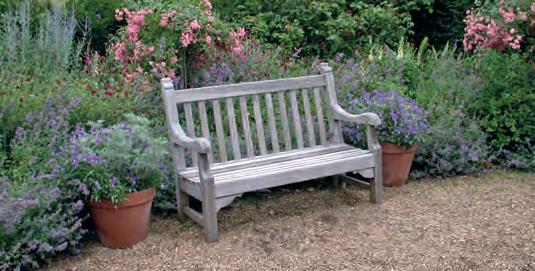


There are many people who just love foraging around the countryside in the late summer or autumn for wild blackberries and if the berries are picked in time they are so very yummy! But getting the right time is a rather hit and miss affair and this right time changes with each season so some years you may arrive to your favourite area to pick and find the berries are nowhere near ripe and some years you may find they are overripe or already picked! So the answer is why not grow your own blackberries at home or on the allotment and not leave the chances of eating a fine blackberry and apple pie to fate!
An additional benefit of growing your own is that you can choose to grow thornless varieties instead of having to fight with and through the vicious thorns of their wilder counterparts. Of course, you may deliberately choose to grow the odd vicious blackberry as a hedging plant to make your house or garden less friendly to would be burglars…… You can now grow varieties which aren’t as vigorous as the old fashioned blackberry which seem to grow at around a metre day at times and even primocane varieties which
you may deliberately choose to grow the odd vicious blackberry as a hedging plant to make your house or garden less friendly to would be burglars...

you can cut down each year and not have to worry about tying new growth in. You don’t even need to just grow the blackberries that we all know so well. Some new hybrids produce berries that are very large indeed and yet retain that wonderful blackberry flavour. There are other hybrid berries such as the tayberry and loganberry, to name but two, which are equally worth experimenting with.
The good thing about blackberries is that they will grow well in most locations apart from full shade although some of the hybrid berries prefer a sunny location. Soil is less of a problem and I find that slightly poorer soils - unless they are waterlogged - help slow down the growth rate of the more vigorous varieties.
As ever always buy your blackberries or hybrid berries from a reputable supplier as these plants are very susceptible indeed to carrying viruses so it is vitally important to start with disease free plants. The best time to plant is in late autumn or early winter using bare root plants although pot grown plants are available in some garden centres and can be planted at any time of year. Dig a planting hole - working over the bottom to eradicate any hard pan - about 450mm (18 inches) square and 75mm (3inches) deep - there is no need to plant blackberries too deep, the roots are shallow and tend to stay fairly close to the surface. Cover the roots with soil and firm gently with your foot. Add a layer of wellrotted manure or compost in March as this will help keep the weeds down and keep the soil cool and moist. You should also keep the area weed free, but be careful not to use the hoe too much, as blackberries have shallow roots and you can really damage the roots, it is far better to weed blackberries by hand.
When growing blackberries or hybrid berries you need something to train them along and if you don’t have somewhere to train these fruits, they will quickly grow out of control and be harder to prune and less productive. You can most certainly grow them along fences and walls using horizontal wires or just fanned out for effect. Alternatively, you can grow them on a post and wire system which is relatively easy to construct and is the best way to train blackberries or hybrid berries. You can do this by driving 2.5m (8feet) long and 75mm (3inches) diameter posts into the ground to a depth of 750mm (30inches) at 5metre (15ft) intervals. Stretch 3.5mm plastic coated fencing wire between the posts at 300mm (1foot) vertical intervals. You can now plant your blackberries or hybrid berries 2.5metres to 3.5metres (8 to11foot) apart along the

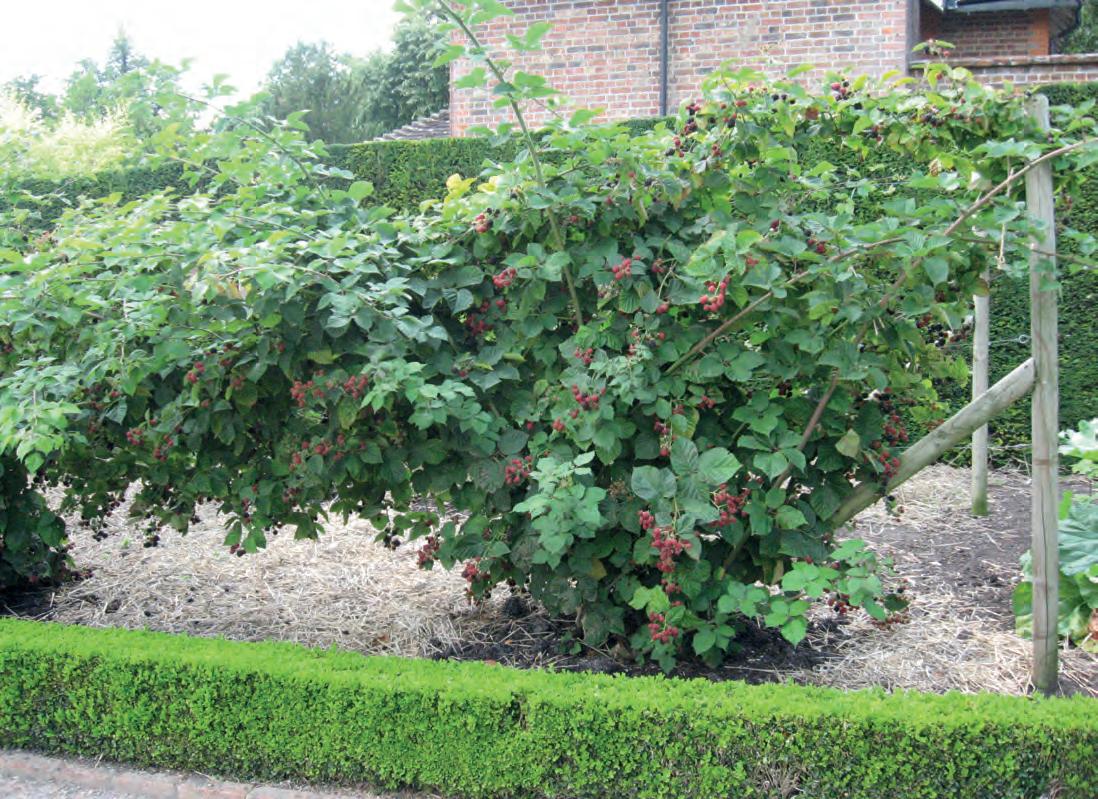
fence depending on the vigour of the plants. The most important thing to recognise is that the majority of these plants have considerable vigour in them, some far more than others though, so they all need an annual pruning and a training system planned for them. Pruning is carried out after harvesting in summer or autumn. As the new canes start growing the following spring and summer, they need to be tied into their supports. Fruit is produced on two-year-old canes (i.e. the previous season’s growth) so, to make things easy, keep this year’s fruiting canes separate from young new canes as the season progresses. Try tying the new canes in a vertical bunch in the centre (you can keep them tidy by tying them out along the top wire in bunches). Train the fruiting canes along the lower three wires, tying them
harvesting, and you should then take the bundled-up current year’s canes and train them along the lower wires to make space for next year’s new canes to be bundled in the centre. Alternatively, tie fruiting canes in one direction and the current year’s canes in the other. Sometimes the fruiting canes
are twisted around the wires in patterns to conserve space with very vigorous cultivars. Plants with strong, rigid canes that cannot easily be twisted around the wires can be trained as a fan, with the new growth bunched in the centre, as above.
As I noted earlier there are now some

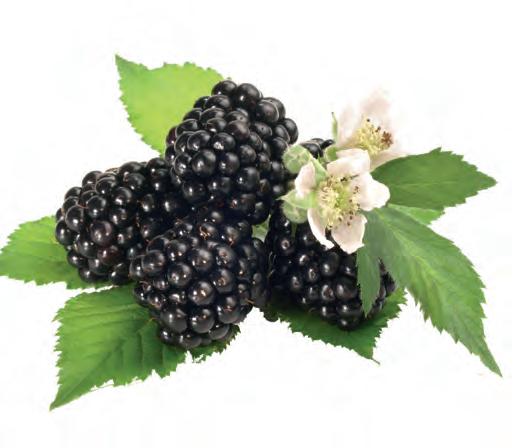 Blackberry trained along wires
Blackberry trained along wires
primocane varieties of blackberry around and these have the greatest of assets and that is their pruning technique. These blackberries are pruned just once a year in early spring when all growth is cut back to ground level. In times of drought you will need to keep your plants watered and once a year in early Spring I suggest that you give all of your plants a good handful of blood, fish and bone.
There are now a huge number of varieties available and suitable for the garden or allotment and between 2013 and 2015 I was one of the judges of a trial for these berries which was based at Wisley. Surprisingly some of those varieties did not produce outstanding results but some did. Those recommended for AGM’s (Awards of Garden Merit) areLoch Tay, Tayberry “Tayberry” (the original Tayberry) and Loch Ness. The others are worth experimenting with and I have added some notes from the Trials against them if relevant.
Black Butte is a relatively new variety which can produce berries up to 50mm (2 inches) The berries are rich and sweet and full of favour. Their main harvesting time is between early July and mid-August. The main drawback of this variety is that it is fairly spiny.
Chester is a good late season thornless blackberry which produces exceptional yields of high quality fruit making this blackberry one of the most widely grown blackberry
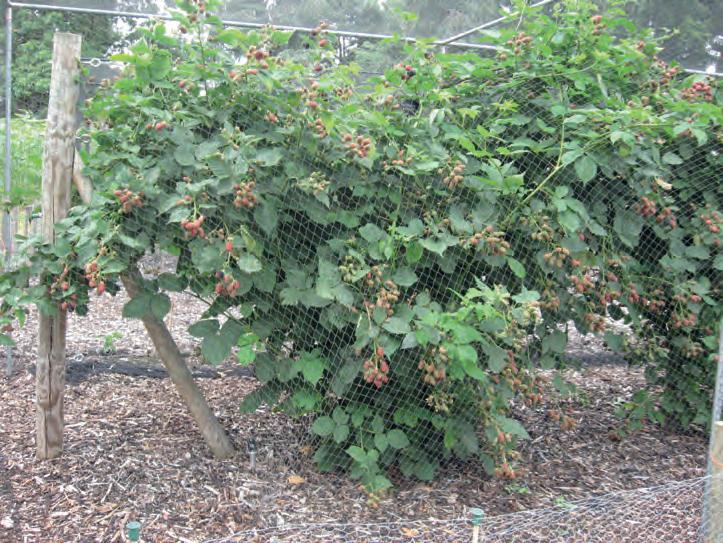
varieties in the country. Unfortunately, it is a very vigorous variety best suited to more spacious areas.
Karaka Black which originates from New Zealand is one of the sweetest tasting blackberries available as well as having an eye catching, elongated shape. These dark black fruits are very firm, have a good
blackberry flavour and have an outstanding shelf life. Karaka Black is the earliest high quality variety available. Picking commences in early July and can extend until early September.
Loganberry LY654 is a natural thornless mutation of the well-known loganberry. It is probably the best known raspberry x
Reuben - As well as producing extremely large and juicy berries, they are also incredibly sweet, scoring as high as many strawberries on the brix scale of sweetness. Fruiting from August to September they are delicious eaten straight from the bush.
The plants can be spaced closer together therefore increasing the yield potential. It is also suitable for growing in large pots. Height 1.8m (6ft) Spread 1m (3ft 4”).
Price: £12.15 Code:1354
‘Ruby Beauty’® -is simple to grow and maintain and should be treated in the same way as you would other summer fruiting raspberries, in that you cut out the canes once they have finished fruiting and allow the new ones to grow on for next years crop. We recommend planting one plant per 10 litre pot, or three per 40 litre container. Allow 70cm (2ft 4in) between plants when growing them in the ground. Supplied in 3 litre pots. Price: £17.50 Code:1068PG
Loganberry
Please
(Thornless) LoganberryRaised in 1881, this remains the most popular hybrid. Ripening from the middle of July, the fruits are medium-sized and dark red in colour and have quite a sharp flavour. The canes are only moderately vigorous. Requires 2.4m (8ft) of wall space. RHS Award of Garden Merit.
Price: £12.15 Code:128

Many seeds mentioned in June can still be sown this month for succession of crops. Radish, turnips, carrots and spinach are sown direct in to drills, winter cabbage and Calabrese either direct or in small pots, chicory, lettuce, kohl rabi and beetroot direct or in cell trays.
Seeds sown earlier in drills such as lettuce, carrots radish, beetroot and turnips will need thinning, assuming that most of them have germinated. This should be done in stages finishing up with the plants at the right distance for cropping – 2 or 3 inches for radish, 6 inches for beetroot and turnips and 6 to 9 inches for lettuce, depending on the type. In the case of carrots, don’t leave the thinning lying about as they will attract carrot fly.
I have written before about sowing crops in batches to avoid a glut. You should therefore have crops such as brassicas at different stages of growth depending when they were sown. I also mentioned sowing 3 or 4 seeds in small pots. This month you may have some recently sown ready for reducing to one per pot. You may have others ready for potting on into 5 inch pots and others ready for planting out and some further advanced still. Don’t forget to cover the bed with nets to keep the butterflies off. If you have cauliflowers already showing curds bend some leaves over them. This helps to keep them white and not turn yellow if they are exposed to the sun.
You should only start feeding though when the first tomatoes are visible. Cucumbers, peppers and aubergines can also be fed with the same product. Continue to remove side shoots on cordon grown tomatoes.
Things will need staking this month, the length of canes depending on the type of plants .Dahlias and chrysanths should have been tied to canes when they were planted. Brussels sprouts, sweet corn, outdoor tomatoes, gladioli and the taller types of annual flowers such as cosmos need 4 or 5 foot canes and smaller annuals perhaps 3 foot canes to which the plants can be tied.
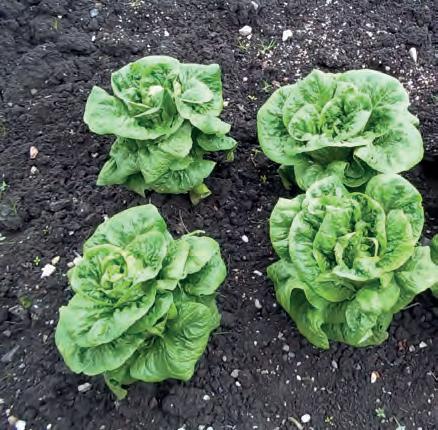
A good soak is much better than a bit at a time
If lettuce and other crops were sown earlier in cell trays they may need thinning to one per cell and others may be ready for planting. Other plants you may have for planting are leeks. These are normally planted in holes made with a dibber and the hole filled with water to settle them in.
This month and next month we may get some hot weather so make sure you keep your crops well watered. A good soak is much better than a bit at a time. Pay particular attention to crops coming into flower like peas and beans. If they go short of water at this stage the flowers may not set. Keep an eye open for pests and deal with them the best way you can either by the “finger and thumb” method or spraying. Taking the tops off broad beans helps to discourage blackfly. Also try to keep on top of the weeds by keeping the hoe going between the rows. Particularly get rid of weeds before they seed or the problem will be worse later
Feed tomatoes each week with a product specifically designed for them because they contain a high proportion of potash.
You can lift some of the onions and shallots if they are large enough. Spread them out on the greenhouse staging to dry or put them on a table in the shed as I do as I don’t have room in the greenhouse. Also you can continue lifting the early potatoes. I hope you have been spraying to prevent blight but you should keep your eyes open for it anyway. It starts with brown patches on the leaves. If in spite of spraying you notice some, cut down the stems (haulms) and get rid of them; don’t put them on the compost, though. The spores of the disease are washed down onto the soil and eventually affect the tubers making them unusable. Cutting down the haulms prevents this happening. You may as well dig up the whole crop because the tubers won’t grow any bigger after the haulms have been removed. Apart from those mentioned, you should have many crops ready for harvesting. Whatever the crops are, harvest them as soon as they are ready while they are fresh. As the crops are harvested you will have vacant ground. Just rake in a bit more fertiliser and sow or plant a ”catch crop”. I don’t have a special bed for salad crops. I just sow or plant them anywhere there is room such as this where other crops have been harvested.
A few jobs that can be done in the fruit garden now. Strawberries should be planted this month or next month. Strawberries are prone to virus diseases so I strongly advise you to buy certified stock from a reputable supplier rather than accept someone else’s spare plants. Don’t allow the plants to bear fruit till next year to allow them to get well established first.
Plums and cherries should be pruned now if they weren’t done in June. Remove raspberry and blackcurrant canes that have fruited. With gooseberries and red and white currants cut back this years side shoots to 4 or 5 leaves. Most apple and pear pruning is done in winter but cordon and espalier grown plants are done now in the South but in the North leave them till next month. Cut 9 inch (23cm) long stem side shoots back to above the third leaf and lateral side shoots to the first leaf.
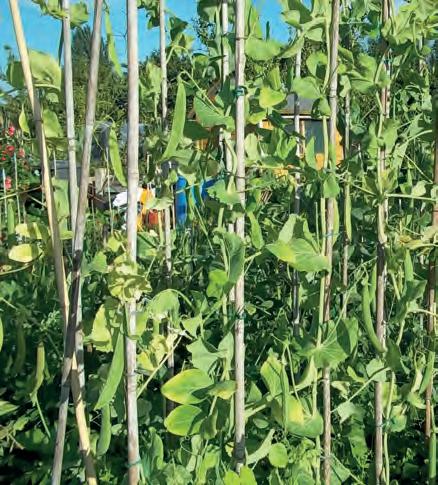

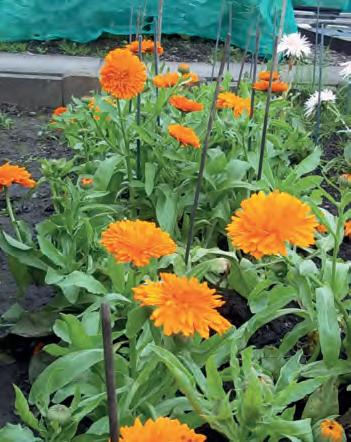
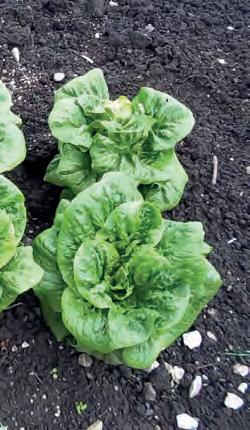

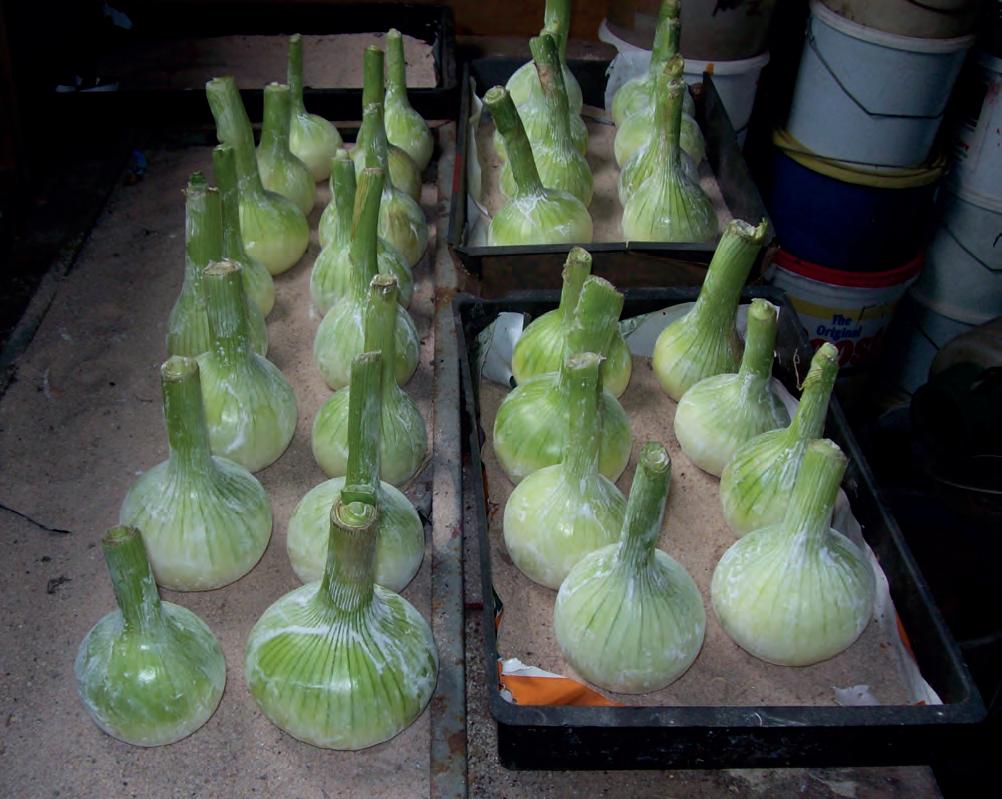
 Lettuce
Onions drying
Lavatera
Peas trained up canes
Lettuce
Onions drying
Lavatera
Peas trained up canes
The main sowing season is over but there are still some crops that can be sown. Some that have been sown previously can be sown again for succession such as lettuce, chicory, spinach, radish and Calabrese. Apart from summer radish, varieties for winter use can be sown. More cabbage and cauliflowers for winter use can be sown. Another subject for sowing now is corn salad, or lamb’s lettuce which is grown in the same way as lettuce and is more for winter use.
This is also the time to sow onions for overwintering, (usually called Japanese onions), and sprouting broccoli. The Japanese onions are grown in the same way as onions for summer use and the broccoli the same way as other brassicas. Neither will be ready for harvesting till spring. Japanese onions can also be grown from sets which are in the shops and garden centres around late September or October. More about these next month’s seasonal work.
solid or liquid form but at this time of the year I always use liquids that are diluted in the watering can as they are quicker acting. The proportion of each of these plant foods is always given on the container of bottle when you buy them. I am trying to simplify this for beginners but broadly speaking, crops that rely on flowers and fruit production such as peas and beans and the greenhouse crops mentioned earlier need a higher proportion of potash. Leafy crops like cabbages and lettuces need more nitrogen.
More plants may need staking and tying this month, and carry on removing side shoots from cordon grown tomatoes. When tomato plants have reached the top of the greenhouse, pinch out the tops. This stops the plants growing and producing more tomatoes that will never ripen and helps the fruits lower down to develop.
More plants may need staking and tying this month, and carry on removing side shoots
As mentioned last month because crops are sown at intervals for succession, seeds sown last month may need thinning out and some sown earlier may be ready for planting.
Also, as last month we may get some dry weather so make sure your crops don’t go short of water.
Crops will benefit from feeding but not if the soil is dry so always give it a good watering first. In the greenhouse, tomatoes, cucumbers, peppers and aubergines still need feeding with a product high in potash. Outside in the garden or allotment, different crops are fed with different products depending on what type of plant they are. For those of you who are not familiar with the different types of fertilisers, there are three major plant foods. To put it very simply they are nitrogen (N) mainly for leaf and stem growth, phosphate (P) mainly for root growth and potash (K) mainly for flower and fruit production. What are called “straight” fertilisers containing only one of these foods and “general” or “balanced” fertilisers contain all three but not always in the same proportions. They can be in either
In May and June I mentioned stopping chrysanthemums and dahlias (pinching out the growing tip). This should have produced several side branches, known as laterals, which will eventually produce the flowers.. These should be tied to the supporting cane. The earliest ones may be showing buds by now. With dahlias you just want one flower on the end of each stem. You will find a cluster of buds,-a central one and others surrounding it. These surrounding buds should be removed, just leaving the central one to flower. This also applies to chrysanthemum varieties that are grown for a single bloom on a stem. However, there are varieties that are grown as sprays. In this case you can remove the central bud allowing the surrounding buds to spray out or you can leave them to flower naturally without removing any buds.
Both chrysanthemum and dahlias will benefit from a high potash feed. Annual flowers should continually be dead headed to encourage them to keep flowering. Sweet peas should be cut regularly to prevent them seeding.
Strawberries can be planted if not done in July and the fruit tree pruning described in July can be done if it wasn’t done then.
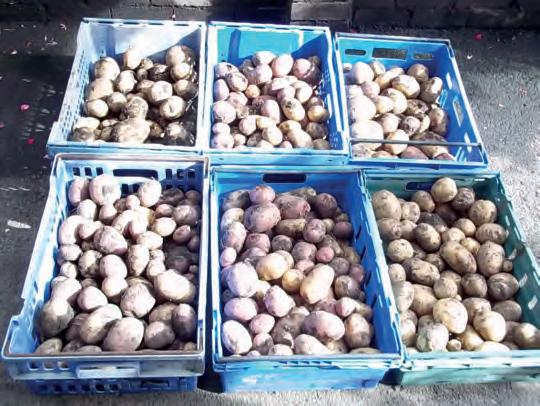
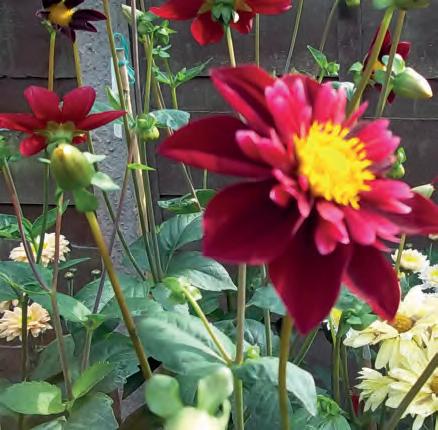

The last of the early potatoes can be dug up if not done before and there are many other crops ready for harvesting-too many to mention them all here. In particular, pick courgettes when they are about 6 inches long and pick beans while they are still young and tender. They get stringy if you leave them too long.
Lastly consider having a go at showing. Wherever you live there will be there is bound to be a local show somewhere near you, either this month or next. You will find it very enjoyable and rewarding, as I do, and you will make many friends.
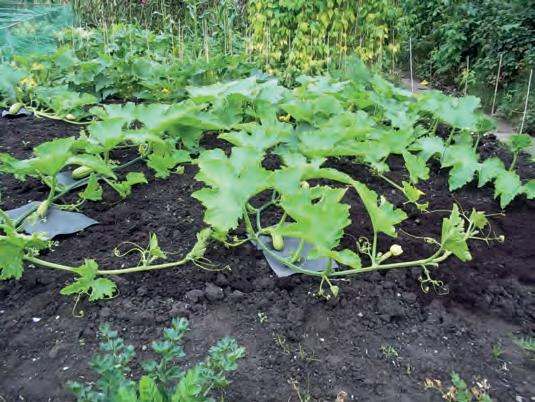
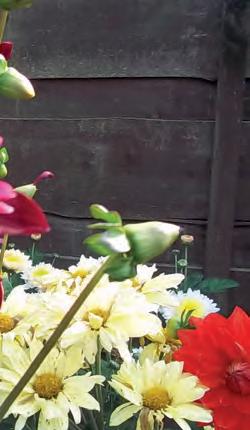
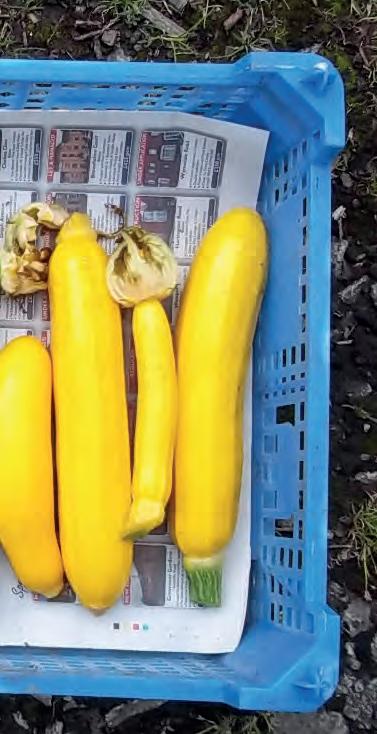
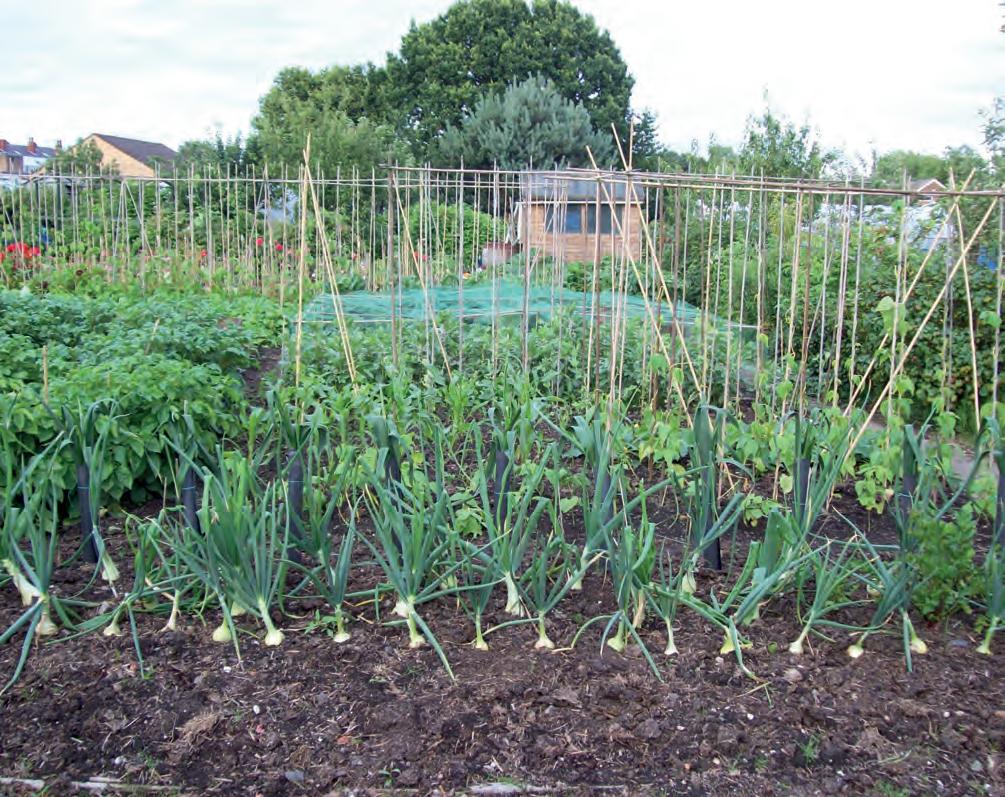
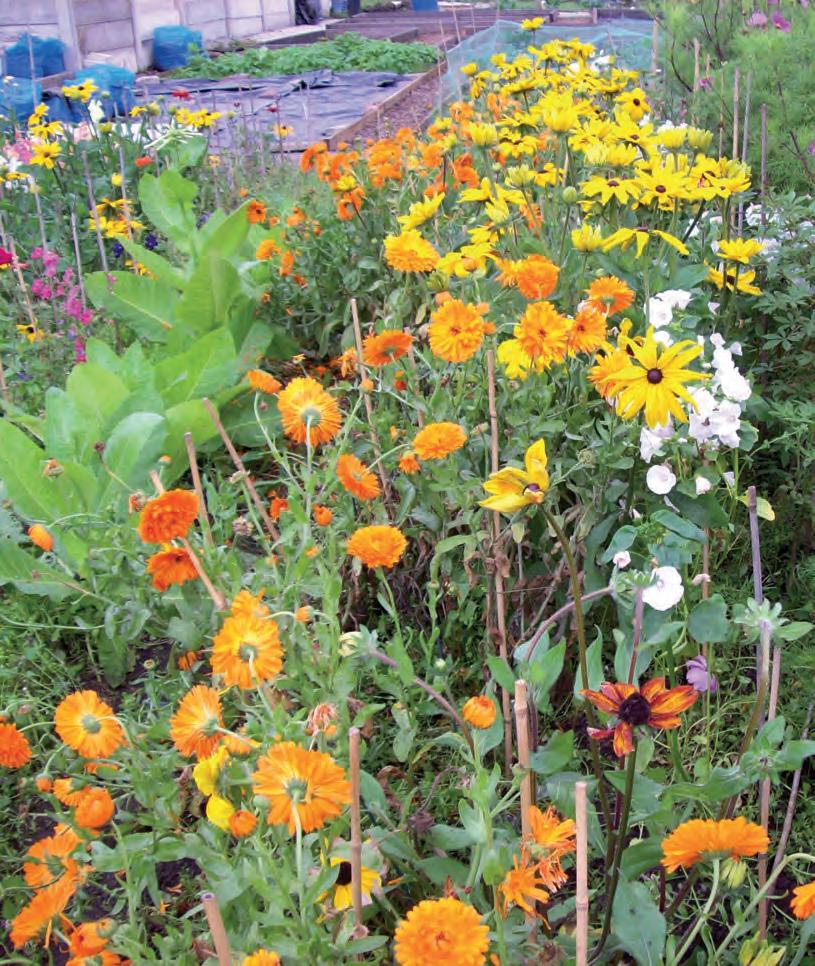


Most of the sowing is done for this year. The only crops I think are worth sowing now are some more lettuce and radish for winter use. The colder weather will be coming soon and I think that if you sow anything else now the plants will not have grown enough to be established before it arrives. If you have any winter brassicas raised earlier in pots, plant them out as soon as possible while the ground is still reasonably warm to help them establish.
I mentioned planting garlic in April but there are also varieties for planting now or next month. The cloves are planted in rows about 6 inches apart to be harvested in spring.
from now on. If you used Coolglass, as I do, wait for a dry day and it just wipes off with an old towel. To remove it from the roof I tie a towel onto a sweeping brush.
You should keep feeding tomatoes a bit longer yet as they should still be ripening
There are also varieties of onions for overwintering. I mentioned last month about growing some from seed. If they were sown outside in drills they will need thinning out now or next month. If they were sown in pots they will need thinning to one per pot then planted out when they are large enough, probably next month. These onions can also be grown from sets planted now or next month and this is how I grow them. They are in the garden centres and shops any time now. I plant them direct but not on the onion bed. They won’t be ready for harvesting until next spring or early summer. I manure the onion bed in winter and this wouldn’t be possible if there were onions in. I plant them on the edge of the brassica bed which next year will be the root crop bed because this bed isn’t manured and doesn’t all need digging over till the onions are harvested.
In the fruit garden, prune blackberries if not done last month. Just cut out the shoots that have fruited .It will soon be time to plant new fruit trees and bushes. They can be planted any time from November onwards but you may need to order them now. You will find them for sale at garden centres but you are likely to have a wider choice if you order them from a specialist grower. Seed companies sell them but there are companies that just specialise in fruit so send up for some catalogues or look on line. If you do intend planting some fruit you can prepare the ground by digging it now, removing any weeds and incorporating well rotted manure or compost.
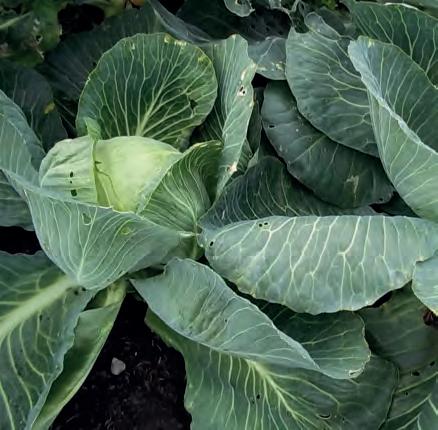
When crops are harvested, fork over the vacant ground, removing weeds
You should keep feeding tomatoes a bit longer yet as they should still be ripening. Pinch the tops from the plants if not done before.
Remove the shading from the greenhouse because now that light levels are getting lower plants need all the light they can get
Maincrop potatoes should be ready for lifting now and there are many other crops ready to keep your table well supplied and possibly your freezer full as well. Some vegetables will keep for a week or two in the ground if you don’t need them immediately, particularly cabbages and root crops. Most crops though need harvesting as soon as they are ready while they are fresh. I mentioned courgettes, peas and beans last month but the same applies to sweet corn. It loses flavour if left too long. You can test for ripeness by opening the cobs. The kernels should be yellow and if you burst one with your thumb nail the liquid inside should be milky, not watery.
When crops are harvested, fork over the vacant ground, removing weeds.
You still need to keep dead heading flowers to encourage them to keep flowering until frost finally puts an end to them.
Just another word about showing, if you don’t feel you are good enough to have a go

yet, visit some shows and have a look at the standard. Make a note of which varieties are being shown. Some varieties of vegetables which are excellent for the kitchen are not really suitable for exhibition. By visiting shows you can see the best varieties for this purpose and if you want to show, grow some of these varieties. I have heard it said that show varieties are tasteless and no use in the kitchen. Believe me, this is absolute nonsense. Grow some of them and see for yourself.
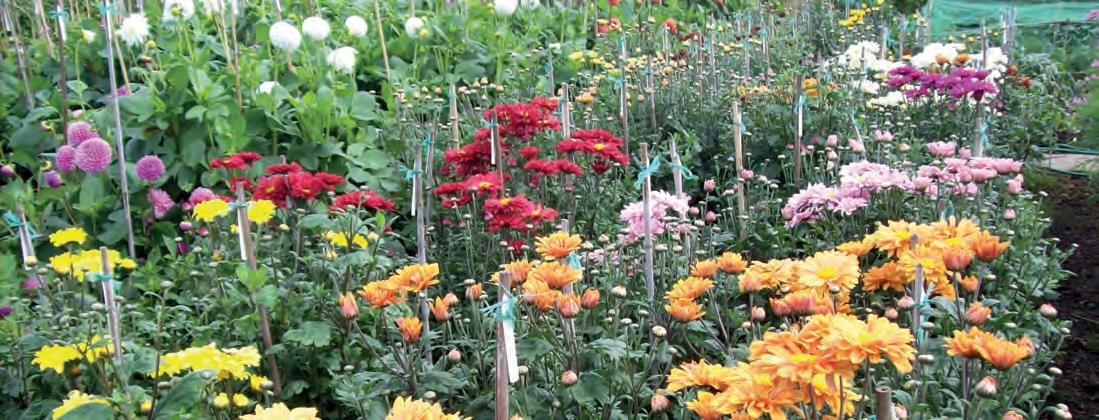

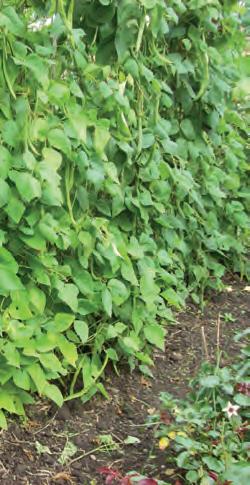
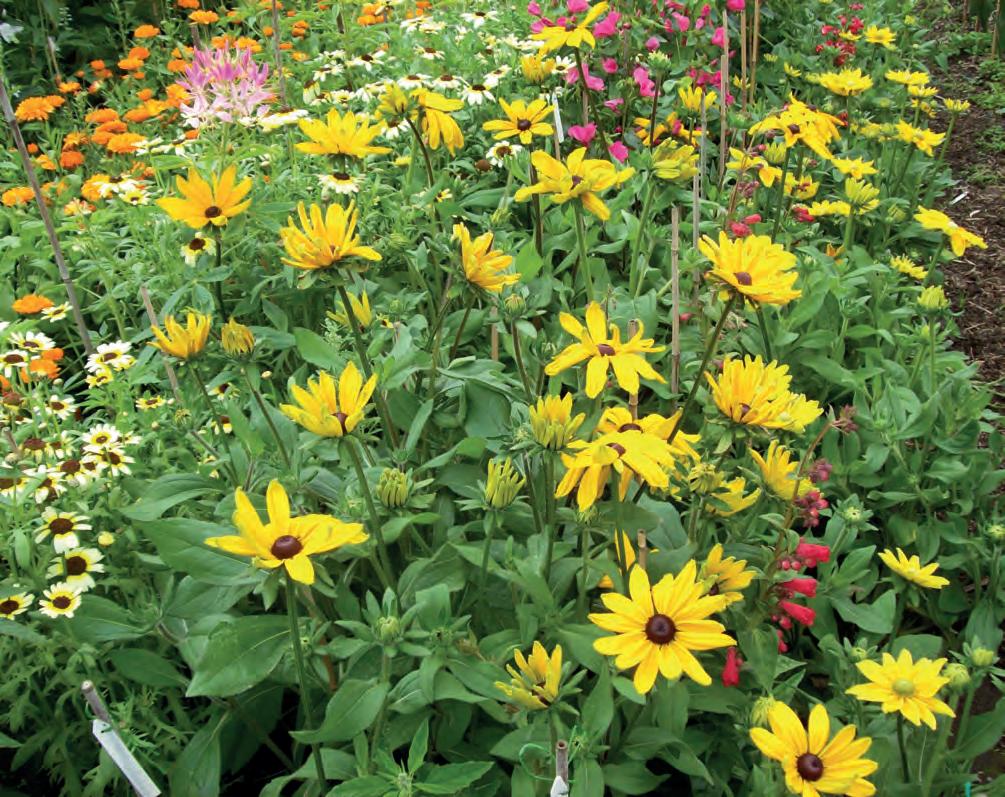
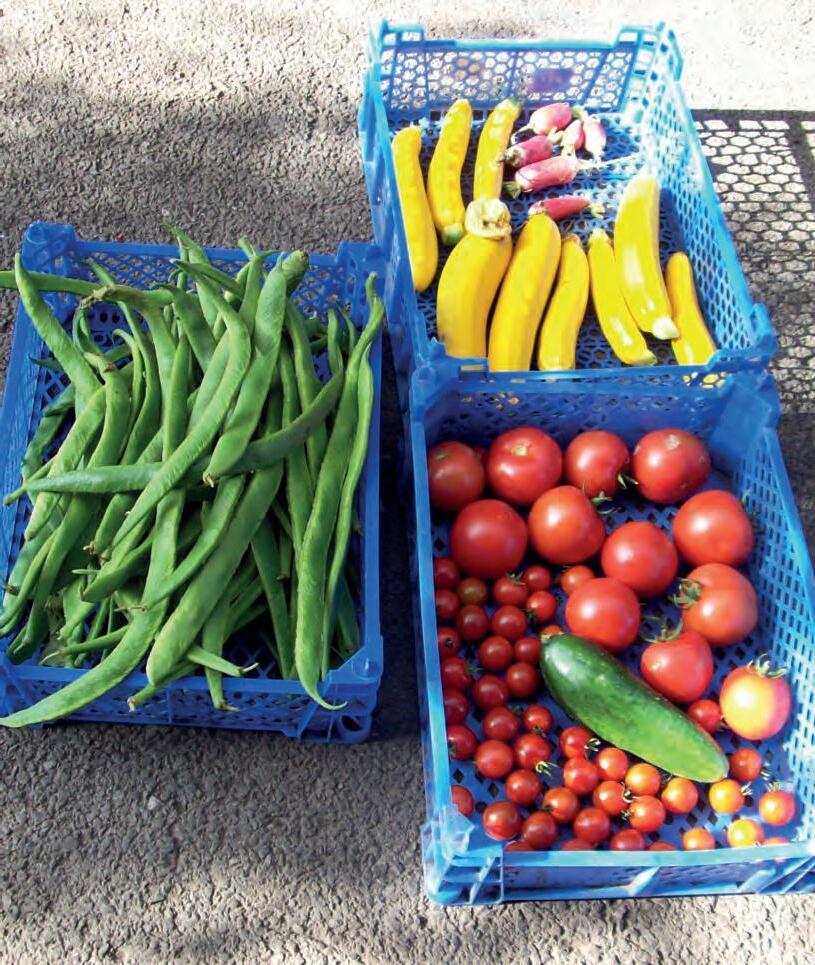

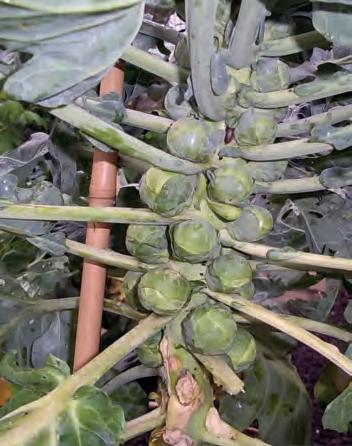
 By Kelvin Mason
By Kelvin Mason
In the last edition of Simply Vegetables I mentioned soil solarisation as a possible method of reducing or controlling clubroot disease of brassicas. In this article I will set out more details about the technique for those members who wish to give it a try.
Firstly I should mention that the U.K is on the edge of the climate area where soil solarisation will work; but if climate change continues it is likely to be given further consideration. It is used in areas of the southern USA, Australia, New Zealand, some of the Mediterranean countries (Israel) and possible some area of the Far East where it gives good control of some soil borne diseases and weeds. If we get hotter summers then it will work in the U.K especially if they become more consistent. It is both an organic method and sustainable so ticks many boxes.
Experimental work on soil solarisation has been going on since 1976 but only on small scale and is not widely used, although it is more common on organic farms in the USA. In some countries it is used on greenhouse borders to sterilise the soil before planting the tomato crop. It has also given very good weed control for up to a year after the treatment.
less good summers the lower temperature should be achievable in many years.
Soil solarisation will work to a depth of about 15cm to 20cm enough to get most crops established and growing well to produce a good crop. Any weeds, pests or diseases below this depth will not be controlled and they will migrate back up into the upper soil layers; but there effects are still substantially reduced for another year or so. There are no weeds in the U.K that will germinate form 15cm down and grow and the migration of diseases upward tend to be slow as most things move down in the soil carried by the soil water. Again there are few pests that go that deep in the soil so the vast majority should be killed.
Experimental work on soil solarisation has been going on since 1976
So what is soil solarisation, basically it makes use of the suns energy to heat the soil up to a temperature that will kill soil diseases, soil pests and weeds seeds – a type of soil sterilisation. The soil temperature required is between 40˚C to 60˚C, the higher the better and the longer the better. If 40˚C is not achieved the technique will not work and this is the problem in the U.K during some summers. During good summers especially from early June to mid-August it is possible to achieve these temperatures in the soil in the southern parts of the U.K. even in
Using the technique is fairly easy; the area of soil to be treated should be cleared of any weeds, crop remains and other debris. Then either lightly fork over the soil to a depth of at least 150mm and break up any lumps with the back of the fork or rotary cultivate the soil with machinery. It is important to break up any lumps as the heat takes longer to pass through large pumps of soil rather than a good tilth. The aim is to produce a fine tilth to 150mm to 200mm depth. If the soil is dry water it but do not soak it, just enough to wet it to a depth of at least 150mm so that the heat can conduct down through the soil. Dry soil does not conduct the heat as well.
Cover the cultivated soil with thin gauge clear polythene, large
If you make your own John Innes Composts or have your own recipes then soil solarisation is a method of sterilising the soil content of the compost (growing media in today’s language). It is important to only sterilise the soil part of the mix, as the peat or coir part should be sterile (for growing purposes) and can be badly affected by the heat. The sand / grit part of the mixture also should be clean so not needing to be sterilised. And if the fertilisers are heated up it can result in a fast release of much of the nutrients which can damage the plants roots.
Using soil solarisation to sterilise the soil for potting composts I think should work because the soil can be treated in thin layers and are likely to heat up to the required temperature even if the summer is not really hot.
This technique has been used in Australia and saves electric or steam which are both expensive and is a sustainable and organic method of treating the soil. The key points are similar to what is described above so I will not repeat these.
The soil which should be of good quality (loam is the best) should be broken up into a fine tilth or better still sieved which it should be before it is used in a potting compost and then spread in an even thin layer of 50mm to 100mm depth; in Australia they use 25cm layers but the summer temperature is higher over there. The Australians spread the soil onto a mobile bench which is easy to move to where they need it on the nursery and can place it in the hottest part of the nursery. It could be spread onto a concrete slab or similar surface as long as it is clean and in full sun. if your greenhouse bench is empty during the summer this could be an ideal area as it will easily get to the required temperature.
The Australians use 25 / 50 micron clear polythene as this they
say transmits the most solar radiation. The soil should be moist as this gives the best conduction of heat and kills the disease resting spores and a better kill of weeds seeds is achieved if they are damp. If the soil starts to dry out damp it over a little, under the polythene this should not happen as any moisture is likely to condense onto the polythene and run back into the soil. Leave the polythene in place for as long as you can to gain the maximum effect. The current recommendations are to use two layers of polythene with a 15cm gap between, a metal / wire frame is used to support the upper layer and the lower layer rests on the soil. They are still investigating the size of the gap to see what is the most effective.
Diseases controlled – the work in Australia has shown that the following diseases are controlled by soil solarisation Phytophthora, Pythium, Rhizoctonia, (the main causes of damping off), and some species of Fusarium, Sclerotium and Verticilium which are the most common diseases of plants in greenhouses and potting composts.
Weeds – soil solarisation will control many annual weeds and it is claimed some perennial weeds although it would need high temperatures and for a lengthy period to kill most perennial weeds. The following weeds have been controlled using soil solarisation:
Capsella – Shepherds Purse Chenopodium – Fat hen Fumaria – Fumitory Lamium – Dead nettle
Poa – Annual meadow grass Polygonum – Knotgrass
Senecio – Groundsel Sonchus – Sow thistle
Stellaria – Chickweed Urtica – Annual stinging nettle Groundsel is very temperature sensitive and only needs about four hours at 40˚C to kill the seeds. This is a reasonable range of weeds
sheets are better than narrow rolls which will require too many joins and are easier to hold into place so it does not blow away. Push the edge of the sheets into the soil with a spade and firm it with your boot. This secures the polythene in place and helps to trap the heat. Lengths of wood or metal laid along the edge can help on windy sites but do not cover the area to be treated as it will prevent the sun warming the soil.
Experimental work has shown that clear polythene is better than black or other colours (despite the fact that black absorbs the heat!) and that thin gauge sheets are better than thicker gauges as they seem to let in more of the suns radiation. Experimental work has shown that a double skin of polythene traps and holds the heat better than a single layer of polythene. It is better if the two sheets of polythene have an air gap between them to hold the sheets apart and this helps to trap the heat in the soil.
If the polythene can be laid in early to mid-June and left in place for 6 to 8 weeks the heat will work its way down to about 20cm depth if a warm summer; this will usually control pests, diseases and weeds to this depth.
Once the area has been treated by solarisation it can be lightly forked – no deeper than 15cm deep otherwise you risk bringing up un-treated soil, and then planted or sown with a crop.
As well as giving some control of various soil problems soil solarisation also releases some nutrients into the soil which are then available for the next crop, giving then a boost and some free nutrition. A similar effect also happens after soil is sterilised using steam.
How well this technique will work in the U.K is entirely dependent on the weather over the summer which as we all know is very unpredictable. But if climate change is happening, and most scientists think it is then soil solarisation should be worth a try. Experimental evidence shows it works in countries with a slightly warmer and consistent summer than the U.K and I feel it will be worth a try if your soil is suffering from soil borne diseases, pests or are taking over an allotment with a high seed bank of annual weeds.
If any members give it a go please let us know how you get on and if it works.
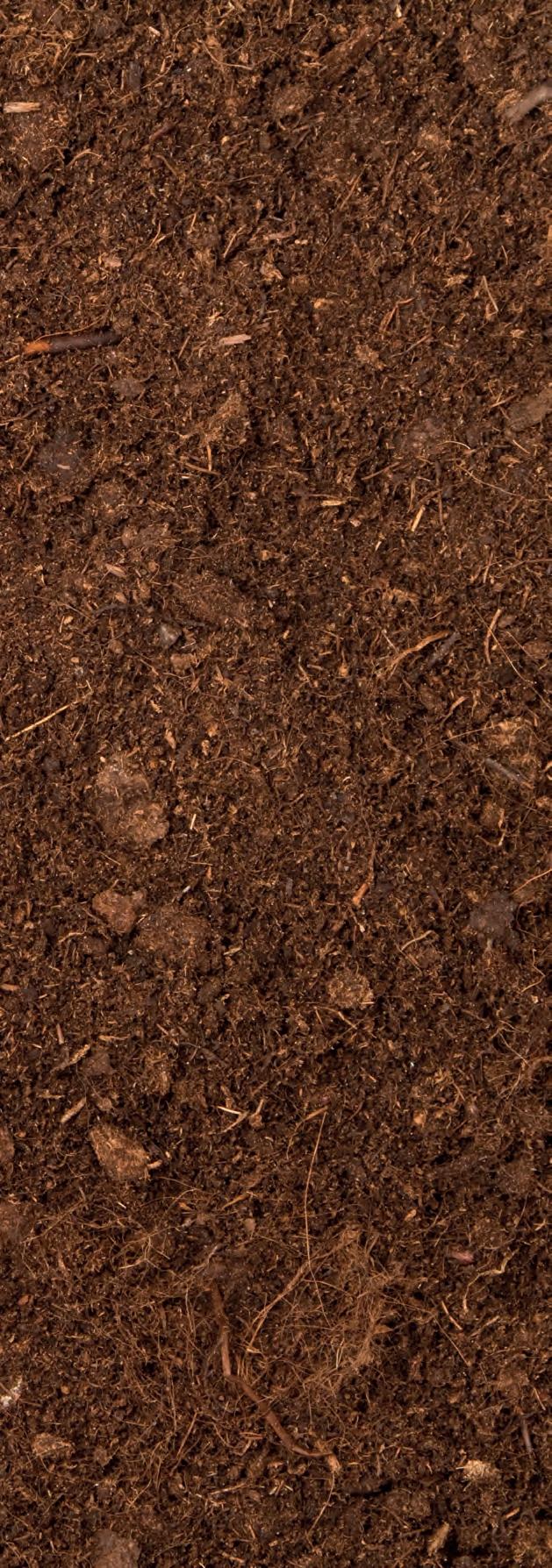

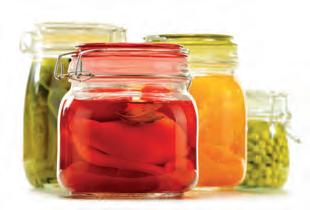
The summer months are when we often feel overwhelmed with all of the produce that suddenly ripen in unison. Jam is always the first option to turn to when you’re overloaded with berries but you can also make savoury versions such as tomato and basil jam. Slow roasted tomatoes and peppers make a delicious addition to most dishes so this is a great use of your excess produce. Kale or rocket overload can be avoided by making a tasty pesto. Fruit can easily be kept for later in the year by chopping it up and putting it in the freezer; the only problem is that fruit can go mushy when it defrosts so it is best to use this fruit in a crumble, pie or smoothie. Alternatively, fruit can be dehydrated and stored to keep as a snack.
Now you just need to stock up on jars before you’re drowning in a sea of fruit and vegetables!
Beth Cowanand it is likely it will control most if not all annual weeds.
Pests – soil pests and their eggs that are in the soil at the time of solarisation will be killed providing a decent temperature of 40˚C is reached and held for a period of four or more weeks. Soil borne nematodes such as root knot eelworm, cyst eelworm and some of the dagger eelworms can be controlled by soil solarisation and there are no chemicals on the market that are available on the amateur market that will control these pests. Although garlic sprays are reputed to give some control.
Growth Response – soil that has been sterilised by steam has an increased growth response compared to soil not treated with steam. This is believed to be owing to the release of certain nutrients held in the soil particular nitrogen, but it may also be owing to the removal of various pathogenic fungi, bacteria or virus and the fact that the soil is recolonized by the beneficial soil microorganisms before the pathogens. The following nutrients have been released from the soil organic matter by soil solarisation nitrogen, calcium, potassium, magnesium and also fulvic acid that seems to be becoming more widely available but exactly what it does to improve plant growth I am not sure – a topic for another article!
I feel the advantages of using soil solarisation for potting mixtures is worth a try as keeping the layer of soil to 10cm with two layers of polythene during the height of the summer should give good pest and disease control. If any members give it a go please let us know your results.

HS French Flint’s range includes Mason, Le Parfait, & Kilner jars for storage and home-preserving applications; Glassstoppered jars; Cork-mouth, Twist-off and Screw-neck bottles & jars; SwingStoppered bottles; Craft beer bottles & Growlers, and Old fashioned milk bottles.


Every time I write this column I seem to make reference to the weather. Well this one is no different! As I write it the last week has been glorious with wall to wall sunshine however it has now turned cold, dark and grey. But that’s Scottish weather for you. As regards my own plants I am at least 2 weeks behind planting out onions and leeks as the weather has been bitterly cold at night. Linda and I were up in Inverness at the end of April to give a talk to the North of Scotland DA and when we woke up in the morning it was minus 3 and snowing! I must make mention of the DA as they are really pushing the Society in the farthest reaches of the country and making an excellent job, with a tremendous team. One of their members had travelled from the Orkney Islands with his wife which involved 2 ferries and a long drive plus overnight stay to attend the meeting - that’s dedication. In May we had a good day at Threave Gardens, Castle Douglas where we put up a display as part of their vegetable day. Quite a bit of interest was generated
As regards my own plants I am at least 2 weeks behind planting out onions and leeks
but the highlight must have been Jim Williams snail racing - maybe a new career here Jim. On a sadder note we lost one of our long standing members, Len Jamieson. Len was an integral part of the Branch and the Dundee DA, where he had served as Chairman. Our thoughts are with his wife Hettie and his family. I was also really saddened to hear of the passing of Maureen Robinson. Maureen was such a lovely lady and came up to the Scottish Championships and the seminar with Jim. To me she and Len were what the Society is all about - people giving up their time for others and enjoying the friendship that the NVS brings. So it`s now a look forward to the rest of the year with lots of travel starting with our Championships at the end of August in Aberdeen. Our seminar programme has been finalised and we look forward to yet another great day with a larger number of commercial companies, good speakers and most importantly good company.
Ian
As part of the Scottish Branch’s ongoing partnership with the National Trust for Scotland School of Heritage Gardening, a vegetable open day was organised on the 8th May at Threave Gardens Castle Douglas. A wide range of activities were undertaken on the day in conjunction with the gardens staff and the 6 students currently studying at Threave, including making vegetable animals, exotic vegetable display, old tools trail and the highlight snail racing hosted by Jim Williams. A small vegetable display was also staged. The weather was glorious with the whole day being sunny. A lot of interest was generated particularly by the children attending who wanted to see snails racing. The photo attached is also of the 4 big kids from the Scottish Branch who were also engrossed! Our thanks go to Colin Wren, the gardens staff and the students for an excellent day and we look forward to our continuing work with the school and the students. Ian Stocks, Scottish Branch Chairman.
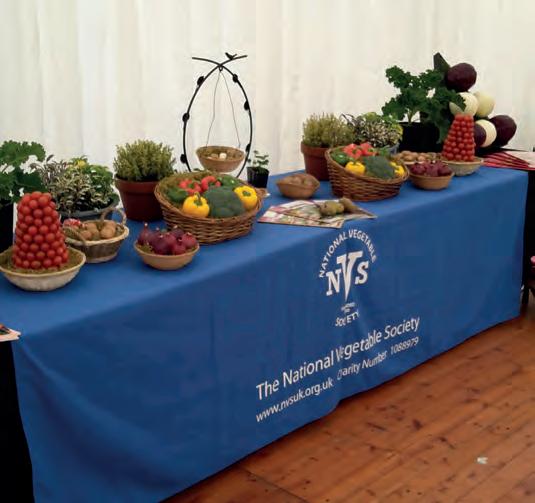
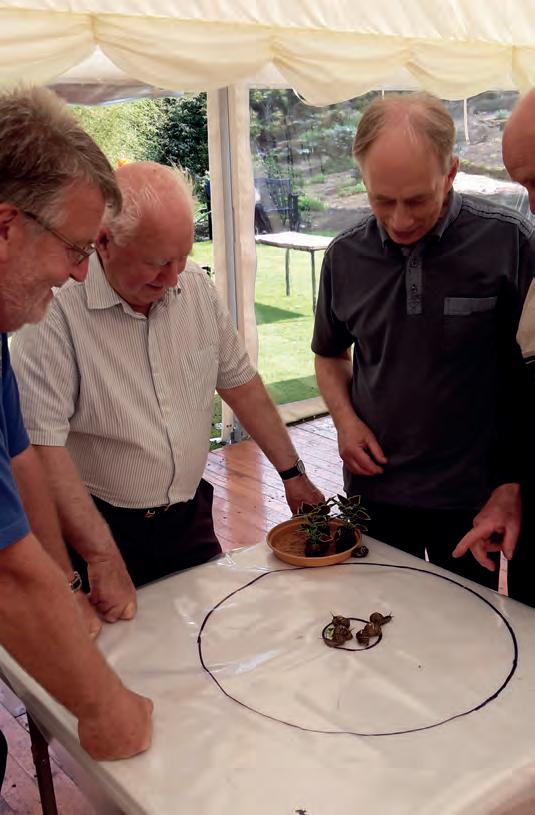
I’m pleased to report that our AGM was held on the 12th March. Ian Stocks continues as Chairman, with Fiona Shenfield as Secretary and Linda Stocks as Treasurer. Linda reported on the accounts, confirming all had been submitted on time and thanked the hard working DA’s for their timely submissions.
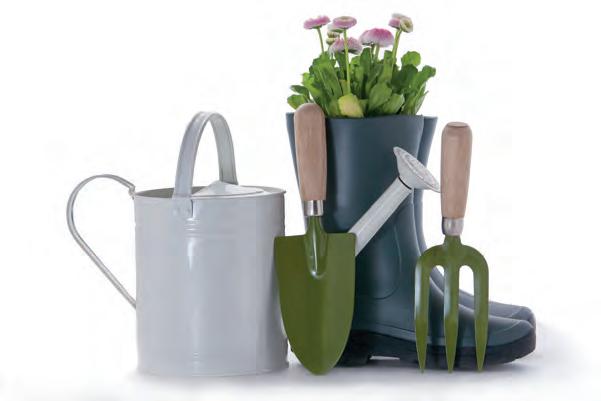
Following on from their successful National and Branch Championships Frank Taylor, Show Manager and Neil Muirhead, Show Secretary are already working hard to prepare for the 2016 Scottish Branch Championships in Aberdeen later this year supported by our Sponsor Manager, Gareth Cameron who, with his feverish activity is ensuring the Scottish Branch Championship’s sponsorship remains in safe hands.
Two changes were made during the AGM with our office bearers which have seen Fred Stewart take over the role of Membership Secretary as temporary cover for Jean Thomson, who is taking a year out and Fiona Shenfield has stepped into Jim William’s shoes as the new Scottish Branch Newsletter Sub-Editor (big shoes to fill, so wish me luck). Both nominations were accepted by the Committee and these changes have been initiated.
If anyone is interested in joining the Scottish Branch Committee, or would like to come along to a meeting as an observer then please contact one of the Committee members. (contact details can be found on the NVS website and the NVS Directory). Our hard working, Committee members continue as a strong group of likeminded individuals who’s banter and humour is also second to none. Sadly we missed a few key members at the AGM due to health reasons and we wish them all well on their road to recovery. Our Honorary Vice President, Peter Guthrie, who is still unwell was unable to attend, as was Alistair & Mary Gray as Alistair had suffered a heart attack just the week before. However I’m happy to report that both Alistair and his veg are doing well, under Mary’s watchful eye and expertise and a wee bit of hard labour from his family.
Sadly, since our AGM, we lost one of our members with Len Jamieson’s passing. He will be greatly missed.
The Scottish Branch Office Bearers for 2016/2017 are noted here for your information.
Scottish Branch President Jim Williams
Honorary Vice President Peter Guthrie
Chairman Ian Stocks
Vice Chairman Alan Manning
Treasurer Linda Stocks
Secretary Fiona Shenfield
Membership Secretary Fred Stewart
Show Manager Frank Taylor
Show Secretary Neil Muirhead
Sponsorship Manager Gareth Cameron
Newsletter Sub-Editor Fiona Shenfield
The Scottish Branch continues to strive for new ways of providing guidance, education and learning about growing vegetables in different ways and with this in mind, the Winter months saw us embark on two new projects;
1) The production of six “growing booklets” on exhibition veg growing, namely Cauliflowers by Jim Pearson, Long Leeks by Alistair Gray, Peas by Jim Gradie, Potatoes by Joe Proudlock, Stump Carrots by Ian Simpson and Long Carrots by Ian Stocks. This idea resulted from the positive feedback of our home grown lecturers at the Scottish Branch Annual Seminar. An initial small quantity of booklets have been published to be available at the Scottish Branch stand at Gardening Scotland in early June, followed by further Scottish Branch events throughout the year. A feedback review of the booklets will take place during our October Committee meeting re success/continuation/widening of sales/ potential future booklets etc.
2) A trial electronic Newsletter to capture local events and news (as a local addition to the website and SV magazine). If you are a Scottish Branch member and you wish to contribute or receive a copy of this newsletter then please contact Ian Stocks (ian.stocks@blueyonder.co.uk).
Fiona Shenfield
Scottish Branch Secretary & Newsletter
Sub-Editor
July 10th
August 27th & 28th
October 1st
October 1st
November 19th
Over the past three months we have had the privilege of some tremendous speakers at our DA. As a recently formed DA we decided early on that we would try to embrace all the gardening fraternity and our syllabus for winter meeting includes talks on cut flowers, pot plants as well as vegetable growing both for the kitchen and the show bench. Like a lot of areas there has been a decline in growers and exhibitors at many local shows, to the point where the autumn show at Inverness has been discontinued.
At our February meet we had Bruce McLeod talking on cut flowers and pot plants. Bruce is a prominent growers and exhibitor from central Scotland and gave a very interesting and humorous talk which was much appreciated by all who attended. This was followed by a very well attended March meeting where Ian Simpson & Fiona Shenfield gave a superb talk on the growing and showing of legumes. Followed by a seed sale, from Ian’s re selected stock which proved to be very sought after. Our most recent meeting in April was also extremely well attended with over 20 members attending. This included Brian & Ann who travelled from Orkney to attend this meeting. Our speaker was Ian Stocks, the Scottish Branch Chairman who gave a great talk on “the road to Dundee”, his growing journey to the 2015 Nationals held at Dundee. This included his success stories, (Celery, Parsnip, and Stump Carrot) and not so successful Onion, Blanch Leek & Pot Leek. Again we had a number of seeds provided by our speaker and had a really good club raffle.
As a group we will hope to undertake our own summer garden visit and have suggestions to go to Beechgrove Garden also further north to Castle & Gardens of Mey. A decision has yet to be made. We also promoted the NVS and Vegetable gardening at the Inverness Branch of “Howdens” on 29th May where we were in attendance to help customers with any growing problems or advice they may require. We were also selling NVS booklets and promoting our NOSDA fund raising quiz.
John (Hoss) Martin, NOSDA Chairman
Scottish Branch - Annual Garden Visit - Kailzie Gardens – start 10.30am
Scottish Branch – Championships - Duthie Park, Aberdeen
Scottish Branch - Placeholder for Judges exam (currently insufficient applicants this year)
Scottish Branch - Committee Meeting - Auchterarder, 2pm
Scottish Branch – Seminar - Pentland Science Park, - Registration 10.00am
Please note that there has been a significant change to this year’s theory examination.
Sections A and B will be similar to previous year’s format, but in section C, there will no longer be a choice of twelve questions from a total of eighteen.
Section C will only have twelve questions, and all twelve must be answered.
The judge’s examination panel feel that this will give a truer reflection on the candidate’s ability and prevent any bias in selecting similar type questions.
If any candidates for this year’s examination have any queries or questions please contact Jim Williams.
Please also note that the Rules & Instructions for the conduct of the Judging exam have also been updated and Jim Williams has sent a copy to each Branch Secretary to ensure consistency across the branches.
Jim Williams Chairman of the Judges Examination Board & Scottish Branch President
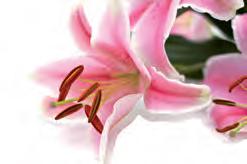
It is with great sadness to report that Len Jamieson sadly passed away at the end of April after a short brave fight with Cancer. Len, originally a Butcher to trade and subsequent member of the Armed forces, joined the N.V.S. member in 1994, becoming a Scottish Branch Committee member as well as an N.V.S. Judge. Len’s infectious involvement in learning and sharing knowledge about vegetable growing spread far and wide. This included his involvement in a number of Societies and Groups, during which he held the position of the N.V.S. Librarian, the Dundee & East D.A.’s Chairman (along with his wife Hettie, who also held the post of Treasurer and Show Manager). Len was also a Committee member of the Dundee Federation of Allotments, represented the Scottish Branch working with Dundee Council and was a rep for his local Allotment Society, to name a few. Len was also awarded an NVS Silver medal in 2011 in recognition of his work for the Society. Len’s welcoming smile, enthusiasm and tireless work will be sadly missed by all his friends in the Society.
Supporting your local shows is vital in ensuring that we continue to encourage existing growers and nurture new growers to preserve our passionate hobby of growing veg.
We have therefore listed some dates that we have collated from our Scottish Branch members regarding affiliated Societies shows which we hope you find useful. There’s nothing worse than having veg that’s ready too early or too late and it never makes it to a show bench or finding out too late about a show that you could attend. So go out and support your local shows …… it’s where it all begins and how it all continues. As the list grows, we will continue to update the N.V.S. website and our trial electronic newsletter for you, so watch out for more updates in the following months.
Ayr Flower Show AyrshireRozelle Park5th , 6th & 7th August
Carnoustie Flower Show AngusCarnoustie Leisure Centre 12th August 3-8pm & 13th August 10am-4pm
Cupar Flower ShowFife Corn Exchange 13th August
Gifford Flower ShowEast LothianVillage Green20th & 21st August
Musselburgh Flower ShowEast LothianBrunton Hall27th August
Peebles Horticultural Society Annual Flower Show PeeblesWalkershaugh, Community Centre (Drill Hall) 27th August 2pm-5pm 28th August 1pm-3pm
Aberdeen GrampianDuthie Park27th, 28th August Dundee DundeeCamperdown Park2nd, 3rd, 4th September
Dalgety Bay Horticultural Society annual show FifeCommunity Centre & Dalgety Parish New Church Hall 3rd September
Dalkeith Flower ShowMidlothianDalkeith School10th &11th September
Fife Flower Show FifeDobbies Garden world, Duloch Park, Dunfermline 17th &18th September
Gourock Flower ShowGlasgowCardwell Garden Centre 24th &25th September
Date Saturday 19th November 2016
Venue Pentlands Science Park, Bush Loan, Penicuik EH26 0PZ
Cost £10
Once again, the Scottish Branch has been working hard to provide a wide variety of topics for this year’s Annual Seminar. In addition to the speakers noted below, there will be the usual opportunities for meeting up with old friends and meeting new friends, learning new methods and ideas, bulk sales order pick up, (organised through Arthur Provan with the support of Clydeside Trading Society….watch out for your order form in the next Simply Veg edition). Also the following Companies will be in attendance with display stands, to talk to you, provide advice and information plus present products available for sale as well as listening to valuable growers feedback. This year, companies attending, at time of going to print, include Airpots, D&M Promotions, Plant Magic, Charge, Premier Hydroponics, Auto Pots, Shield your Yield & Chili Lab. The Seminar also gives you the opportunity to re-new your N.V.S. membership as well as joining the 200 club on the day. This year’s programme is listed below, we hope to see you there.
10.00 Registration, Tea & Coffee
10.30 Kevin Fortey - Giant Vegetable Growing
12.00 Fiona Shenfield - Branch and National Show results 2016
12.30 Lunch
13.30 Dean Finlay, Chili Lab - growing Chillies
14.30 Neil Muirhead - Growing in a small garden
15.00 After noon Tea
15.30 Ian Simpson - Growing Legumes for exhibition

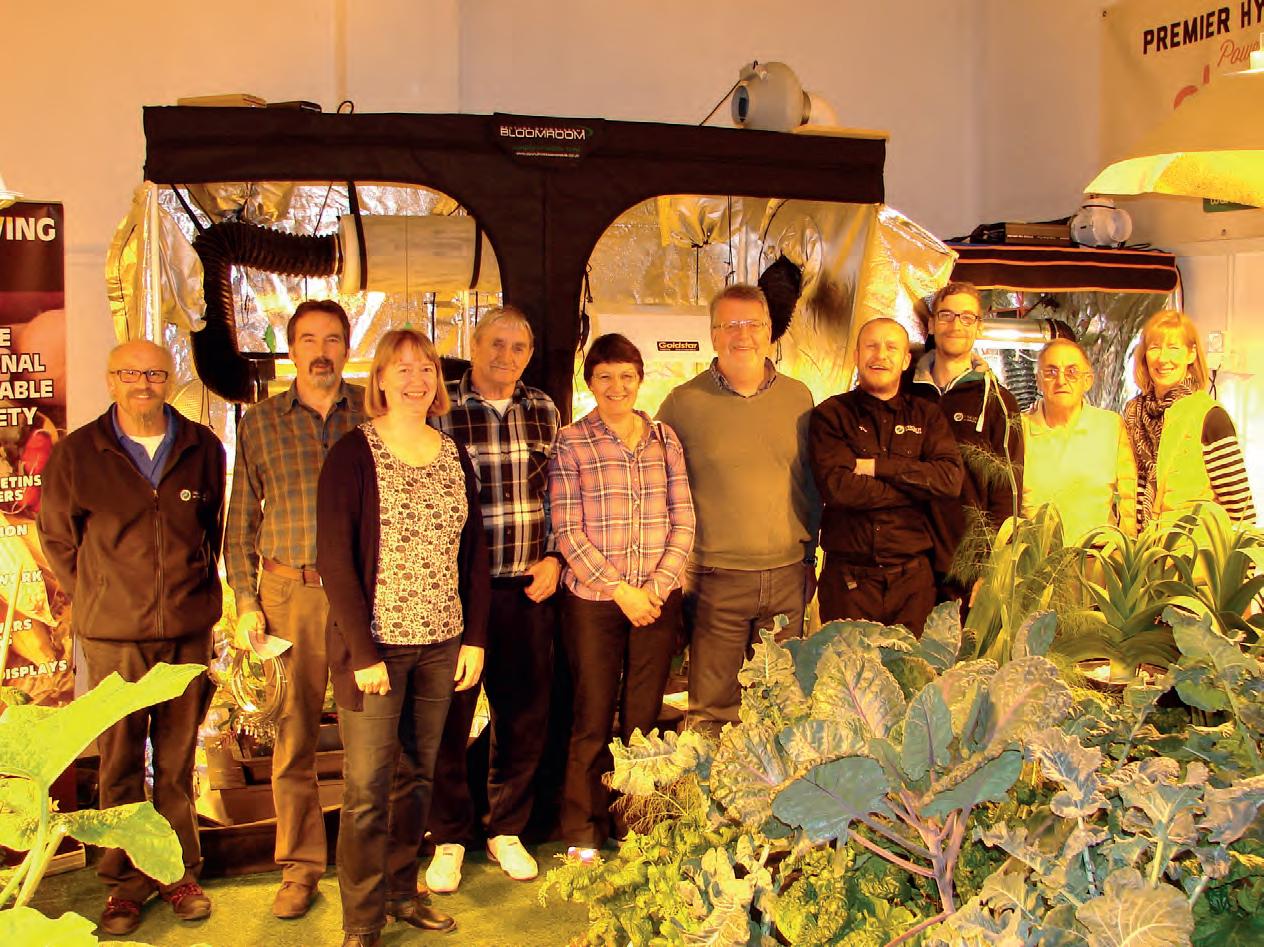

The 200 Club is a great way to support the Scottish Branch with all participants having a chance to win in our prize draws for 10 months of the year. The 200 Club, now in its second year, was started by our Sponsor Manager Gareth Cameron, who does a great job working tirelessly and networking to generate funding & sponsorship for the Society.
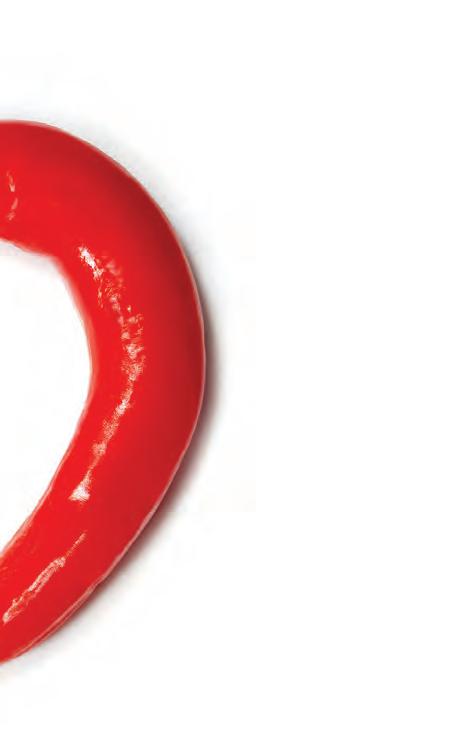
If you would like to become a Scottish Branch 200 club member, you can join any time by contacting Gareth. (Gareth’s contact details for your information mail: 2 Dyke Nook, Yeathouse Road, Frizington, Cumbria CA26 3QL, Telephone: 01946 811797 or email: garethattheplot@hotmail.co.uk
2016 prize winners from time of going to print. Note; prize money varies each year dependant on the number of 200 Club members.
Month First Prize ( £30)
January Fiona Shenfield
February Les Blacknell
March John Bar nes
April John Currie
Second Prize (£7)
Neil Muirhead
Rab Davidson
Jean Thomson
John Ranson
Visit to Premier Hydroponics
Further to Premier Hydroponics displaying & presenting at the Scottish Branch Seminar in November 2015 and the two articles on alternative growing methods posted in the Winter 2015/2016 & Spring 2016 editions of the Simply Veg Magazine by Ian Stocks, Scottish Branch members had a great visit to the Premier Hydroponics open day, in Broxburn on the 20th March. Those who attended were treated to a tour of the grow rooms to see a wide range of vegetables being grown, including large exhibition Onions, pot leeks and Goldstar tomatoes plants.
Gavin Thomson & his team provided wonderful hospitality with sandwiches, cakes, biscuits and drinks and some interesting conversations and discussions were held on the various growing methods being used, plus the chance to make a few bargain purchases and take away some very strong Goldstar tomato plants.
Premier hydroponics have been working with the Branch and are helping to promote the NVS with membership application forms on display and books available for purchase, sold on our behalf.
Scottish Branch members also had a day of bargains at CTS’s open day Kirkmuirhill on the 2nd April. CTS work together with the Scottish Branch stocking a wide range of products and whilst they supply bulk as trade suppliers and support our large orders organised via Arthur Provan for the Seminar, our members can buy in one’s and two’s. On the day, refreshments were provided including some delicious homemade cakes. The usual NVS Branch members discount of 20% was increased on the day to 25% which made for a good day out.
At the time of writing we have seen the weather change from -2˚C with snow, and up to 25˚C during one week in my area. It’s no wonder our farmers can only crop grass. We, however, can manage our crops better by using greenhouses and polytunnels to keep plants warm, and by shading and ventilating to keep them cool.
I planted my exhibition onions into the airpots during early April. They are looking good but, I have a big problem with rats burrowing underneath them. The ground was so wet with floods during March that they have come out of the drains and are tunnelling into the beds and compost heaps to start their families.
I have a big problem with rats
At our recent trustees meeting, the results of the previous meeting with Hannah Lloyd were discussed about the way forward and several points were highlighted as you will see in news from the trustees by Mark Hall. During the meeting our secretary David Thornton announced his resignation from the post due to a
As many of you will know my other passion alongside growing is the countryside and everything in it. I quite often ask myself just how much do we, as passionate growers, show the same passion for our surroundings?
I sat the other day on a small bench at the side of the pond we dug two years ago on our allotment, quietly pondering at the end of the day. The pond now quite mature and full of tadpoles and native aquatic plants are now well established and providing colour for us to admire, there real purpose however is to give cover for the all the bugs in the pond.
I suddenly sensed a little movement at the other side of the pond and for the next few minutes I was treated to a thrilling (for me anyway) spectacle as a stoat went around the pond, searching I presume for its next meal. These little creatures are quite vicious and can easily kill a rabbit, which is probably why we don’t currently have a rabbit problem on our site. In a flash it had gone, but such a wonderful site to see its beautiful chestnut coat in the evening sun, what a treat!
We are in a lucky position on our allotment being in a rural area on the edge of the town and fields. But any site can attract wildlife if the right conditions are provided. It doesn’t need anything spectacular just an area left wild, maybe with the odd log pile, heap of leaves or a pile of rotting wood which all provide a great habitat for many of the friendly predators which help to maintain the equilibrium of the countryside.
In fact all this can be done on a very small scale right in your own plot, a square metre of ground left uncultivated can with some of the facilities I listed above attract all sorts of wildlife helpful to the gardener.
Michael Osborn, Northern Sub Editor
conflict of interest as he had entered the seed business. Sadly, we heard the news a few days after the meeting that Maureen Robinson had passed away. Mo was the secretary of Westmorland and N.lancs DA and a member of Lancs DA committee, a stalwart of the Northern Branch committee and will be greatly missed. Her funeral was well attended by family and friends and NVS officials, and she had a good send off.
A good road show was attended by officers from Lancs and West Yorks DA s at Calderdale allots. social night resulting in a few new memberships. More of the same to be held at Blackpool, Knowlsley Garstang and Stanley later in the year and displays at Holker Hall, Great Yorkshire, Tatton Park, Derbyshire and Southport to advertise the NVS. If your allotments federation is holding an agm. and would like a road show presentation from the NVS, give us a shout and we will try to oblige. Good growing.
David Metcalfe, ChairmanSince the issue of Simply Veg, NEDDA have hosted several speaker evenings. In February NEDDA played host to Doug Bradbury. Doug gave us an insight into “The Life & Times of a Farrier”. The night was well attended and everybody was well entertained by Doug. Along with an insight into his life’s work, he provided numerous Farrier artefacts from the bygone days for which he had a story to tell about each one. Not sure how far Doug is willing to travel, but he’s definitely worthy of a spot at any DA meeting.
Mick Poultney provided us with a detailed insight into raised beds and the no digging concept. Mick’s reputation must precede him, the word must have got out because our meeting room couldn’t have held any more folks. I’m not really sure whether it was Mick’s reputation that brought them all in or just the ‘no digging’ concept. Only joking Mick, I can assure you that it was you who
brought all the punters in. Many thanks for the tips, the very informative night and light hearted entertainment.
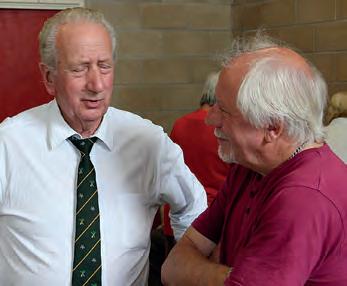
Planning is well on the way for the Vegetable Displays NEDDA will be putting on at the Derbyshire County Show 26th June & Bakewell Show 3rd/4th August. Our Road Show will be on display at both events which will enable us to promote the NVS and hopefully increase the membership. If you’re planning a day out at either of the events, then please come and see us for a chat and cuppa.
The following are forthcoming speaker & events. Venue for speakers/meetings is Pleasley Miners Welfare, Chesterfield Road. NG19 7PD
June 15th Visit to Mike Davey’s garden, Ruddington, Notts.
July 20th Visit to Andy Hubbuck’s garden. National Sweet Pea Champion
August 17th John Bebbington F.N.V.S. Growing brassicas for exhibition
September No meeting
October 19th Jim Thompson F.N.V.S. Growing cauliflowers and celery
November 16th David Allison F.N.V.S. Growing apples and pears etc.
December No meeting.
NEDDA’s 38th Open Vegetable Show will be held on Sunday 4th September 2016 at the Village Centre, Glapwell, Derbyshire S44 5LW. For further details contact either the DA, Dave Thornton or Geoff Butterworth.
The EYDA goes from strength to strength! 40 members are turning up at our monthly meetings. Admittedly all are not members of the NVS, but if they are attending meetings we have a chance that they will do so. It does mean that with an increased attendance at meetings we can afford to bring in speakers from further afield. For example, we can afford the travelling costs of NVS speakers from the Midland Branch. So why has the number of people coming to our meetings shown an increase when many other D.A.’s seems to be struggling to keep going? I offer the following observations:
a) We have a well-run organisation with a good committee led by an excellent chairman.
b) We have first rate facilities with car-parking, ground level room with bar – selling fancy coffees and other non-alcoholic drinks.
c) Our advertising of events makes full use of email and radio. It is important that members know what is happening. All allotment sites in the East Riding are covered.
d) As we cover a 30-mile catchment area members bring along people in the area.
e) Above all we have a first rate programme covering a wide range of vegetable growing.

So what have our members enjoyed up to now?
An excellent talk by Mark Hall FNVS on “Millennium Class Vegetables”
Mark took us through the five vegetables in the class, explaining how to both grow them, and how to show them to their best advantage. A talk most useful to both the ‘showing’ and I only ‘grow to eat’ fraternity.
In early April we held our annual plant sale. In spite of a terrible wet and windy morning a valuable sum was raised to help with our finances – particularly the running of the annual show.
This was followed by a talk by Martin Ford entitled “Organic Gardening”
At the end of May we shall be visited by Mick Poultney FNVS, to share his vast knowledge on the subject of “Composting”
In the months of June and July we shall be going on our travels. In June to visit the garden of Martin Fish – the well-known author and broadcaster. This will be a follow up to the talk he gave last year.
In July we are visiting the allotment site at Howden. I had the pleasure of judging this site, and it’s one of the best I have seen.
The month of September is when we hold the annual D.A. Show. Last year we saw an increase in entries from members showing for the first time at this event. The schedules are printed and available online and at both Branch and D.A. events.
We have an excellent website organised by one of our members – Paul Neve FNVS. It is well worth logging on to http://nvseyda. btck.co.uk to take a look.
Finally if you are visiting the superb area of the East Riding of Yorkshire, you will be most welcome at any of our meetings. Full details can be found on our website.
The Northern Branch Championship 2016 will be held on September 16th to 18th at the Great Yorkshire Showground Harrogate HG2 8NZ
The Championship will be held as part of the Harrogate Autumn Flower Show by kind permission and support of The North of England Horticultural Society with valued sponsorship from Marshalls Seeds.
Northern Branch Schedules can be obtained from the Show Secretary J Croot 1 Linbery Close Oakerthorpe, Nr. Alfreton Derbyshire DE55 7NF Telephone No. 01773 834213 email j.croot@btinternet.com.
The North of England Championships are held at the same venue schedules can be obtained from Jane Kitchen telephone No. 01423 546158 email janekitchen@ flowershow.org.uk
Judges Exams
The Northern Branch are looking towards holding a Judges Examination on Saturday the 1st October 2016 at Paxton Halls Leeds starting at 10.00 if there are sufficient number of candidates both Theory and practical sections will be held. All Northern Branch Members wishing to sit the examination should contact the Branch Secretary Croot Telephone number 01773 834213 or e mail j.croot@ btinternet.com

The committee decided we would hold mini shows at our meetings each month, to encourage our members to ‘have a go’ at showing. This was initially suggested by John Smiles who then put the schedule together. The first one being held in April with two classes - one, any vegetable which was won by David Allison and two was one daffodil - won by Jackie Kendal one to keep our eye on in the future show circuit!! The May classes are two sticks of rhubarb and one stem of flowering shrub and June’s exhibits are three potatoes and one cut flower.
At the April mini show we had about 15 entries, with an attendance of roughly 70 members at each meeting, we are hoping that the numbers of entries will increase throughout the season.
Two of our members Paul Kitchingman and Olive Peel are currently helping some primary school children at a local school to learn how to plant out and grow some vegetables, in the hope that some of these vegetables will appear on our stand at the Harrogate show, with the children coming along to see their achievements on display.
Forthcoming speakers July is Doug Stewart on ‘Drunken Garden’, August is Charles Jenkinson on Fuchsias and September is Martin Ford who is speaking about Modern Techniques in vegetable growing.
Our meetings are held on the second Tuesday of each month, all are welcome, free admission and refreshments are provided.
…and finally!
Many of you will have heard David and Olive Peels excellent talk “Growing in a Box” well this photo taken last Sunday 8th May just shows what can be done, Olive with her first crop of the season. A lovely picture I am sure you will agree!
(Northern Sub Editor)


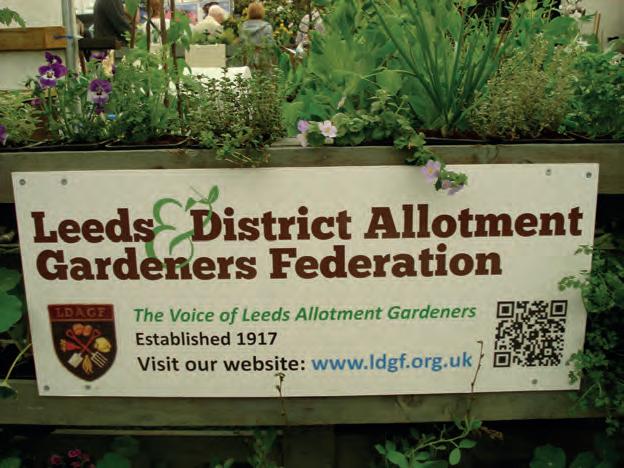

At the Harrogate Spring Flower Show held over the 4 days of Thursday 21st to Sunday 24th April, North Yorkshire/South Durham DA, Under the guidance of Chairman Adrian Read and his team, once again put on superb display, and were delighted to have been awarded a gold Medal for their efforts.
Not only is the display a good advert for the NVS, but plants sales add considerable funds to the DA coffers, at a time of the year when veg displays are a bit thin on the ground.
It’s a complicated judging /scoring process, but points are awarded for its educational value, and good signage and information about the veg on the display is a must.
Not only were vegetables represented by our DA , but the Leeds and District Allotment Gardeners Federation put on a superb display depicting a model allotment, complete with mature veg, solar panels, rainwater collection, all high tech stuff. Everything was grown and brought to the show on pallets, although looking at the display you would not know!! They were awarded a Premier Gold for their efforts, well done to Chairman Phil and his team.
 North Yorkshire/South Durham display at Harrogate Spring Show
Leeds and District Allotment Gardeners Federation display at Harrogate Spring Show
North Yorkshire/South Durham display at Harrogate Spring Show
Leeds and District Allotment Gardeners Federation display at Harrogate Spring Show
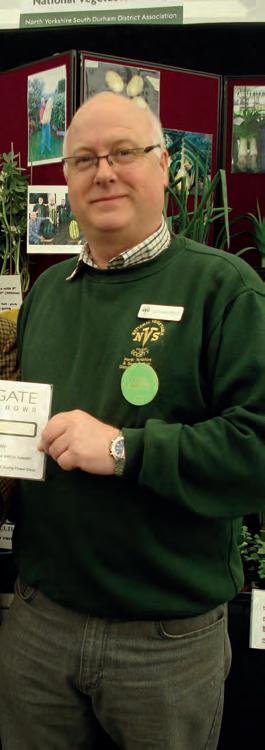
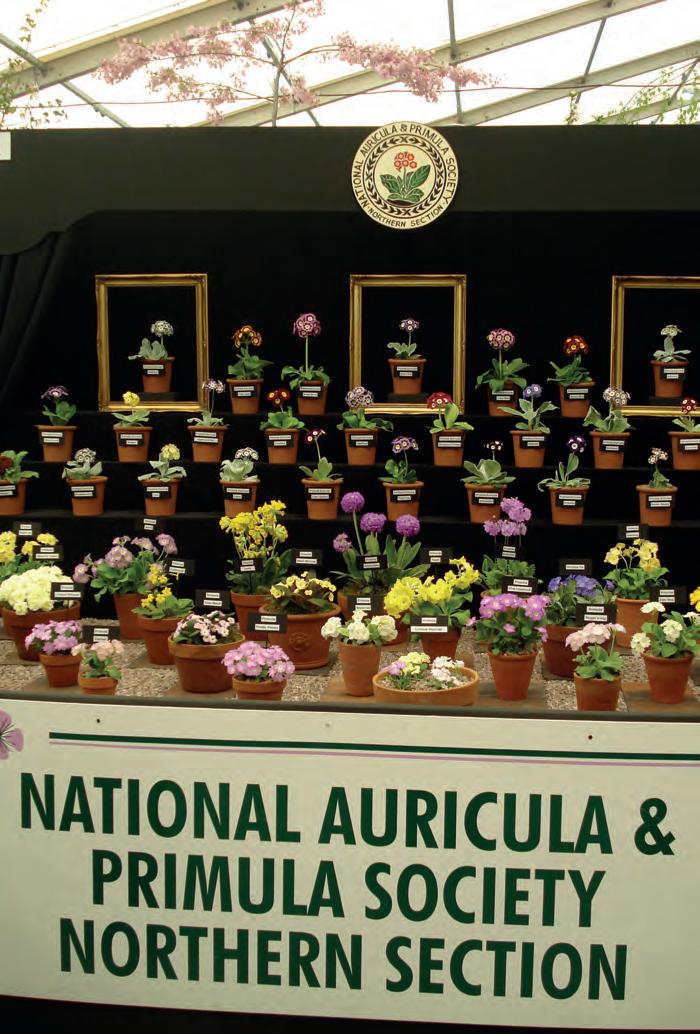
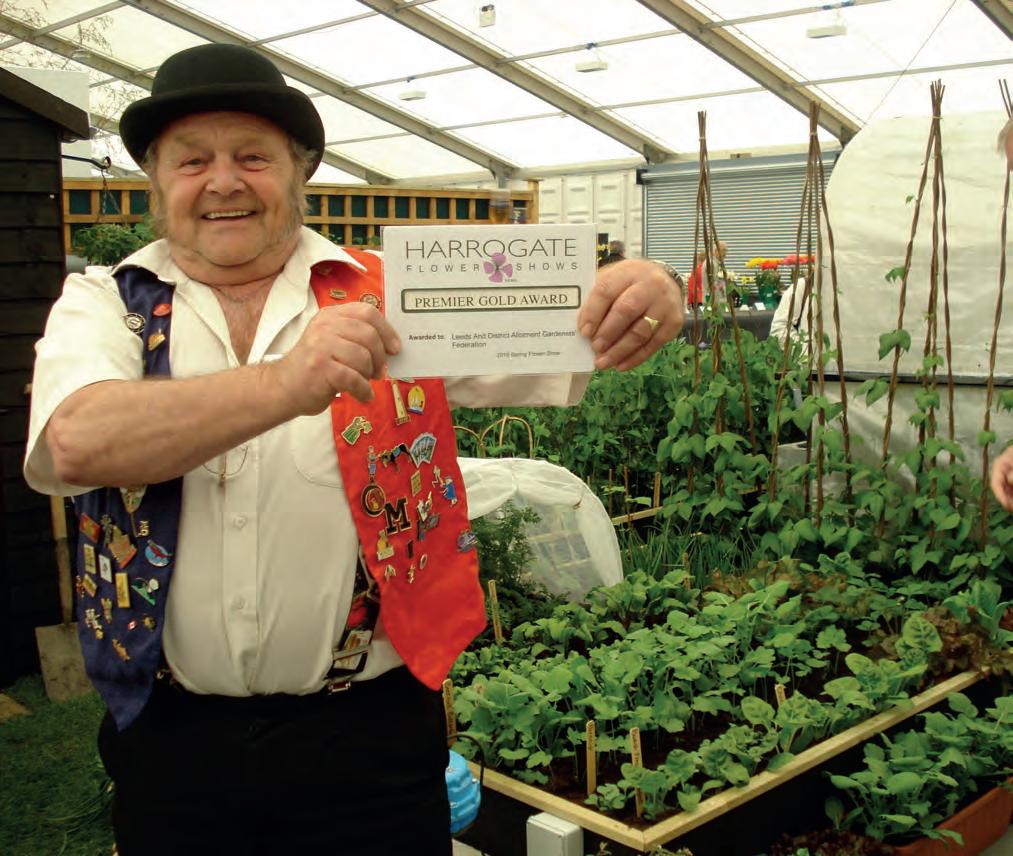

 Adrian Read, Chairman with his colleague Bill
And a very happy Phil Gomersal, Chairman of the Yorkshire Area Allotment Gardeners Federation, with his award
Being a spring Flower show, some of the stars of the show as you would expect were daffodils and Auriculas, stunning!
Adrian Read, Chairman with his colleague Bill
And a very happy Phil Gomersal, Chairman of the Yorkshire Area Allotment Gardeners Federation, with his award
Being a spring Flower show, some of the stars of the show as you would expect were daffodils and Auriculas, stunning!
At the time of writing this report, I am sat in the campervan, glass of wine in hand on the Three Counties Showground at the Malvern Spring Festival.
The Branch held its AGM back in March. It was well attended and we managed to gain a few new committee members. We were then entertained in the afternoon with an enjoyable talk from Ivor Mace. Well worth a listen to.
Following the AGM was ‘The Edible Garden Show’ (TEGS) Stoneleigh, Warwickshire, back here after two years at the Alexandra Palace, London. It was much busier than anyone thought it would be. My thanks go to the Southern Branch and Bucks DA for their loyal support yet again to help us through the three days, but a big thank you must go to Mick Poultney for doing a session every day in the lecture theatre on behalf of the NVS.
heights, gaining a silver-gilt for all their work in growing individual specimen vegetables (no room for faults) thanks guys your hard work is very much appreciated and a big ‘thank you’ must go to all members who donated their time to manning the stand at some time over the four day period.
The wedding will be attended by several NVS members as our children have grown up with the NVS
A few weeks later Mark and I went up to Beverley, Nr Hull to the North East Yorkshire DA. This is what I like about the NVS, the travelling to different parts of the country that perhaps otherwise I would not see and meeting so many people, the friendships you make etc. This is part of the NVS that is not shouted about enough.
Then here at Malvern this week my team have excelled to great
These have been awarded to;
West Midlands District Association
Annual Show – Thursday 25th August 2016. Fairfield Village Hall, Stourbridge Road, Fairfield, Bromsgrove, Worcs. B61 9LH
Awarded to the ‘Best Exhibit in Show’ For further information, contact: Mick Poultney FNVS mickypoultney@hotmail.com
Bucks District Association
Thursday 1st September 2016. Bucks County Show, Weedon Park, Nr Aylesbury Bucks. www.buckscountyshow.co.uk
Awarded to the best exhibit in the ‘Millennium Class’ For further information, contact: David Elkins, sec-nvs-bucks-da@hotmail.co.uk
Coors Gardening Club
Branston Village Show Bank Holiday Monday 29th August 2016
Branston Village Hall, Burton-on-Trent, Staffordshire. DE14 3HS
Awarded to the best dish of ‘6 Runner Beans’ For further information, contact; Mr K. Bunting. 01283 548153
Tibberton District Horticultural Society
Annual Show Saturday 20th August 2016. Taynton & Tibberton Village Hall, Tayton Lane, Taynton, Glos GL19 3AN www.tibberton-gloucestershire.org.uk
Awarded to the best dish of ‘5 Coloured Potatoes’ For further information, contact: Hylary Kingham 01452 79048 or hylary.kingham@btopenworld.com
Newent Onion Fayre
Saturday 10th September 2016
Newent Town Centre, Newent, Glos. GL18 1BZ www.newentonionfayre.net
Awarded to the best GL18 mini Collection. For further information, contact: Mike or June Davies 01531 822750 or june.davies03@btinternet.com
And when I get home from here I’ve got to get myself sorted for the second daughter’s wedding next Saturday. The suit is hung in the spare bedroom, hat in its box, shoes and handbag still to get. The car’s got to get a wash and polish ready for ribbons and the bridesmaids, the hair done, the nails done…….. and I’ve got to fit work in as well somewhere. Marks all sorted everything hired, just got to get dressed and go!!! (Typical man) The wedding will be attended by several NVS members as our children have grown up with the NVS, going to the shows with us when they were young and members have become part of our family and social scene. I will get some photos for the next magazine for you.
Then I will have time to sort the garden out and look forward to some better weather, (I hope) and a holiday before the full months of Shows ahead.
PresidentRoy Binfield, FNVS Tel: 01889 586587
ChairpersonSandra Hall, FNVS Tel: 01952 541396 noddy.crudgington@gmail.com
Vice-Chairman and Show Manager Mike Davies, FNVS Tel: 01531 822750 june.davies03@btinternet.com
SecretaryJune Davies, FNVS Tel: 01531 822750 june.davies03@btinternet.com
TreasurerJean ForresterTel: 01785 282443 forrester.jean@gmail.com
Membership Secretary/ Advisory Officer Trevor Last, FNVS Tel: 01603 868316 trevlast@tiscali.co.uk
Simply Veg/ Website Officer/ Schools Liaison Officer Mick Poultney, FNVS Tel: 07815630811 mickypoultney@hotmail.com
SponsorshipMark Hall, BEM, FNVS Tel: 01952 541396 07768 290122 mhall131313@live.com
Show SecretaryPat Brown, FNVS Tel: 01782 566395 patbrown59@uwclub.net
Cup StewardsJune Davies/ Sandra Hall As above
TrusteesSandra Hall, FNVS
John Branham, FNVS As above
Tel: 01296 681307 johnbranham@btinternet.com


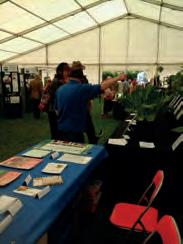
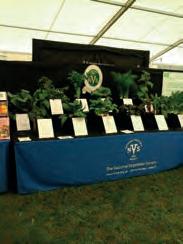
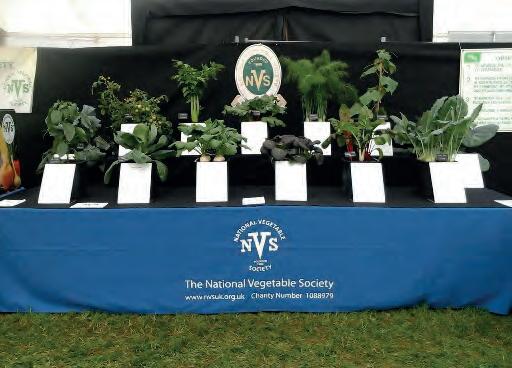
What contrasting weather conditions; torrential thunder storms, causing floods through the marquee and washing out some of the stands, to heat too unbearable to cope with. However, it did not deter a record breaking 100,000 visitors descending on the Three Counties Show Ground for another successful Spring Festival.
Our team did a wonderful display of vegetables, which some members of the public found hard to believe were actually real. Vegetables of such quality at this time of year are quite outstanding, although the judges still evaded awarding us the elusive Gold. However, Silver Gilt was still a very acceptable award, although
maybe disappointing to the growers who had painstakingly grown and nurtured the plants to provide such a wonderful display for the time of year.
Grateful thanks to those who kindly helped out on the stand over the 4 days.
As always the vegetable stand attracted a lot of interest and several new members were signed up.
We are now in the process of preparing for our main Branch Championships at Malvern on 24th and 25th September, when we look forward to greeting many of our members. Please remember to get your entries to our Show Secretary, Pat Brown, by 12th September.
June Davies, FNVS Branch Secretary

The Bucks District Association held its AGM and first talk of the season in their new venue, The Holiday Inn, Aylesbury, on March 16th. Our President, Mr Brian Butler, kicked off proceedings welcoming members and thanking them for their ongoing support in big numbers at all of our events. The officers and committee were all re-elected -
Chairman: Mr Mike Ross
Treasurer: Mr Brian Rance
Secretary: Mr David Elkins
Contact address: sec-nvs-bucks-da@hotmail.co.uk
Then John & Coral Bebbington entertained and educated us with their renowned double-act. John explained in detail how on Parish allotments he feeds his family and friends whilst securing red cards all around the country. It all starts in the well-equipped back bedroom (probably better equipped than most science labs!) where most of the vegetables are started off before being transferred to a tunnel, greenhouse or open ground. We learned a lot, like, the watering can extension (? patent applied for) - simple things make our lives so much easier. A wonderful evening’s entertainment.
Our second talk of 2016 was by Sherie Plumb, under the title ‘My garden through the year’, on the 20th April, with the hall at our new venue close to capacity. Sherie started off in November, explaining that’s when the plans are drawn up and the graft begins - and hopefully some digging too, weather permitting.
Sherie went through each of the months in turn outlining all sowing, planting and harvesting that happens during that particular month, and importantly, mentioning the variety concerned and the need for repeated sowings to ensure continuity, which in her view is just as crucial for the kitchen as it is for the show bench. It was very interesting to learn that the Plumb’s vegetable-growing is very much a family affair, with the two daughters very much involved and in fact are excellent growers in their own right. Sherie provided a fascinating insight into year-round vegetable growing which captivated our members.

Wednesday, 19th October at 7.30pm Richard White, who tells it as it is, is the Trials Manager at Tozer Seeds and will recommend which varieties are the ones we should be growing.
Wednesday, 16th November at 7.30pm Peter Glazebrook will take us through the world of giant vegetables. A journey into the unknown for many of us which promises to be full of surprises.
Both of these talks are at the Holiday Inn, Aylesbury. Do please join us: free to all NVS members.
Store your magazines away Each binder holds 12 magazines (3 years worth)
£5.00
To purchase contact; Midlands Branch, Sandra Hall, FNVS, 01952 541396 noddy.crudgington@gmail.com

As the newly elected chair of the Southern Branch I would like to start off my first chairman’s report by thanking Gordon Francis for his many years of sterling service, not only in the position I now find myself but as an active member of both the southern branch and Kent DA committees. I am very pleased that Gordon has decided to remain on the SB committee as it is nice to have access to a wise ear when you are the new kid on the block. I would also like to thank the other members of the SB committee for standing for re-election. This of course all happened at our AGM in March which was expertly hosted by Hants DA where another big thank you is due.
I travelled west last week to attend the Devon DA’s emergency meeting where they were to decide the future course of action for the DA. Having had no one come forward for the vacant post of secretary at their AGM in January and the attendance at meetings being low, posed the question about the future of the DA. However at the meeting, David Wickstead put himself forward for the secretary’s role, so with a quorate committee the decision was made to continue with the DA, and by the end of the meeting an agenda of activities for 2016 was in place. All in all well worth the drive.
By the time you read this report we will have seen off the persistent frosts and are able to start planting out some of the trays of young plants that are filling our greenhouses, poly tunnels
Chairman: Don Cockman; Treasurer: Allan Terry FNVS; Secretary: Dave Wickstead. The Devon DA held an emergency meeting on the 26th April 2016 due to no one coming forward for the position of secretary at the AGM when the Chairman and Treasurer were reinstated is these positions. The chairman welcomed Ian Clemens to the meeting. Ian had brought items to the DA for distribution at shows and display stands to publicise the NVS.
After some discussion Dave Wickstead volunteered for the position of Secretary. John Shore very kindly offered to guide Dave
We welcome 3 new contributors: new chairman, Ian, Dave Wickstead, Devon DA and Ali Clarke from Hants DA and we look forward to your future reports. Not totally new, but Marion Neden took over late last year from Brian Jefferies at Sussex DA.
I would like to join Ian in thanking Chris and Jane Neel for doing such a professional job of show secretary for over 5 years. They have improved on what was already a very good Branch show taking over from John Trim. They also did a first class job of organizing the 2014 National Championships at the Dorset County Show. It is a massive undertaking putting on one of these shows and I think after more than 5 years most people would want to free up some
and cold frames. Like my predecessor, I grow a lot of plants to raise funds for local horticultural societies and the Sussex DA so space is at a premium at this time of year. Living so far south as we do, I can only wonder how folks further north are coping with the prolonged winter night temperatures. I do hope that these conditions don’t affect the numbers of entries at this year’s shows but exhibitors are a resilient breed and always seem to find a way to fill the show bench.
And on that topic, our next major event is the Branch Championships, held at the New Forest Show, July, 26-28th. Prize giving will be in the White Rabbit pub on the evening of the 26th and all are welcome to join in with the proceedings. This will be the last time that Chris and Jane Neel organise the show and I would like to take this opportunity to thank them both for all their efforts over the years in making this important event go smoothly. These will be difficult shoes to fill but if anyone is interested in taking on the challenge then please let me know.
As I finish typing this report in May I see that tonight’s local night time low is 2 degrees which where we live means a high chance of ground frost, so it’s out with the fleece and on with the heater for another night at least. Happy gardening and if you are showing at any events this year, may your mantelpiece be supporting silverware come autumn.
Ian Clemens, Southern Branch Chairman
into this new position with any help that was required. It was also discussed about some of the duties of the secretary being taken up by other members of the DA due to the distance away that Dave lives from Kingskerswell, this will be discussed at the October meeting.
It was agreed that there would not be a July meeting but there would be an open garden meeting at Dave’s house (23rd July 2.00pm), this would also take in his newly acquired allotment. (anyone volunteering to do some digging will be most welcome) The address is Rosemary, Raymond Way,
Colebrook, Plympton, Plymouth PL7 4EG (If you require directions please ring Dave on 01752 319435).
It was proposed that trips would be arranged to the Southern Championships at the New Forest July 26th to 28th, National Championships at the National Botanic Garden of Wales Sept 10 to11th and the Malvern Autumn Show 26 to 27th Sept.
It was a agreed that at the 26th October meeting we would have a mini show to displays members produce, below are the categories for the show.
Vegetable section
1. A dish of 5 potatoes white.
2. A dish of 5 potatoes coloured.
3. 3 Onions 250g or less.
4. 3 Onions Large Exhibition
5. 3 Carrots Stump Rooted
of their time and take a break.
Thank you to Ted Perren and his team at Hants DA for putting on such a good lunch and seminar at the Branch AGM. There were two very good talks both of which I enjoyed and learnt a number of good tips. Nice touch having a top grower of dahlias speaking. My favourite flower, but I still can’t grow them to exhibition standard (bit like veg!).
Our next major event is the Branch Championships at the New Forest and Hampshire County Show, July 26th to 28th. Chris and Jane Neel with Hants DA will put on an excellent show and I look forward to seeing many of you there.
Peter Cranfield FNVS, Newsletter Editor
6. 1 Cauliflower
7. 1 Cabbage
8. 9 Shallots any variety
9. 4 Tomatoes
10. 2 Leeks Blanch & Intermediate
Flower Section
1. 3 Dahlias of one kind
2. 1 Dahlia Specimen Bloom
3. 3 Chrysanthemums of one kind
4. 1 Chrysanthemums Specimen Bloom
5. Pot plant in flower (any size pot)
6. Tray of 6 Fuchsias any cultivar or species may be displayed on tray or floating in bowl.
Please note entrants must supply their own plates, trays, vase or bowls. Please stage from 7.00pm
Any queries please contact Dave Wickstead on 01752 319435.
Chairman: Sherie Plumb FNVS; Vice Chairman: Peter Cranfield FNVS; Secretary: Pat Eves FNVS; Treasurer: Emily Plumb FNVS.
Since the April issue of the Simply Veg magazine, the Essex DA has had two more extremely informative talks: one from Dr Ian Bedford and the other from Gerry Edwards.
The talk by Dr Ian Bedford on 20 March 2016 was on “Bugs: cohabit, control or conserve?” As Head of Entomology at the John Innes Centre, Ian gave us an excellent insight into all sorts of bugs we may find in our gardens and whether we should treat them as friends or foes!
Ian also told us about some of the current research which is going on at the John Innes Centre which keeps him busy during the week as well as his discovery of the notorious Spanish slug a number of years ago (whilst in his own garden)!

and Pears in the garden or allotment”. Once again, we all thoroughly enjoyed the talk and went away with lots of ideas for our own plots! Gerry took us through the entire lifecycle of apples and pears from choosing cultivars/grafting to planting, pruning, and maintaining your fruit trees.
Ian gave us an excellent insight into all sorts of bugs
Gerry also gave us some invaluable advice on good cultivars of apples and pears to try for different types of plots and grower’s needs.
venue, Hatfield Peverel Village Hall. If you would like any further information about the Essex DA or any of our events please contact Emily on emily.plumb@ btinternet.com or 01621 741787. We look forward to seeing you at some of our meetings throughout the year!
Gerry Edwards then came and gave us a talk on 24 April 2016 on “Growing Apples
Our next meeting will be our DA mini show on Sunday 17 July 2016. All entries are welcome whether NVS members or nonmembers. Our show will be held at our usual
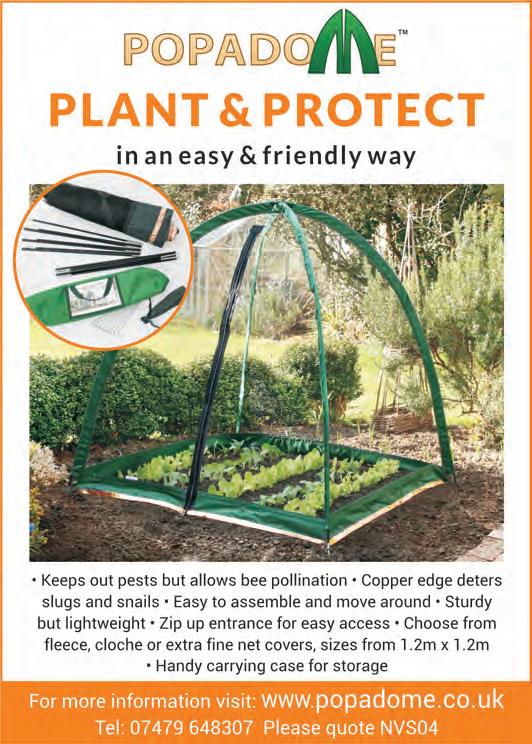
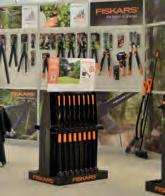


If any member is interested in starting up the DA again, please contact Dennis Hewitson: hewitson883@btinternet.com
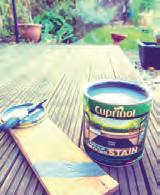




Chairman: Ted Perren FNVS; Secretary: Vacant; Treasurer: Ann Brown FNVS
It has been an eventful and busy time for NVS Hants DA. We were happy to host the Southern Branch AGM in March and to welcome all who attended. The Hants DA Seminar on the same day was well supported with attendance up on previous years. The diverse topics of ‘Dahlias’ by Bryan Madders and ‘Judging Vegetables for Show’ by Graham Wagstaffe proved very popular and despite our mutual passion for veg, the flower topics are always a big draw and pull in new visitors who wouldn’t normally attend.
In April, Simply Vegetables National Magazine Editor Kelvin Mason gave us a highly educational talk on Plant Nutrition and we all came away having learnt something new.
Our annual Plant Sale in May was incredibly successful. The sheer variety of plants we have on sale is always inspirational and we are indebted to all those dedicated growers who give so generously of their time and resources to support the event, as well as those who come to buy! We have some very loyal supporters amongst our customers including Ann who comes every year and fills her wheel barrow and this year we drew new customers from as far afield as North Yorkshire and Cornwall.
The plant sale is a really important event in our calendar and not only generates valuable funds for the society, but is a great occasion to promote the NVS, help people get ahead in the garden, give advice on growing and meet up with old pals.
Many thanks also to those who regularly make cakes and refreshments for all our events and for any donated raffle prizes which are always gratefully received. If anyone received a proper plate with their raffle cake at the seminar in March, Ali would love it back as her dinner service is currently 1 plate short.
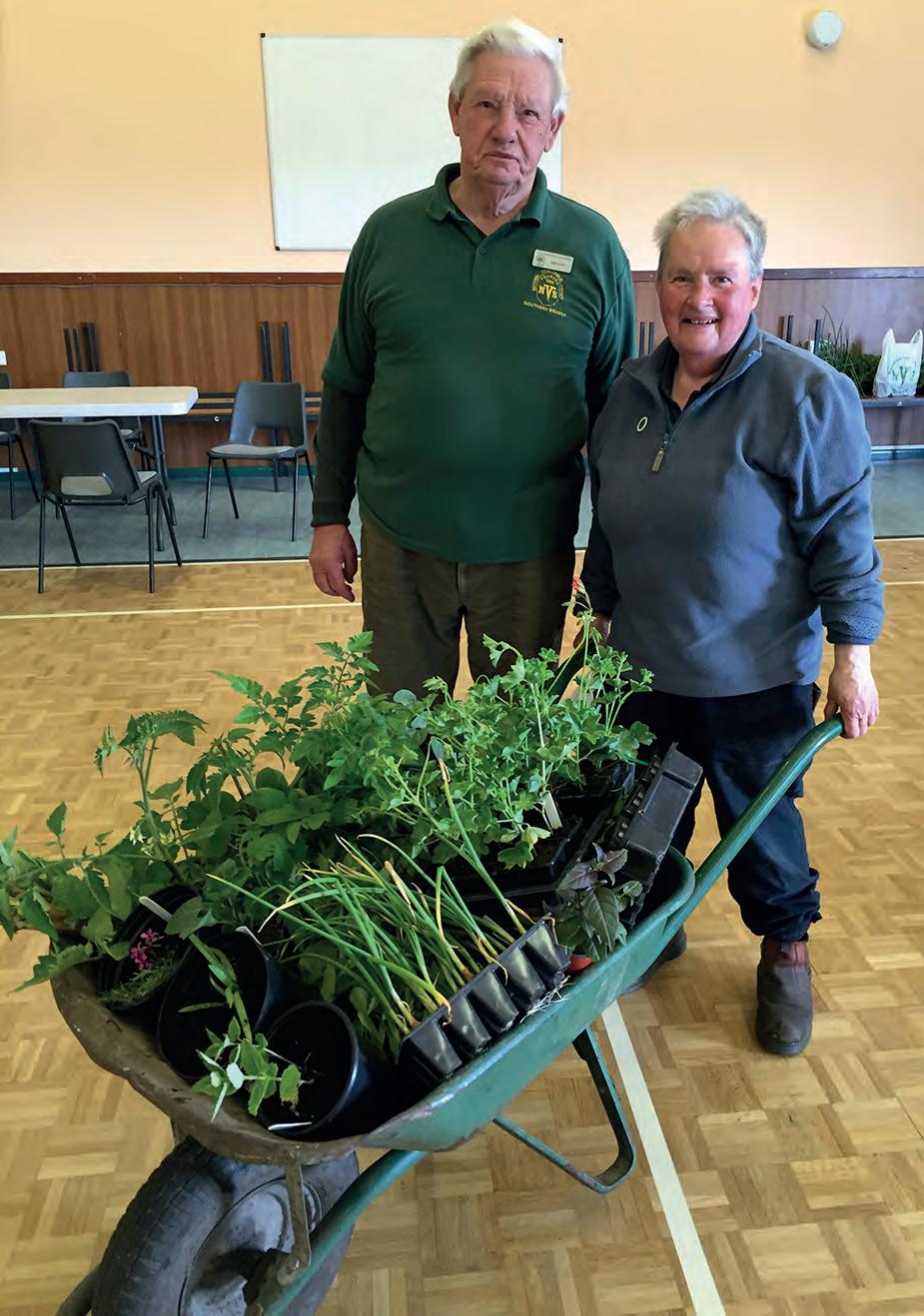
When this magazine pops through your letter box we will very much be looking forward to the NVS Southern Branch Show held over 3 days at the New Forest Show 26-28 July. Good luck to all who enter.
The Hants DA committee currently has a vacancy for Secretary; if anyone is interested in the role, please contact Ted Perren eperren@ btinternet.com
11 Sept Hants DA show 11 October Talk by Ray Broughton on Greenhouses & Vegetables. 8 Nov Talk by Mark Read on Leeks.
We meet at Wellow Village Hall, Buttons Lane, West Wellow, Romsey, Hants SO51 6BR.
The Hants DA programme of events is available on the NVS website: www.nvsuk.org.uk
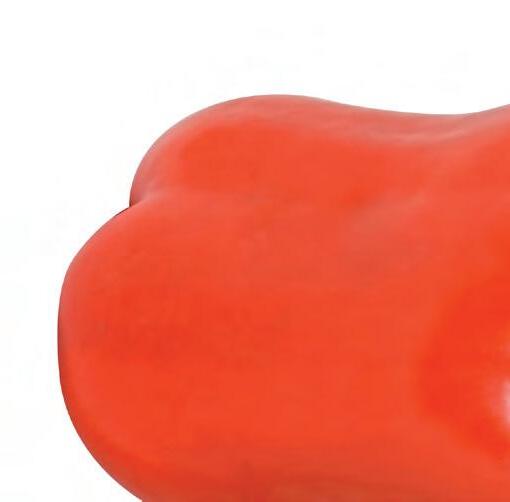


Chairman: Roger Simmons; Secretary and Treasurer: Gordon Francis FNVS
A good start to the year, the AGM went well with more attending than other years, this possibly because we had a speaker this year. Graham and Jane Wagstaff came to the April meeting with their way of growing parsnips, May 8/9th we held our annual plant sale at the Medway Horticultural Festival, this is one of our main sources of income and it went very well.
We have no meeting in July but we are at the Kent County Show at Detling on the 8th, 9th and 10th with our first stand of the year this is with the Kent Federation of Horticultural Societies, we look forward to seeing you there, so come along and say hello.
August 10th our speaker is Hilary Newman (M.Hort RHS) with a talk on Plant Problems and Solutions.
August Bank Holiday weekend we are at
September 14th Sabatino Urso from RHS Wisley is the speaker for our monthly meeting with a talk ‘’Italian Gardens’’.
Our full year programme is on the NVS web site and the Kent Federation web site. More details are available from the secretary Gordon J Francis FNVS on 01622 710486 or email gordonjfrancis@googlemail. com or off of the NVS Web Site. (Everybody Welcome)
Chairman: Graeme Le Marquand FNVS, 07797 727216 or glem@ hotmail.co.uk; deputy chairman: Steve Vibert; secretary: Mrs Zoe Vibert
Articles by Collette Bisson, Jersey DA, appear regularly in SV.
Chairman: vacant Joint vice chairman: Neil Hope FNVS and Patricia Barrett FNVS; Secretary: Sally Coleman; Joint Treasurers: Patricia Barrett FNVS and Derek Learwood.
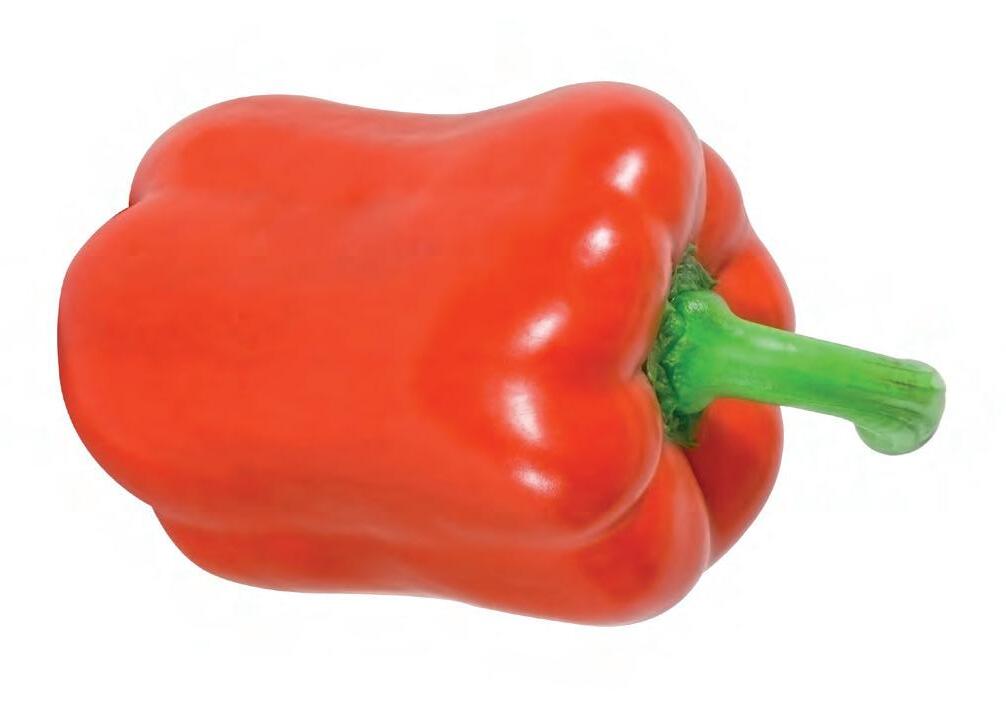
Tuesday 19th July 2016 we will meet at 5.45pm for a 6pm start at Tangmere Airfield Nurseries, The Old Airfield, City Fields Way, Tangmere, Chichester, West Sussex PO20 2FT, a commercial pepper growing nursery sited on the former ‘Battle of Britain’ airfield. A talk will be followed by a tour of the nursery. There are very few steps on the nursery at Tangmere, so disabled visitors will also have access. There is no charge to NVS members, but you do need to book your place, (see my contact details below)
DIRECTIONS: From M27 / A27 Eastbound: Leave the M27 north of Portsmouth and join the A27 eastbound toward Chichester and Brighton. Remain on the A27 for 16 miles until the roundabout junction at Boxgrove / Tangmere. Take the third exit onto Meadow Way. Turn left onto City Fields Way. Follow signs for Tangmere Airfield Nurseries. The entrance to the Nurseries is located at the end of the road.
From Brighton / A27 Westbound: Join
space in the next issue of SV to see how we
the A27 westbound at the Patcham junction with the A23, north of Brighton. Remain on the A27 for 29 miles passing north of Shoreham-by-Sea and Worthing and through Arundel. At the roundabout juntion at Boxgrove / Tangmere take the first exit onto Meadow Way. Turn left onto City Fields Way. Follow signs for Tangmere Airfield Nurseries. The entrance to the Nurseries is located at the end of the road.
Nearest Station: Chichester (approx. 6 miles).
Thursday 8th September 2016 at 8pm in the Lovelace Room, East Horsley Village Hall - Garden Designer Elizabeth Mason, will give us a talk entitled ‘Glorious Gardens and their Fruit and Vegetables’.
Thursday 10th November 2016 at 8pm in the Lovelace Room, East Horsley Village Hall - Fruit Expert Gerry Edwards, will be joining us for an informative talk about ‘Growing Apples And Pears In The Garden’.
email is beth@otway.com or you can telephone me on 01483 420989. Beth Otway FNVS, Programme and Visits Secretary NVS Surrey DA
Jeffries FNVS, Secretary: Marion Neden
Our meeting in May was held at a new venue - The Bull in Henfield, where we were given a very enjoyable and informative talk by David Thornton FNVS on “Growing Better Vegetables”. In an attempt to attract attendees from the distant corners of both East and West Sussex, we experimented with a more central location. This proved to be a successful trial with about 28 members and also some new faces, so we are looking to hosting some future events at more accessible locations for our membership across the two counties.

Once again we are supporting the South of England Show, June 9-11th. In addition to the usual plant sales stall, we are competing in the exhibition stand classes. A group of DA members have been assigned specific items to grow for the display, so a real team effort.
A huge thank you to all the members who have helped and also to those who have grown plants to sell on the stand. Watch this
July 12th is our annual outing into the world of horticulture. This year we are visiting the trial grounds of Tozer seeds in Cobham, where you can see how new F1 hybrids are created and understand the length that producers go to in order to supply growers with quality seed. This trip is open to all so if you are interested in joining us on the day please contact Marion Neden for more details (marionneden@btinternet.com or 07702 020682).
Coming up: September 7th will be our mini show where the DA growers will be
displaying the product of this year’s season in a fun and informative evening. This event also gives those taking the judges exam in October a chance to put their skills to the test under the tutorage of our resident experts.
Congratulations to Sussex DA for winning a large gold medal for their stand at the South of England Show.
This is now planned to be held in Hythe, Hants. The seminar to be held on the Sept 30th and the Exam on Oct 1st. Any new Candidates, or those who wish to re-sit either the Theory or Practical, please contact Ian Clemens on 01403 751676 email ianclemens@tiscali.co.uk as soon as possible.
It has been a difficult 18 months for the Welsh Branch with the loss of our Chairman, Secretary and long-time committee member.
Margaret Henderson had to give up the Secretary’s work due to ill health in November 2014, resulting in Colin Lewis our Chairman taking up the duties.
At this time Jim Thompson (Treasurer) Margaret’s partner also relinquished his duties for a time to help Margaret. Colin and I did our best at the time to keep things going.
On the eve of our Branch Championships at the National Botanic Gardens of Wales Colin passed away after a very short illness. This meant that I as Vice-Chairman took on the Chairman, Secretary and Show Secretary responsibilities.
I am pleased to report that the show was a big success and must thank the committee members and other helpers for their hard work.
Margaret passed away later on in the year and is sadly missed by all.
At this time things looked bleak for the Welsh Branch, we were now looking for a Chairman, Secretary, and Show Secretary.
At our A.G.M. in March of this year things look up, I was elected as Chairman with Huw Jones stepping up as Vice Chairman. Sarah Phillips was elected as Secretary and Maria Phillips as Assistant Secretary. (both of which are new N.V.S. Members). Most of the committee were also re-elected.
Things were now looking up for the Branch, and a successful 3 days was held at the R.H.S. show at Cardiff. We are also planning to put up a display of veg at the Royal Welsh Show this year.
More bad news came our way after the Cardiff Show was the sad loss of Mel Saunders, another hard working committee member.
The Branch Championships will this year be held at St. Fagans Cardiff and all arrangements are going to plan.
We are also his year hosting the National Championships ay National Botanic Gardens of Wales, and we are looking forward to meet some old and new friends.
Arwyn Edwards (Branch Chairman)
The Gwent District Association is sponsoring classes at local shows in Gwent. It’s hoped that this will encourage growers to support their local show, introduce them to the National Vegetable Society and to the Gwent DA. Here are the shows and dates:-
Brecon Agricultural Show 6th Aug 2016 5 White Potatoes
Blaenavon Horticultural Society 3rd Sept 2016 5 White Potatoes
Pontypool Chrysanthemum & Dahlia Society 7th Sept 2016 5 Tomatoes
Swffryd Gardening Club 3rd Sept 2016 5 Red Tomatoes (Members Only)
The 2016 National Show is being hosted by the Welsh Branch at the National Botanic Garden of Wales, Llanathne, Carmarthenshire. SA32 8HN. The date is Saturday 10th and Sunday 11th September. As at our branch championship last year, entry will be via the back entrance by following the signs from the front entrance. There are 3 covered entrances to the Great Glasshouse and a handy free car park there too. There are restaurant facilities nearby at the gardens and a café in the Great Glasshouse. The Great Glasshouse has excellent ventilation so our vegetables should stay fresh. The botanic garden alone is worth a visit so come down and see both the garden and National show. All members are welcome and it is a chance to see some of the best vegetables grown in the world and one of the newest botanic gardens, not to mention visit the beautiful country of Wales.
Places to stay in Carmarthen.
Carmarthen is approximately 8 miles from the Botanic Garden. The evening function will be held within walking distance of these hotels.
BOARS HEAD HOTEL 01267222789
Double room B&B from £65
FALCON HOTEL 01267 234959/237152 Double room B&B from £80
SPILMAN HOTEL 01267237037 B&B Double room from £75
There is a Travelodge at Cross Hands which is 4 miles east of the Botanic Gardens and about 12miles East of Carmarthen via the A48 dual carriageway.
A Social evening will be held at Carmarthen Quins RFC Club on the Saturday evening. Information on the show can be had from Arwyn Edwards details on page 3.
A reminder that the 2016 Welsh Branch show will be held on Sunday 28th and Monday 29th August at St Fagans Natural History Museum Cardiff CF5 6XB. Entry to the museum is free but parking costs £4. A free parking pass will be issued to all NVS exhibitors. Schedules from Arwyn Edwards. St Fagans is located off the A4232 duel carriageway. There is a slip road directly off the A4232. The A4232 comes directly off Junction 33 of the M4 west of Cardiff. This is by far the easiest way to access the museum as Cardiff is a busy city. There are brown tourist signs for the museum off the M4.
We have lost a good friend and committee member of the Welsh Branch, Mel Saunders. Mel battled with Leukaemia in 2000, and after given the all clear, Mel had 16 years of good health. Mel’s allotment was a treat to visit. It was picture book, and could have made the front cover of any magazine. Mel gave talks on practical vegetable growing that everyone enjoyed. He judged at many shows in the south Wales area and also the
Welsh Championships on many occasions. He represented the Welsh Branch judging at the National. At the end of last year the leukaemia returned, and Mel passed away on 20th April 2016, He was cremated at Coychurch Crematorium on 4th May 2016. The service was attended by friends and family and very many National Vegetable Society Members. Our thoughts go out to his wife Maureen and family.
Social Evening.
A social evening and buffet will be held at Glamorgan Wanderers RFC Clubhouse, Memorial Ground, Stirling Rd, Cardiff CF5 4SR Phone: 029 2059 1039. 1.2 miles from the museum and 1.1 miles from the Copthorne Hotel.
Details of accommodation are in the April issue of Simply Vegetables.
We are looking forward to meeting all exhibitors and visitors at the show, it wil be a good chance to catch and discuss how the showing season has gone.
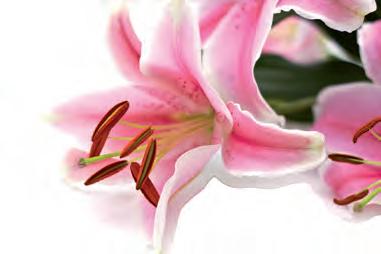
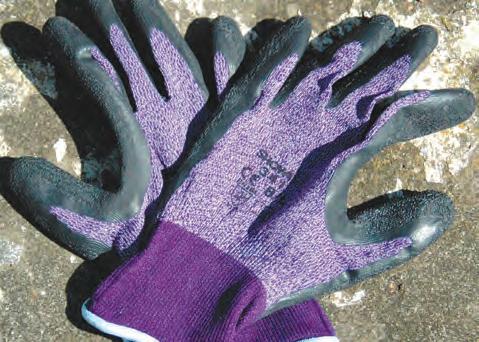
These Advanced Grip gloves boast great quality. Along with being comfortable they are durable and breathable. New to Kings these seamless, lightweight Nylon/ Polyester gloves are all need in an outdoor gardening glove. The latex palm coating is designed for a secure wet or dry grip. Tel: 01376 570 000 www.kingsseeds.com
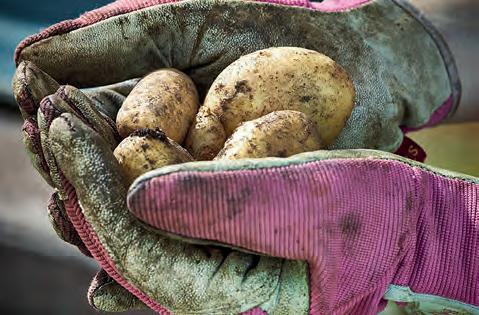
For planting the plot, grappling with the garden to the satisfying sowing of seeds – we’ve the glove for you. Much loved and trusted designs with sizes from small to extra large. Available in all good DIY and garden centres nationwide, or online. www.briersltd.co.uk
The UK’s best selling gardening glove with one pair sold every minute.
It offers protection against thorns and other sharp objects and has an excellent grip in both wet and dry conditions. The outstanding fit and knitted wrist means there is no loss of dexterity or comfort.
Available in 4 different colours - £5.99
For enquiries email andrea.litchfield@townandco.com www.townandco.com
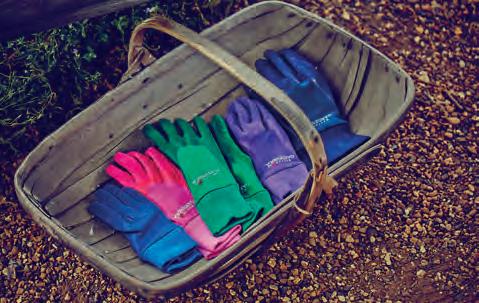
Women’s Bionic ReliefGrip Garden Gloves offer enhanced comfort, fit and performance.
Made from premium washable goatskin they have an anatomic pad system for more gripping power plus silicone finger tips for extra durability and protection. Men’s Bionic Tough Pro Gloves also available. Highly recommended. Quote NVS10 for 10% discount. Call 01462 421836 or email info@gardendivas.co.uk www.gardendivas.co.uk










� Seven colours
� The largest range of wheel barrows 85L - 200L capacity
� Pneumatic and puncture free wheels
� Garden accessories available such as Garden Scoots, Trestles, Buckets, Flexi tubs, Leaf carts, Seed trays


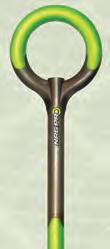
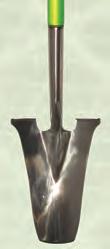






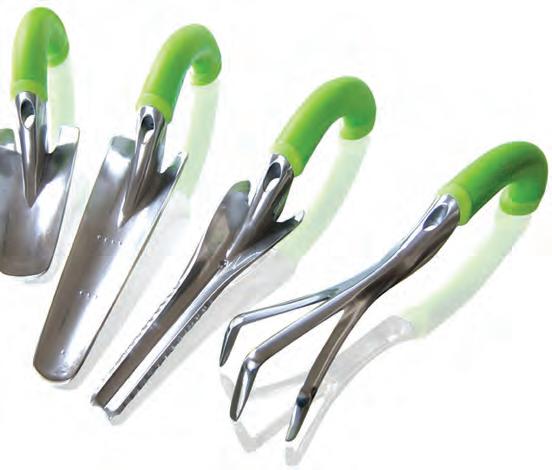







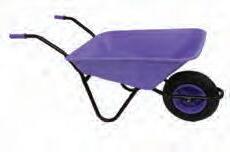







� Our range of garden tools are lightweight, strong and comfortable � Natural radius grip creates more leverage � Aluminium blades are light yet strong Brilliant Garden Products Brilliant Garden Products

